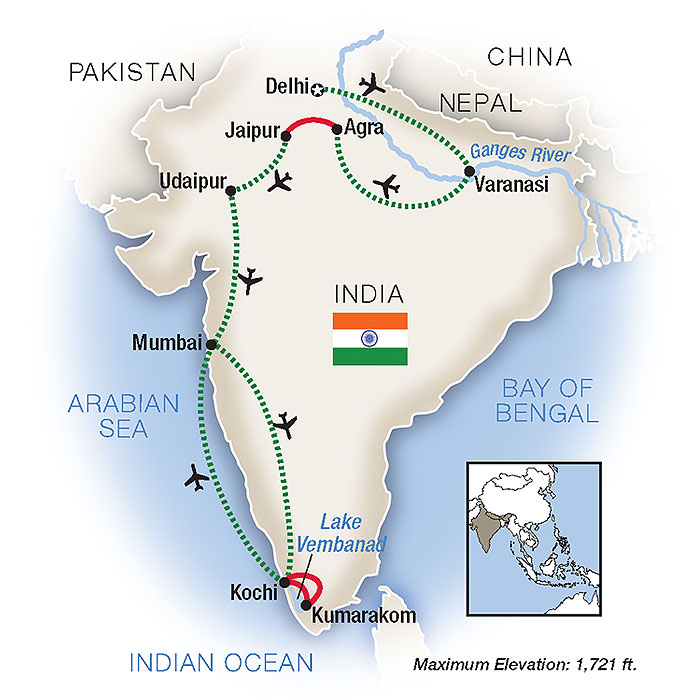
A Portrait of India
October 20 - November 6, 2024
Mike and Judy Henderson
I will leave this map on the top of this page just for reference.

++++++++++++++++++++++++++++++++++++++++++++++
11/3/2024 (Sunday, to Mumbai) Today is a travel day. We take the bus from Kumarakom to the Kochi airport, where we fly to Mumbai (formerly Bombay, changed 1995) .
We left the resort at 8:30am. Some of the staff was there to wave goodbye, but I missed the picture.
Sitting in an aisle seat made photography difficult, but I did get a few. Judy was sitting by the window, took a lot of pictures, and AirDropped themto me. AirDrop is a really nice iPhone function, and with the new update you can just put two iPhones together, head-to-head, and do the AirDrop.
The area of Kerala (where Kumarakom is located) elected a communist party back in 1957 and it's still very active in politics today.
As we traveled to Kochi there were many, many red hammer and sickle flags along the road. Picture taken through the front window of the bus.
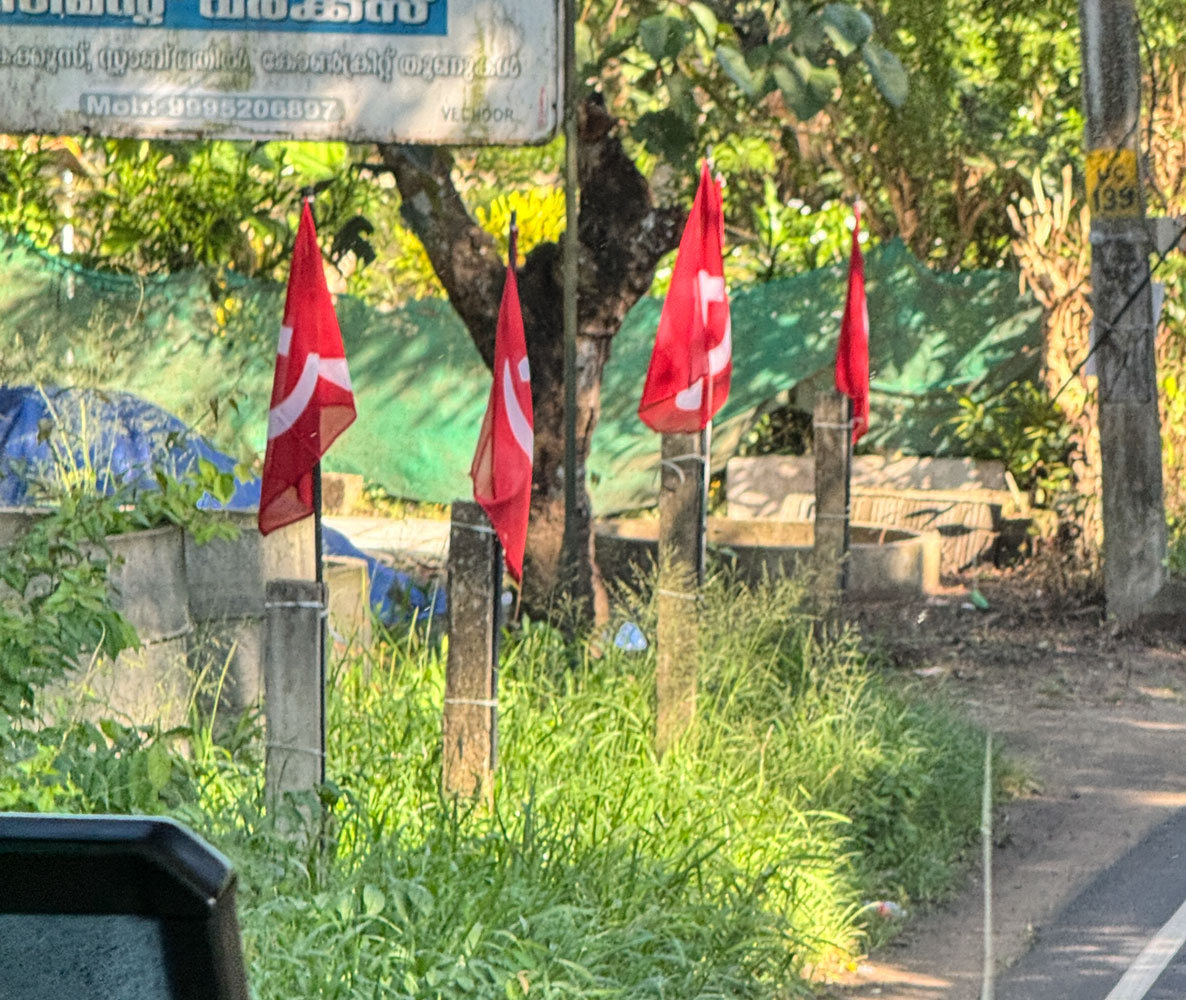
We arrived at the Kochi airport about 11am. It was a two and a half hour bus ride.

Annie got our boarding passes and arranged access to the Earth Lounge, where we had snacks.
About 12:30pm we went down to the gate area. The Kochi airport has some very nice, but unusual, chairs in the gate waiting area. Its a new airport, and features the products of local artisans when possible.
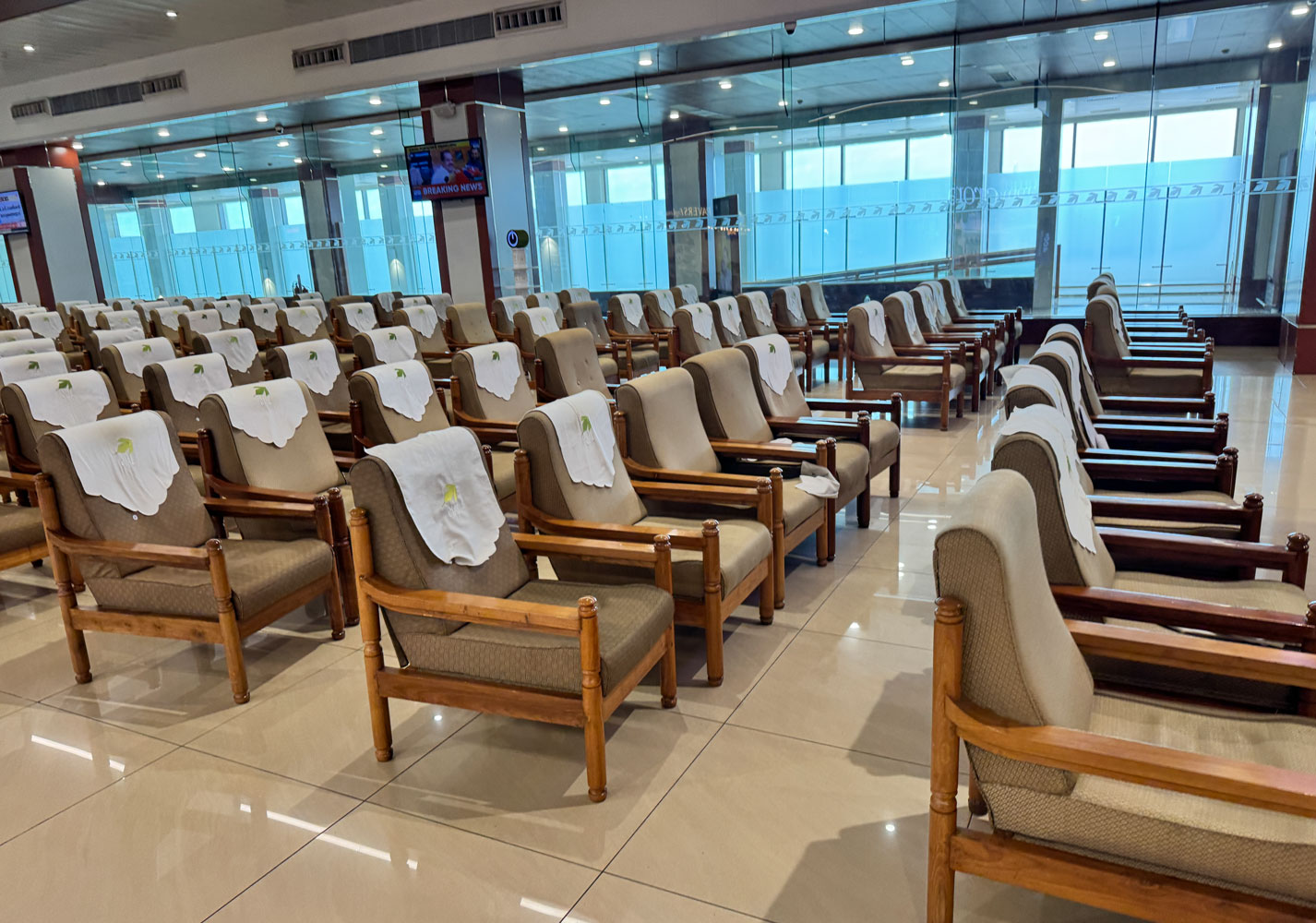
About 1pm we boarded the Airbus A321 for Mumbai. It was almost 4pm when we arrived in Mumbai. It's a nice airport and the one we will leave from on November 6th when the tour is finished.
It took a little while for our duffel bags to show up on the carrousel, but once they did we went to the bus for the ride to the Mumbai hotel.
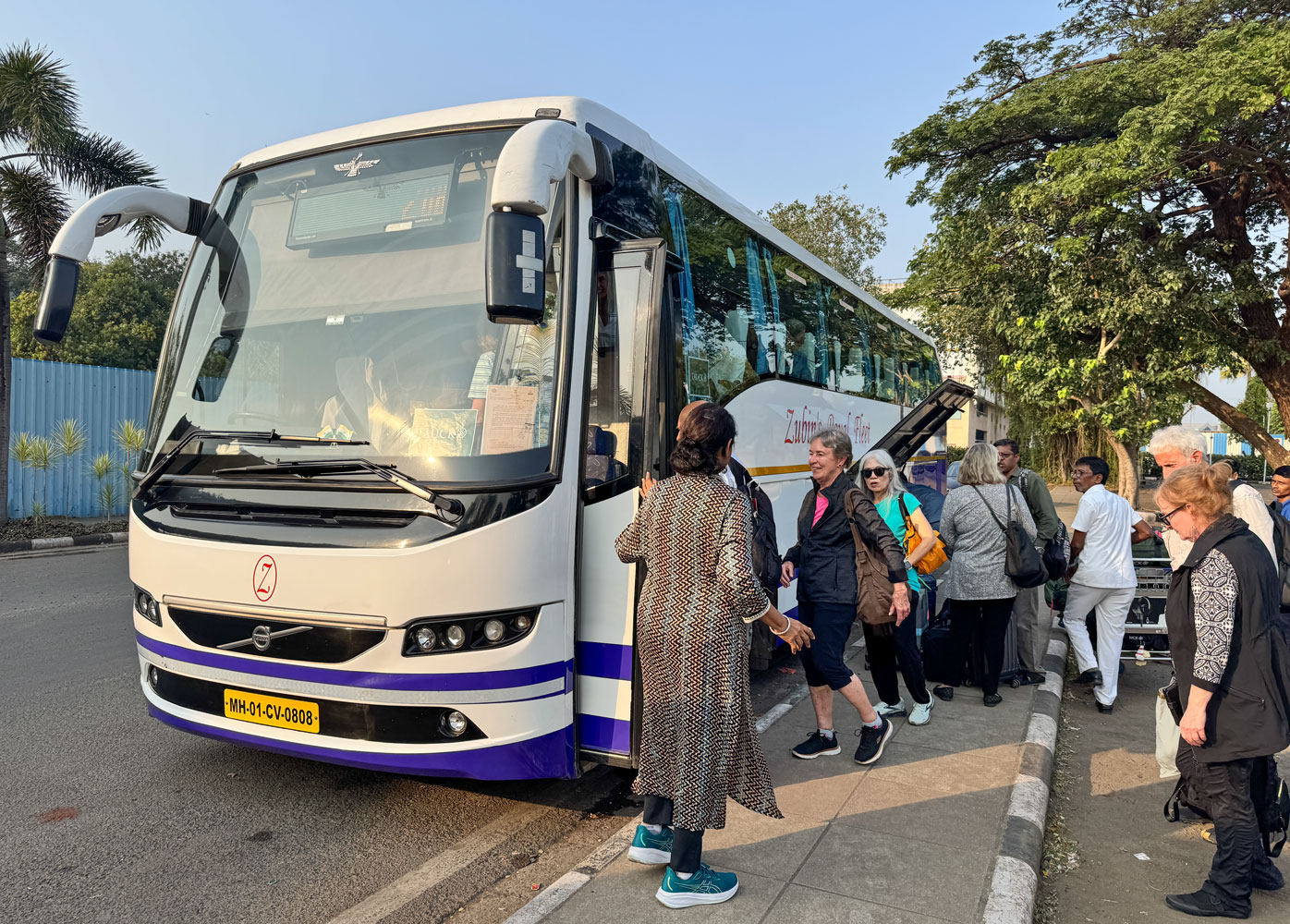
On the ride into Mumbai we saw some slums - first ones I've seen in India.
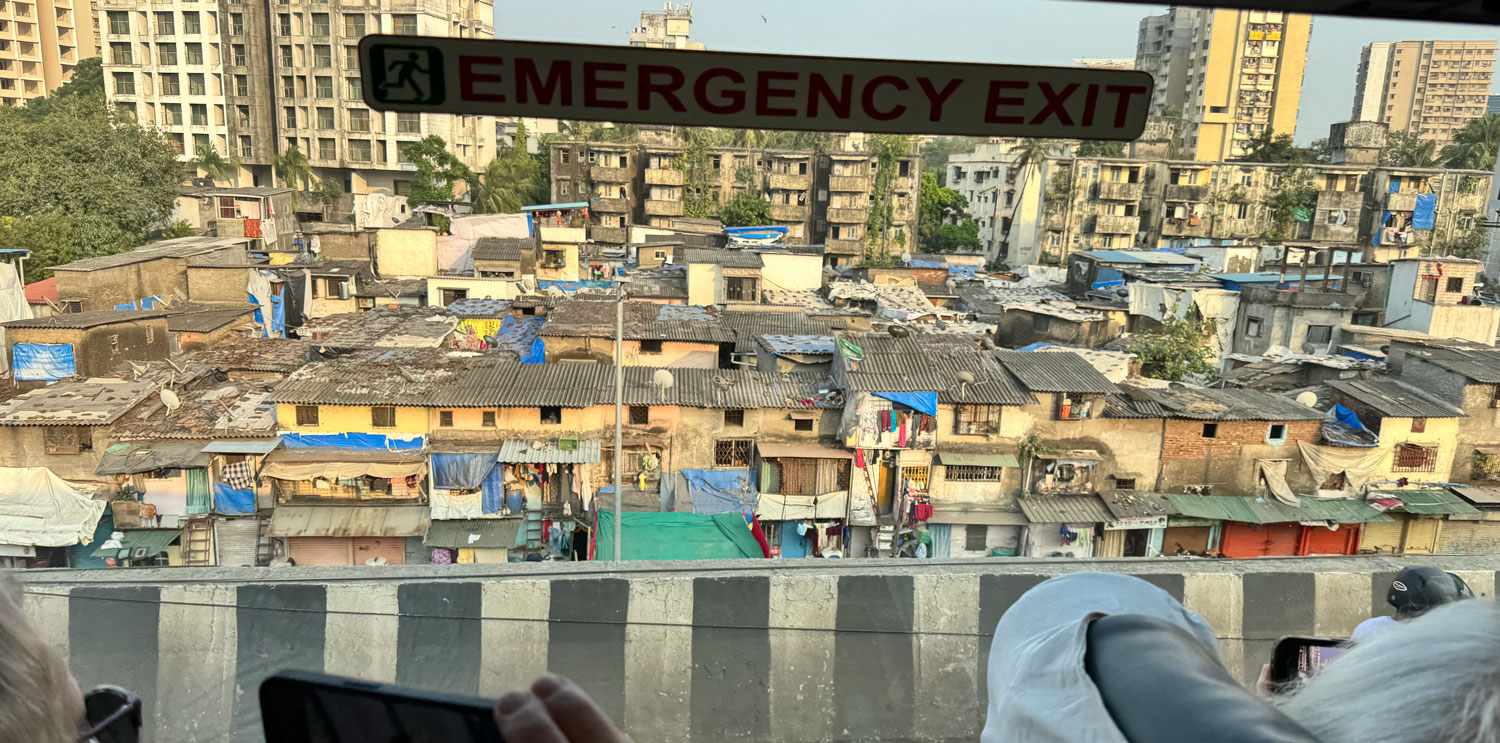
Mumbai has a large slum area, called Dharavi, and there's an excursion to it tomorrow.
Here's another picture of a slum area, a bit later in our drive.
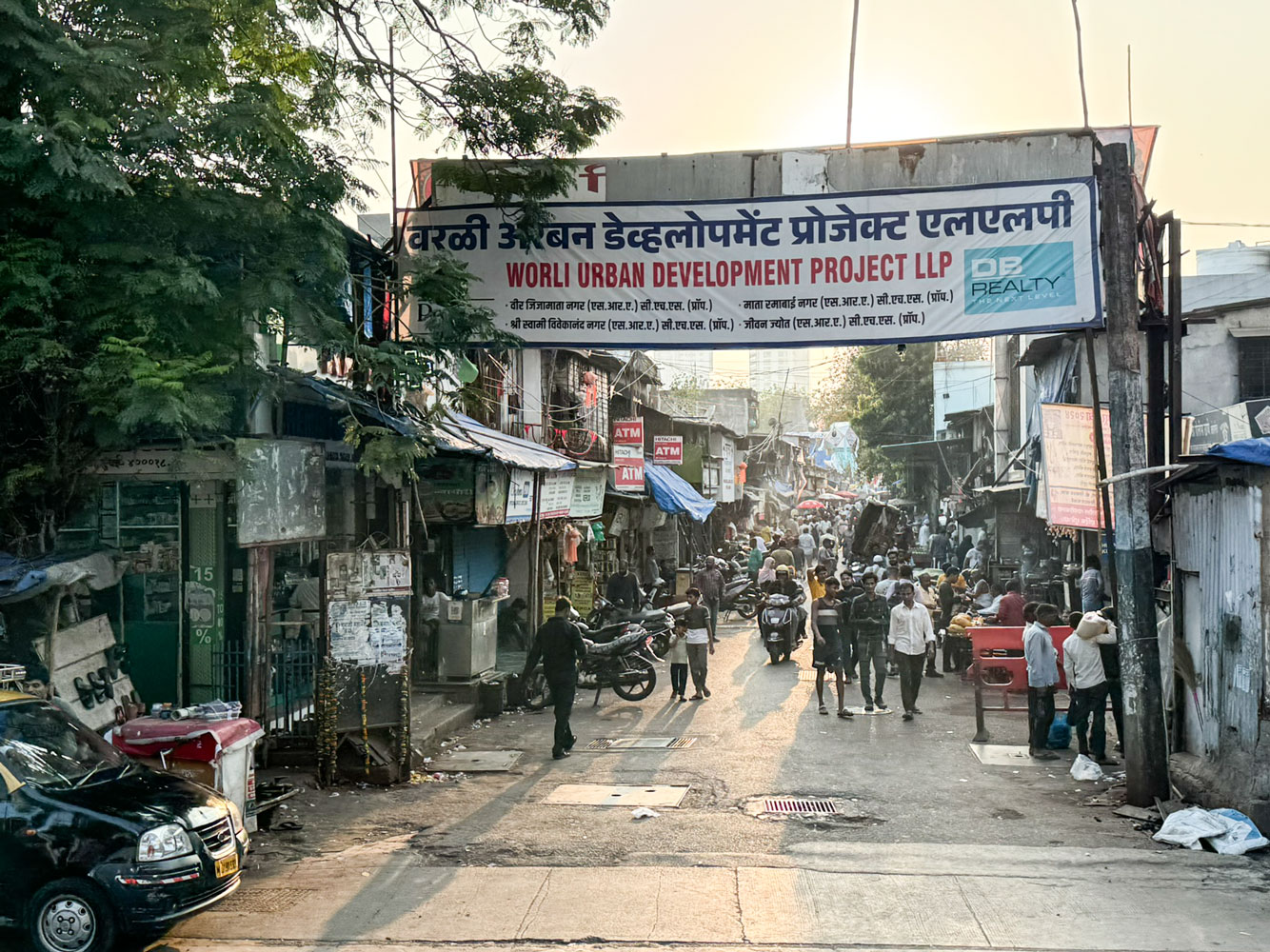
On the way to the hotel, we drove over the Bandra-Worli Sea Link Bridge, also known as the Rajiv Gandhi Sea Link Bridge. It's a 5.6km cable-stayed bridge. Photo from the web.

You can see where the bridge is from this map. The approximate location of our hotel, the Oberoi Mumbai is at the tip of the arrow.
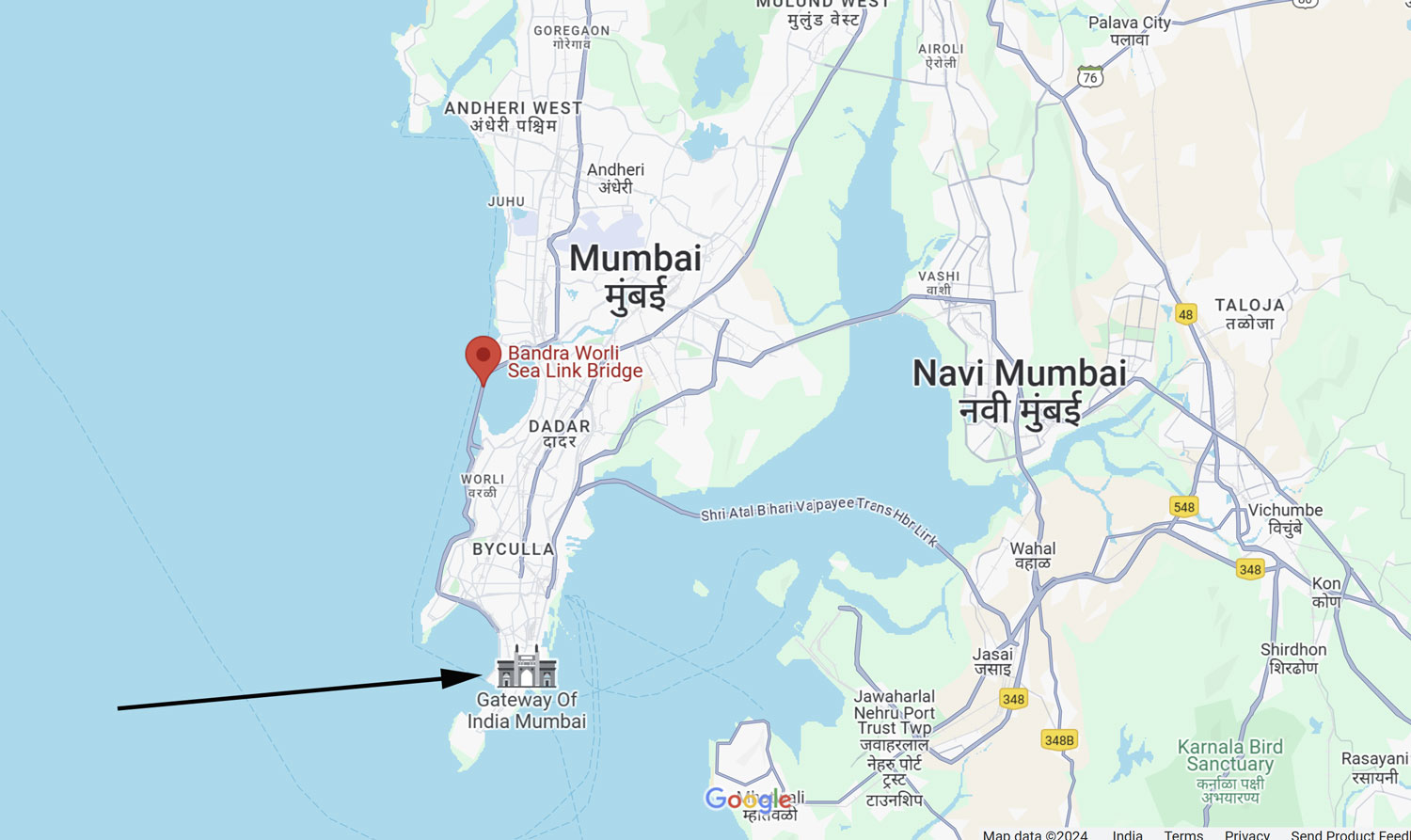
After we crossed the bridge we drove to the Dhobi Ghat, the municipal laundry in Mumbai. It was constructed in 1890. There are over 700 wash pens and they wash approximately 100,000 pieces of clothing each day.
Here's a picture from the web that shows the wash pens.
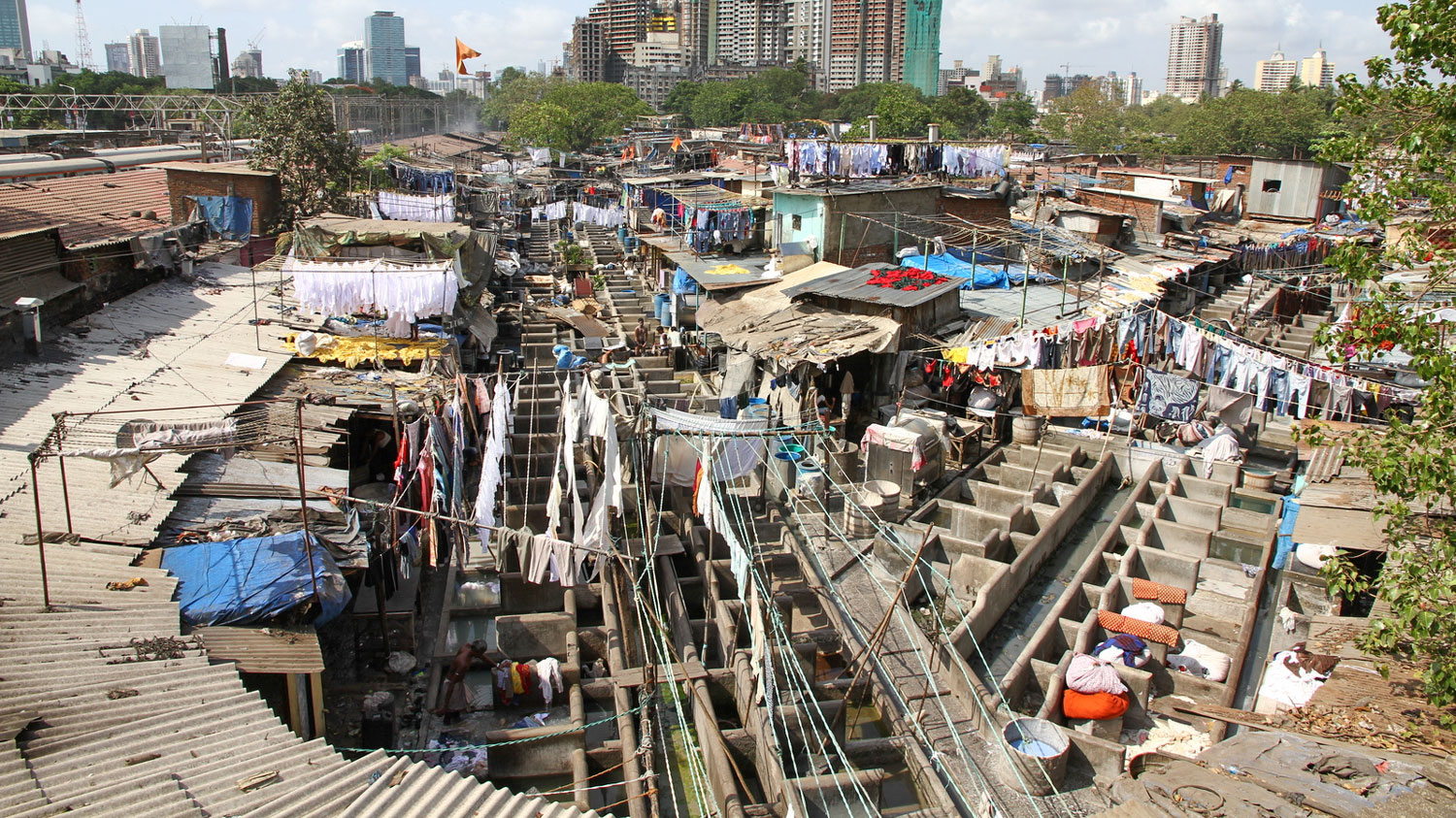
Another web picture that shows workers washing clothes by hand in the pens. The tour guide said they put fresh water in the pen in the morning and use that same water for all their washing during the day. The workers slap the items against a hard surface, and it's very hard on the clothes.
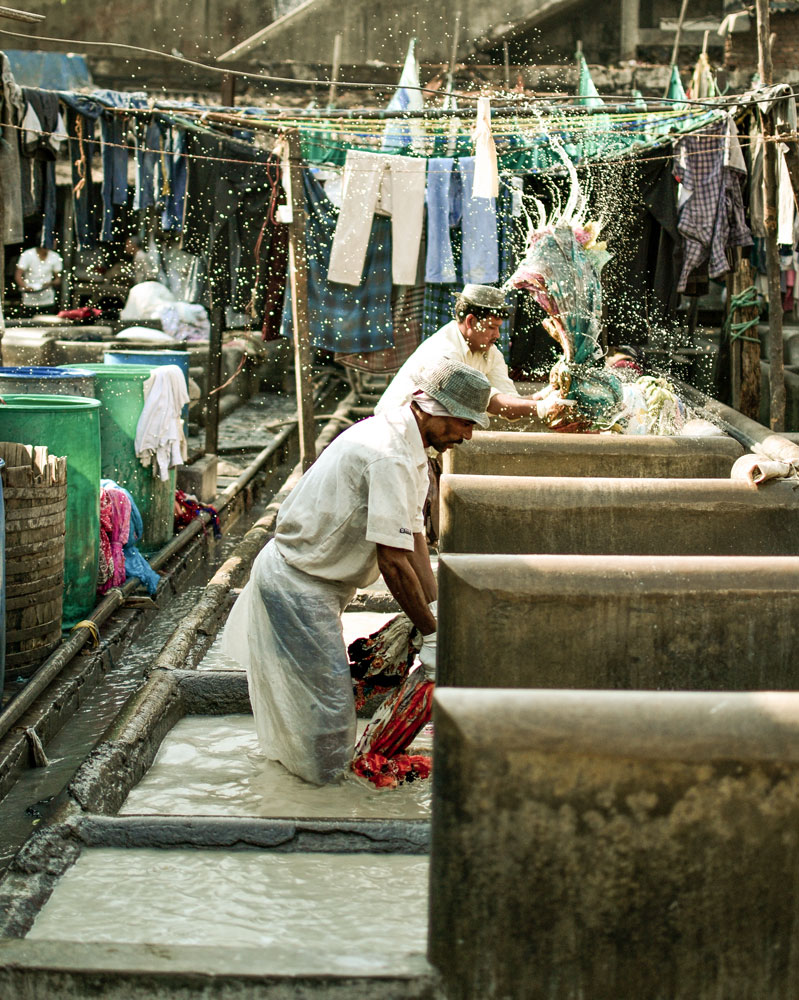
Here's a picture I took showing the clothes drying.
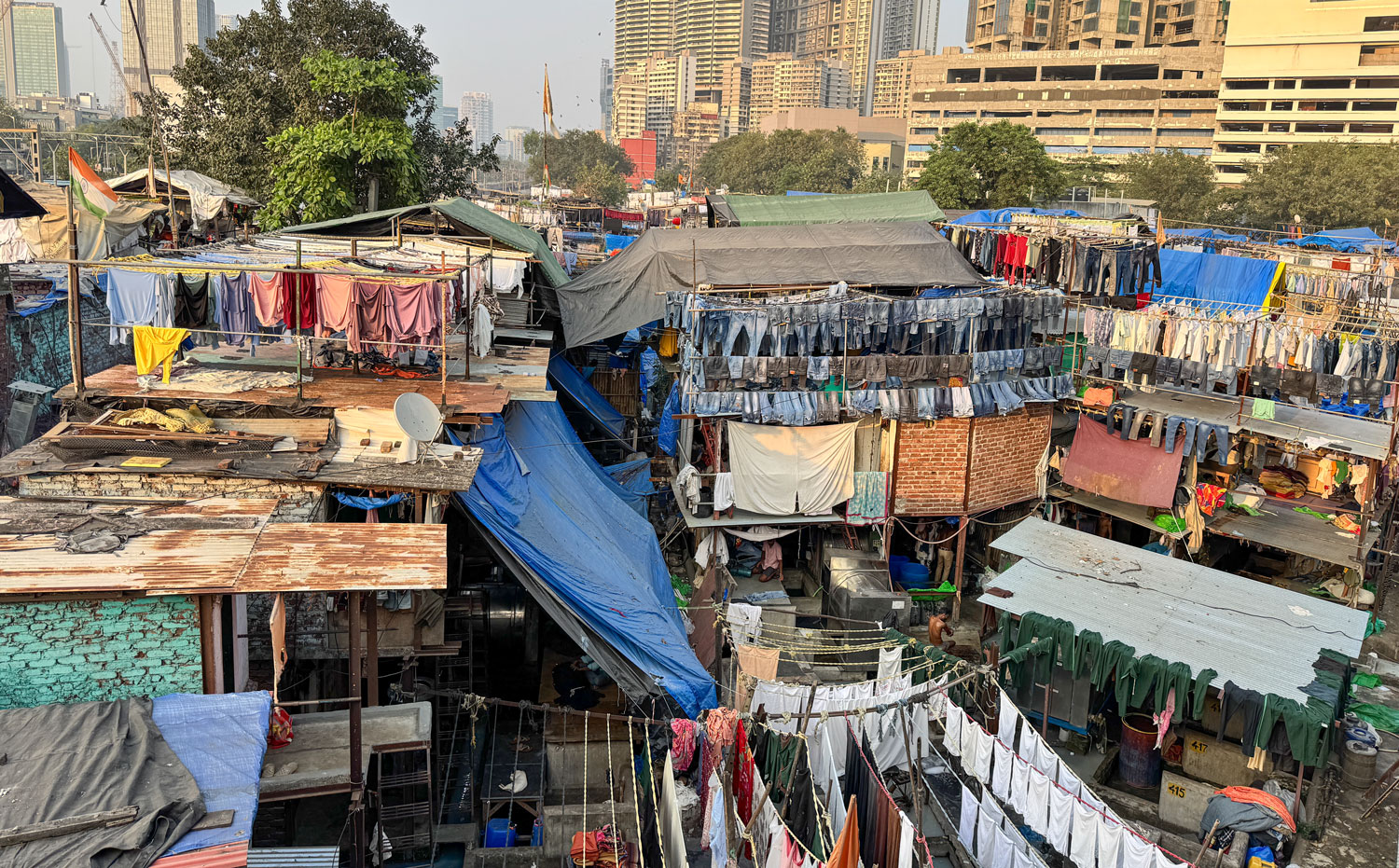
From here we drove toward the hotel, passing the Dabbawala statue.
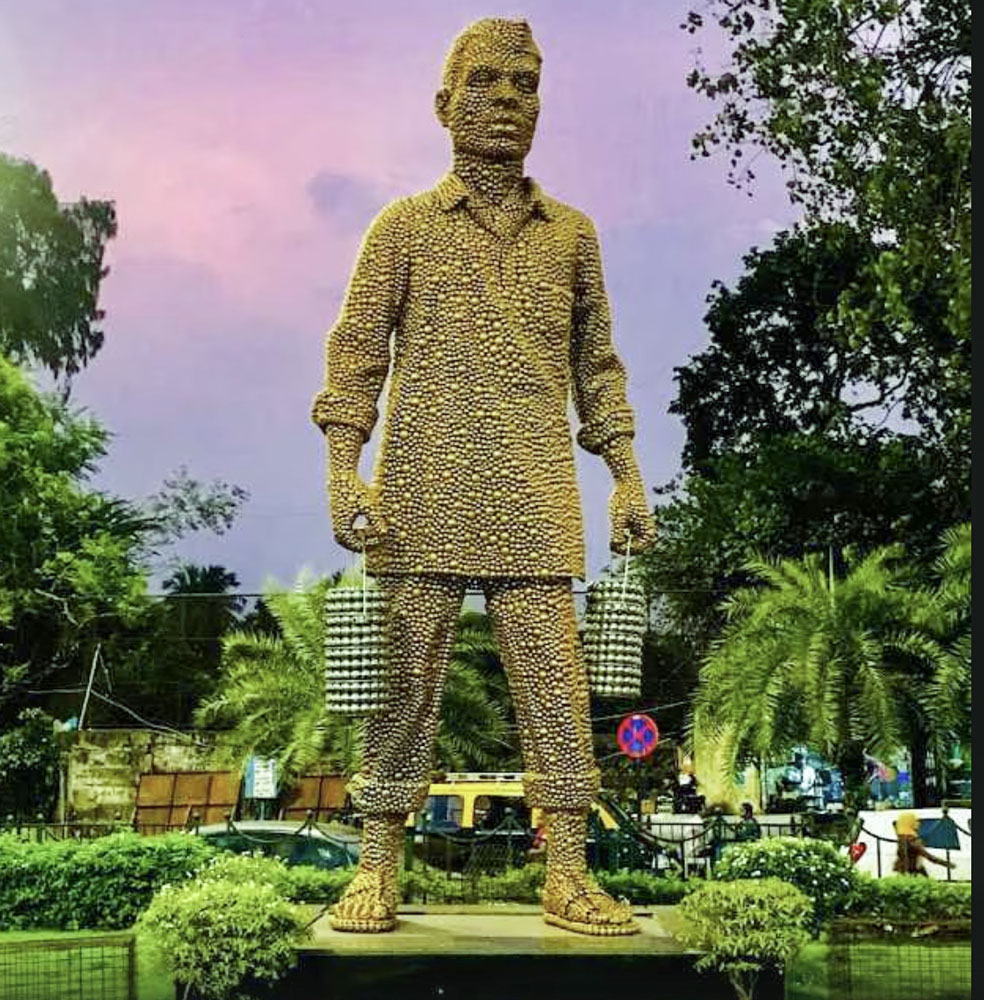
In Mumbai, the man of the house leaves very early to go to work. The housewife then prepares a lunch for her husband and a "Lunchbox man" (or Dabbawala) picks up the lunch box and delivers it to her husband. Later in the afternoon, the Dabbawala picks up the empty lunchbox and returns it to the home. This is also used to provide a lunch to schoolchildren.
The lunchbox, called a Dabba, or Tiffin Carrier, is made of metal, and consists of multiple containers that fit together and then fit within a carrying handle.
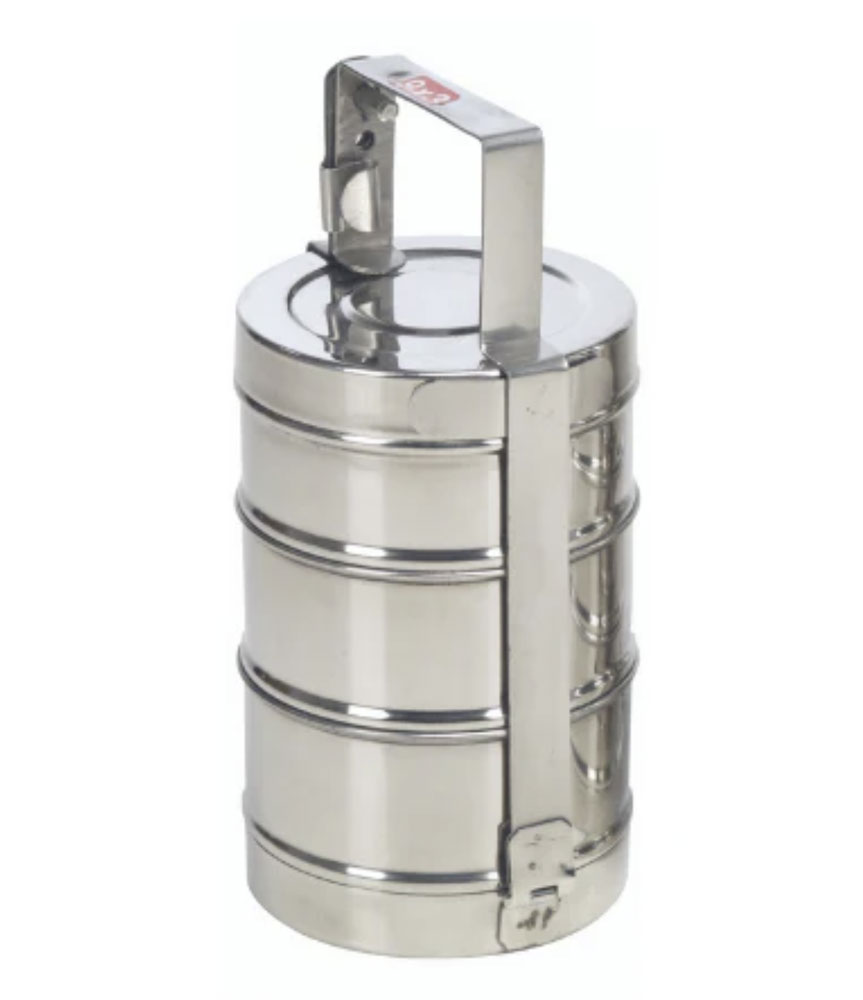
They used very similar lunch carriers in Vietnam when I was there in 1970. I even bought two decorative ones and have them in the attic at home. The ones I have look more like this.
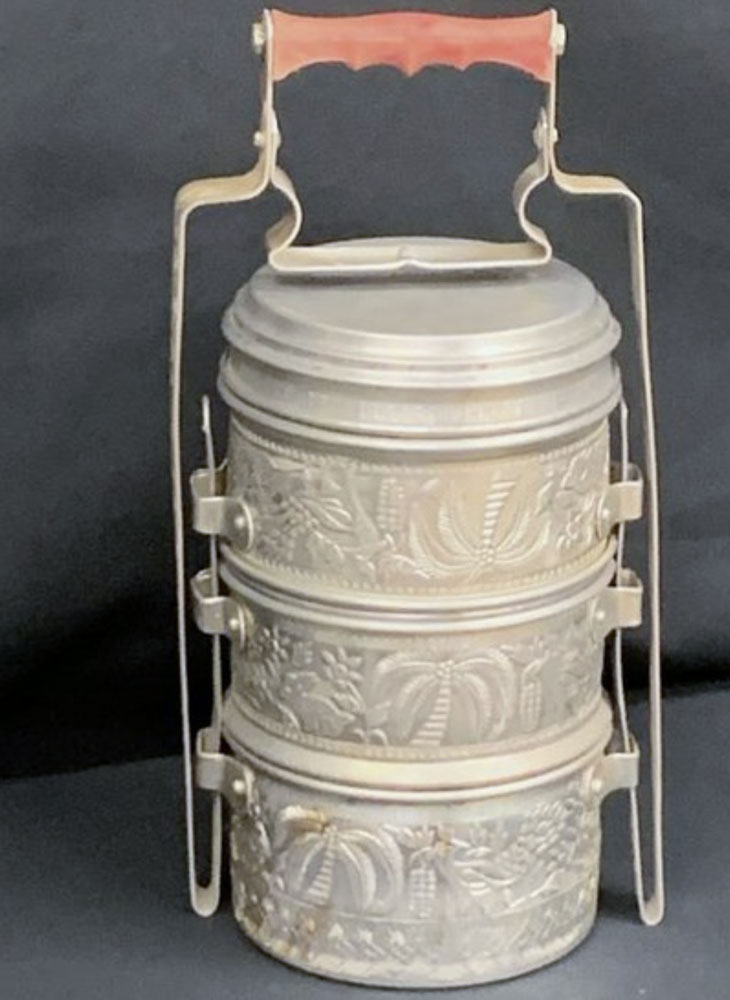
Use of the Dabbawala is declining for several reasons. Women are now entering the workforce so there's no one at home to prepare the dabba. There's also a security issue. Most schools will no longer accept Dabbawala delivered meals because it would be very easy for explosives to be hidden in a dabba. Some corporations refuse Dabbawala delivered meals for the same reason.
Eventually we arrived at the Oberoi Mumbai hotel. It's the shorter building in the picture. The taller building is the Trident Hotel. They are part of the same complex, owned by the Oberoi Group.
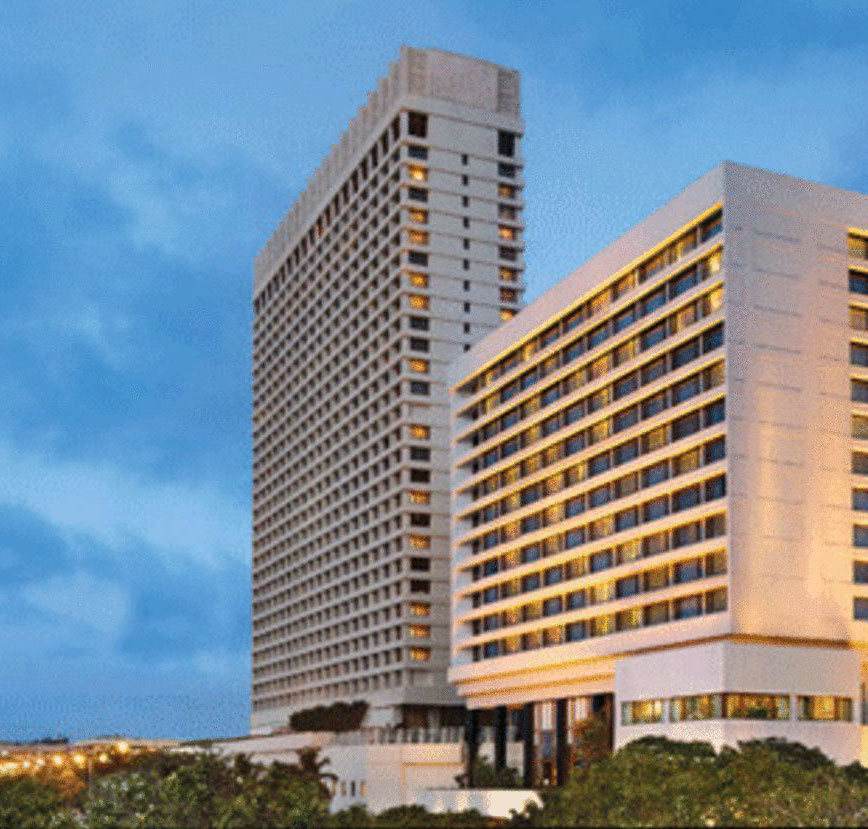
Annie distributed our room keys and we went to our rooms. Ours is huge. Upon entry, you're in a sitting room with a sofa, chairs and a work desk. There's a big window that looks out on Back Bay.
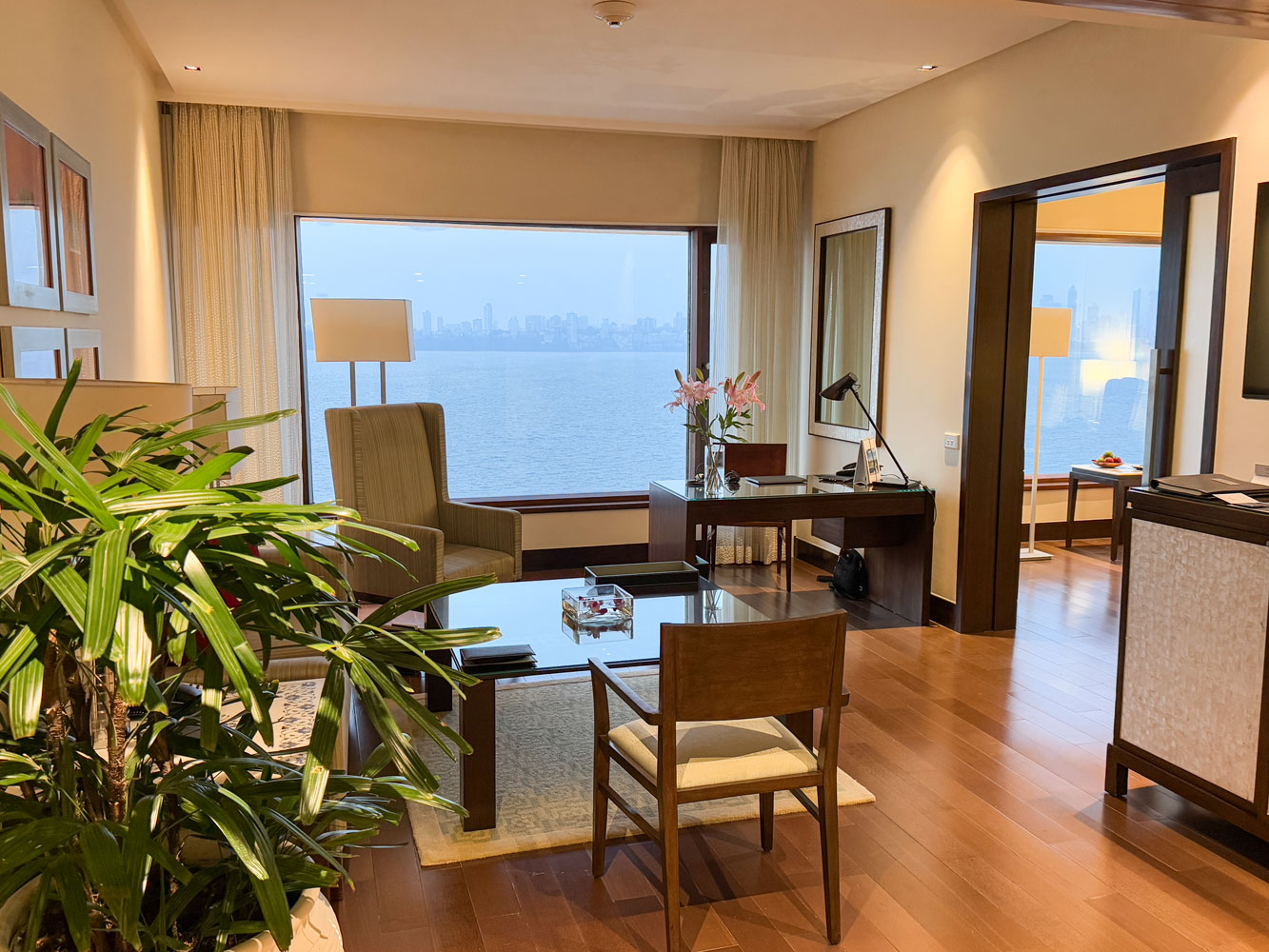
To the right in the above picture is a doorway to the bedroom. It also has large window looking out over Back Bay. Both windows have a powered drop-down shade.
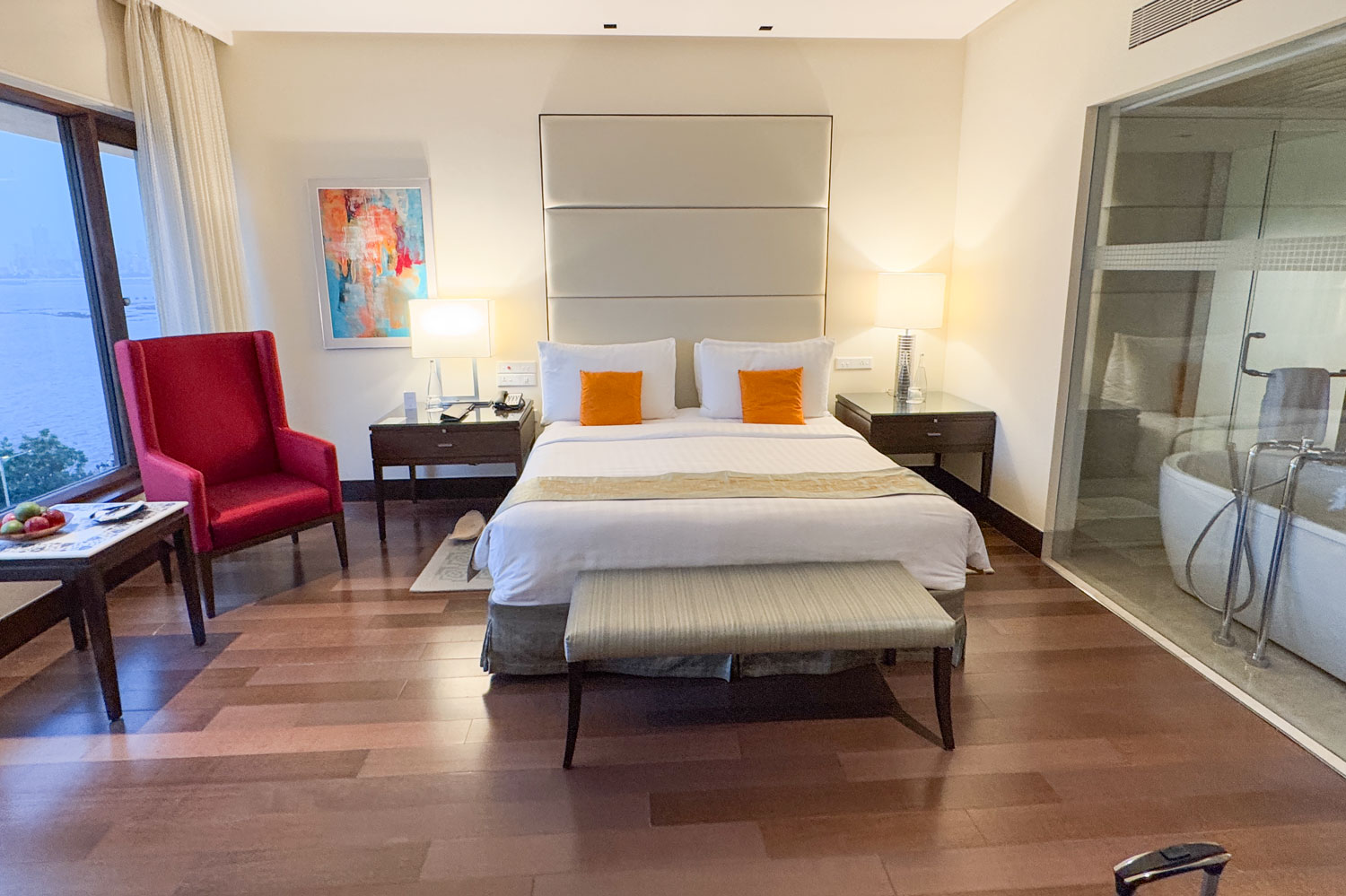
To the right in the bedroom picture is the bath, which has a tub, a walk-in shower and two sinks. It's separated from the bedroom by a glass wall that can be closed off by a powered drop-down shade.
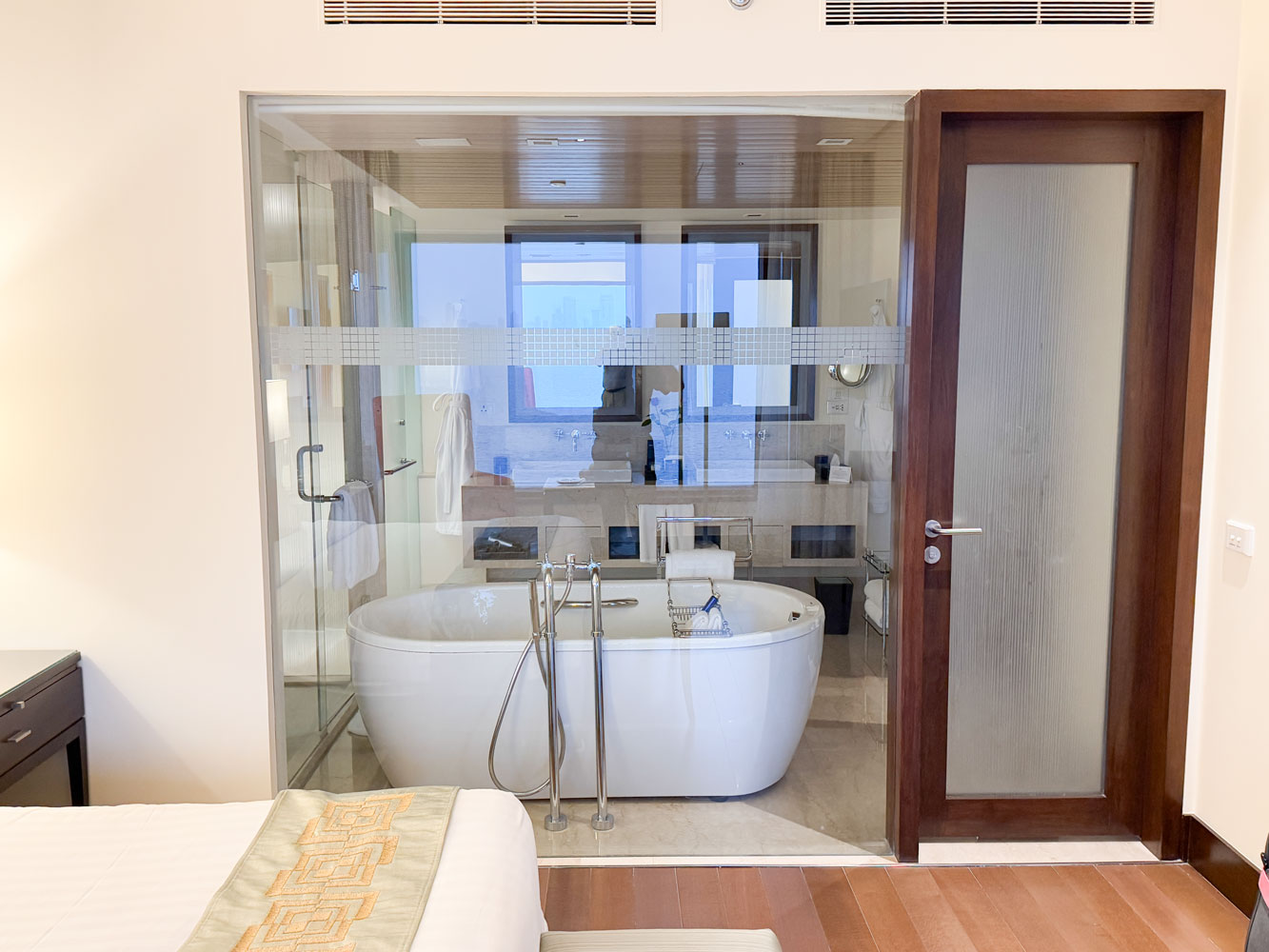
There are condos in Los Angeles that are not this big. This hotel is certainly the most luxurious one on the tour.
We had dinner in the Italian restaurant in the hotel. Judy still has the red bindi they put on her forehead when we arrived.
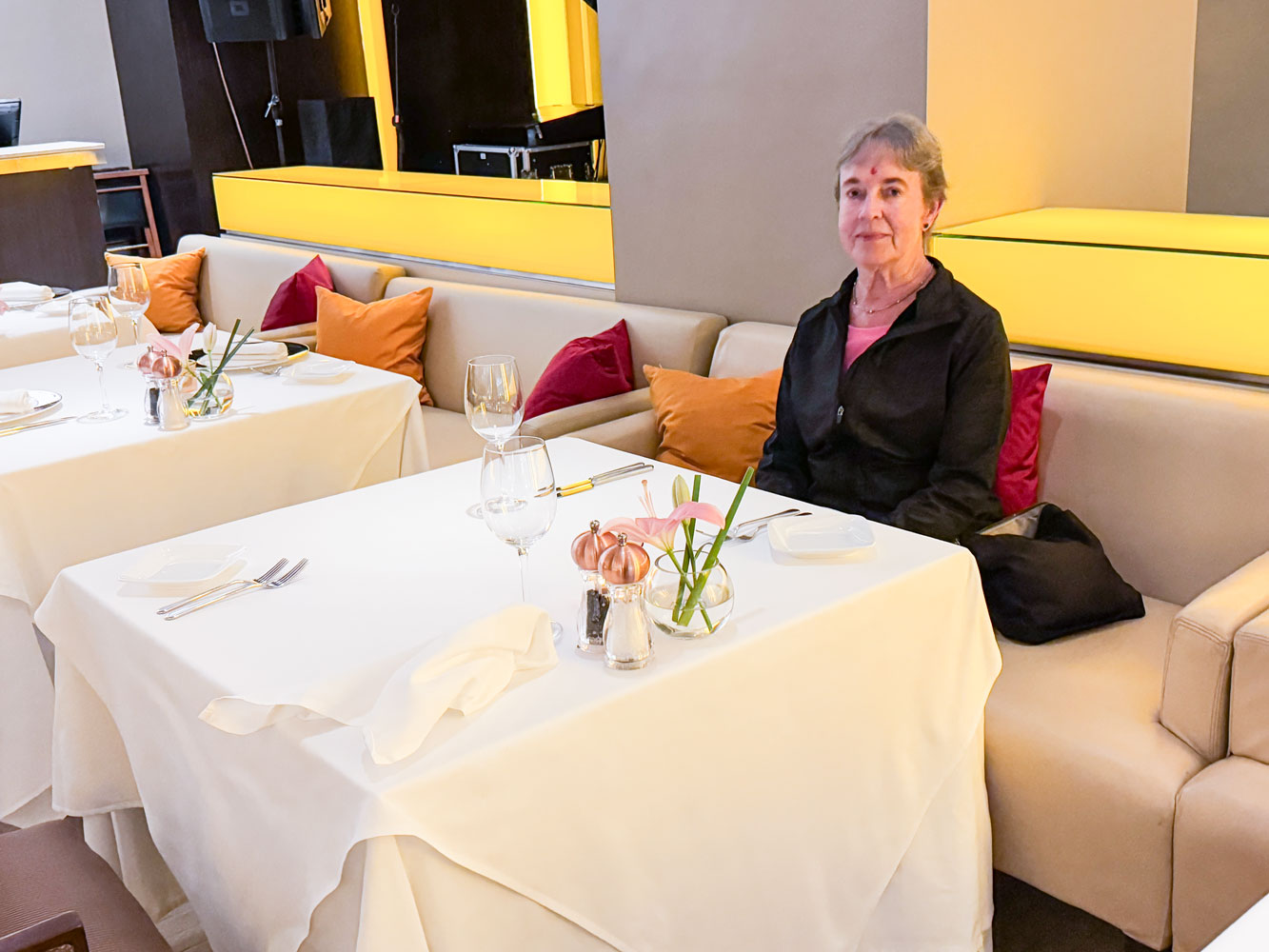
And that was our day.
But before I go, I need to talk about the 2008 Mumbai Terrorists Attacks. The attack was primarily against the Taj Mahal Palace Hotel (located nearby) but also affected the Oberoi/Trident complex.
India and Pakistan have a fraught relationship dating back to the partition of India into the two countries, Pakistan, Muslim and India, Hindu.
A terrorist organization in Pakistan, Lashkar-e-Taiba, sent ten terrorists who attacked multiple targets starting on November 26, 2008. The attacks lasted for four days, until November 29, 2008. A total of 166 people died and about 300 were wounded.
At the Oberoi/Trident at least 32 people were killed, 10 staff and 22 guests. I'll talk more about the effect on the Taj Mahal Palace Hotel when I cover our visit there tomorrow.
Nine of the attackers were killed and one was captured. That person admitted his involvement and gave a full description of the planning and attack. He was executed on November 21, 2012. For more on the attack, see the Wikipedia link above. A book was written about the attack - The Siege: 68 hours inside the Taj Hotel. I bought a Kindle edition and read a bit of it before we arrived in Mumbai.
++++++++++++++++++++++++++++++++++++++++++++++
11/4/2024 (Monday, Mumbai) We have a walking tour of Mumbai this morning. Judy and I were up at 6am and went down to the restaurant for breakfast. The Oberoi sets a very nice breakfast.
At 8:30am we met the group in the lobby for a walking tour of Mumbai. We boarded the bus and drove to the area of the University of Mumbai. There's a large open field in front of the University and several groups were playing cricket.
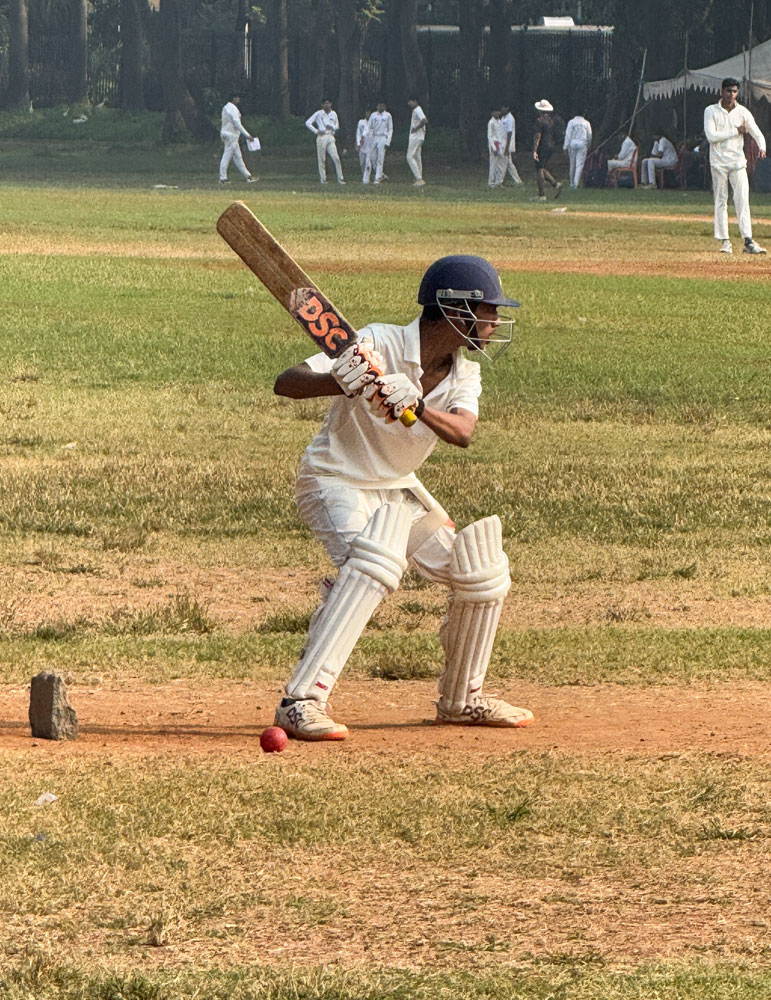
I have no experience with cricket but I think it involves the batter protecting the wicket. I was told that Winston Churchill once described cricket as "snails locked in mortal combat" but I can find no reference to that on the web. I can't even find a reference to anyone saying "snails locked in mortal combat", so I suppose the quote is apocryphal, but descriptive.
Across the field from the university was Marine Road with a number of art-deco buildings. It's reported that Mumbai is second to only Miami in number of art-deco buildings.
As we walked toward the university, Rajabai Clock Tower was in front of us.
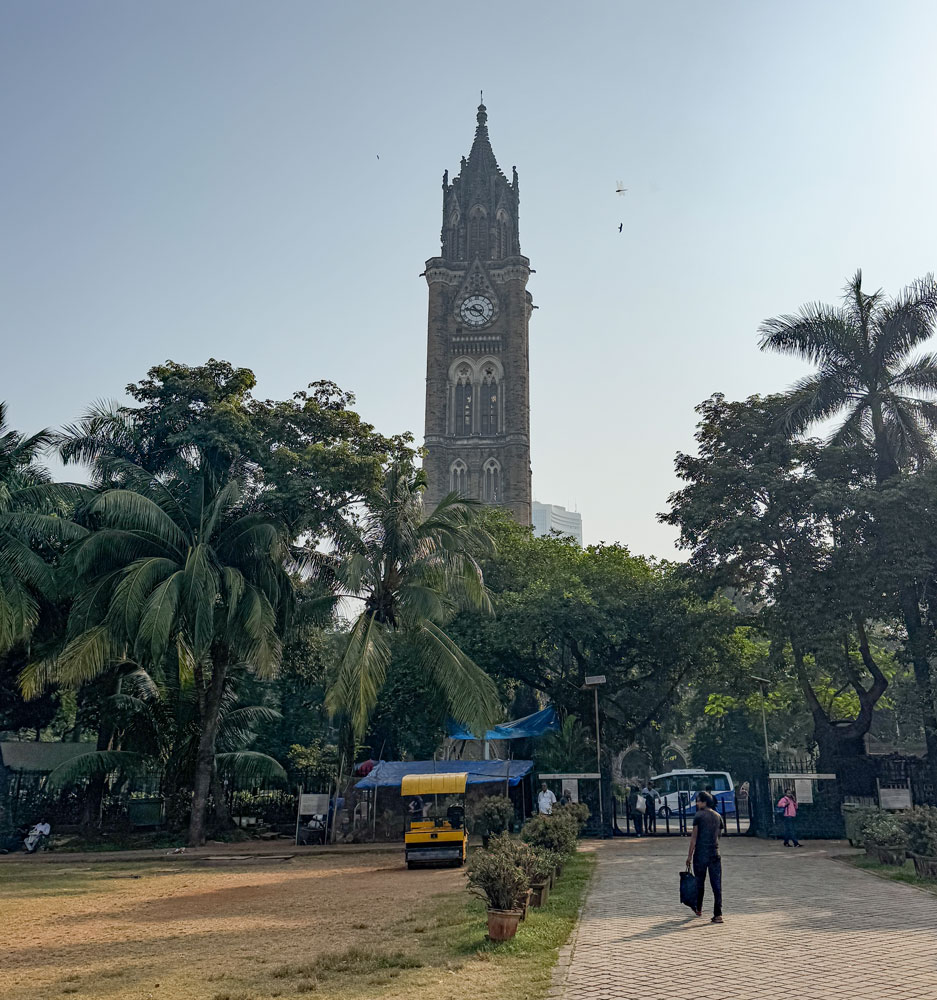
We walked left to the High Court of Bombay.
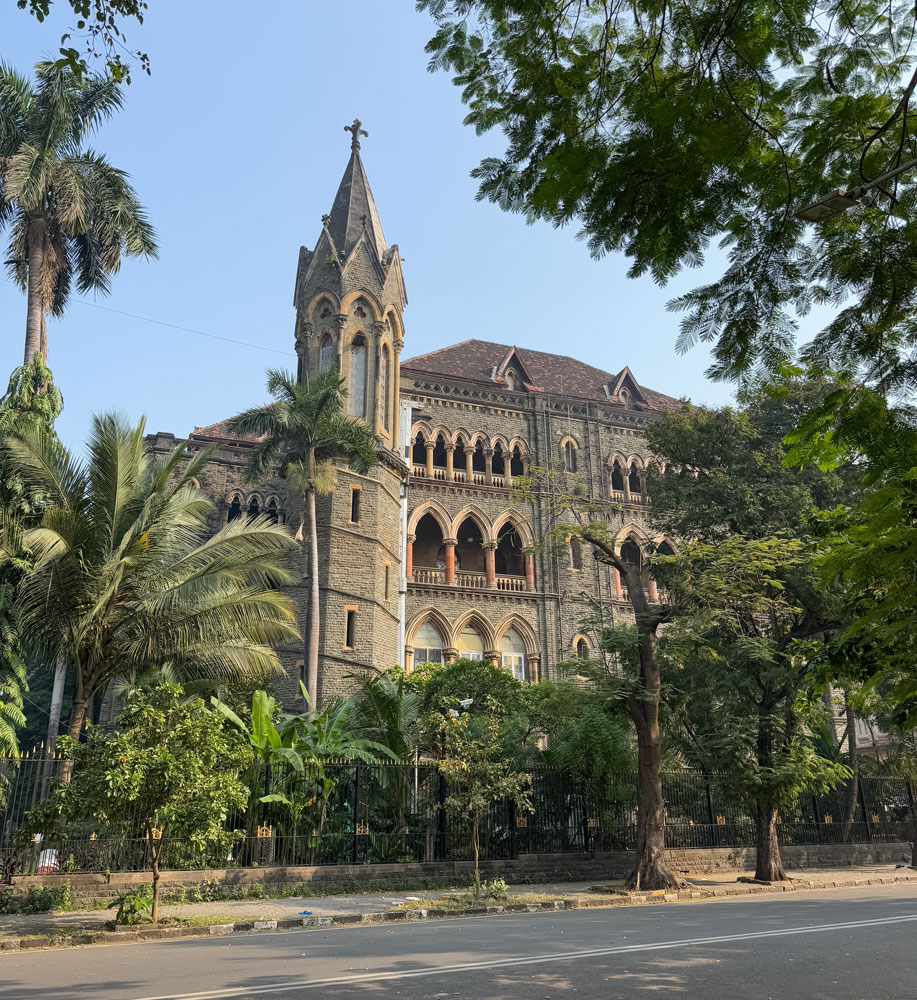
We came to the Chhatrapati Shivaji Maharaj Vastu Sangrahalaya Museum but didn't go in. You can find more information and better pictures on the link.
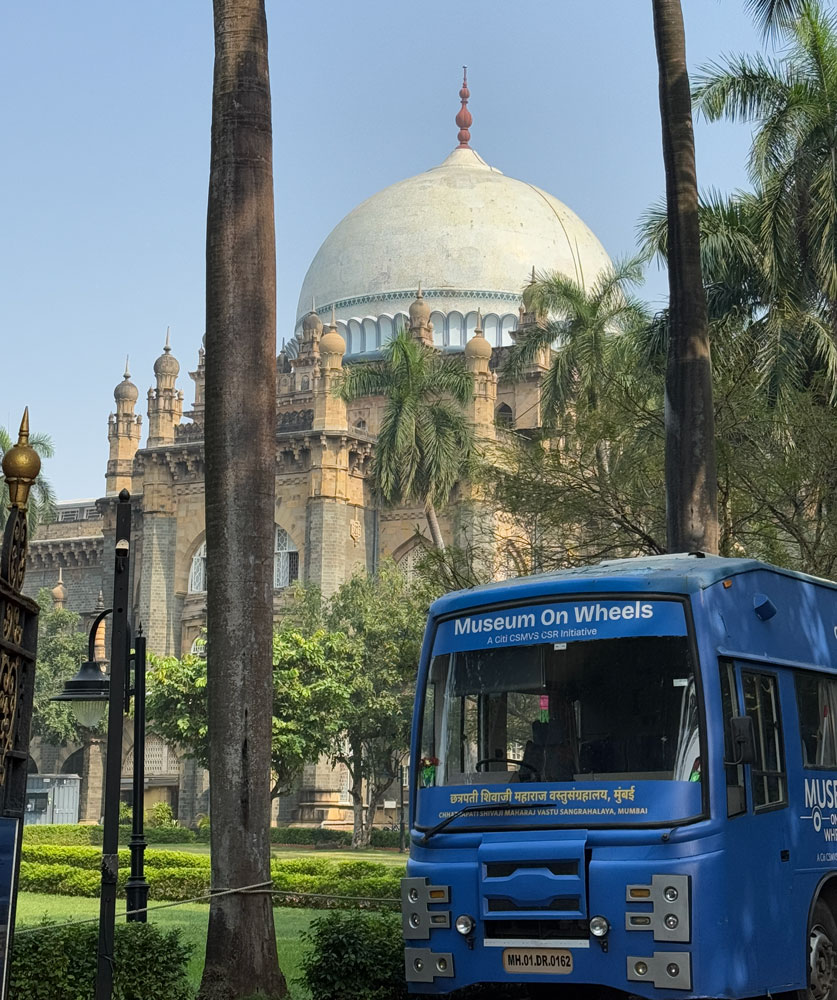
We walked to the financial district where there's a bull statue, same as in New York.
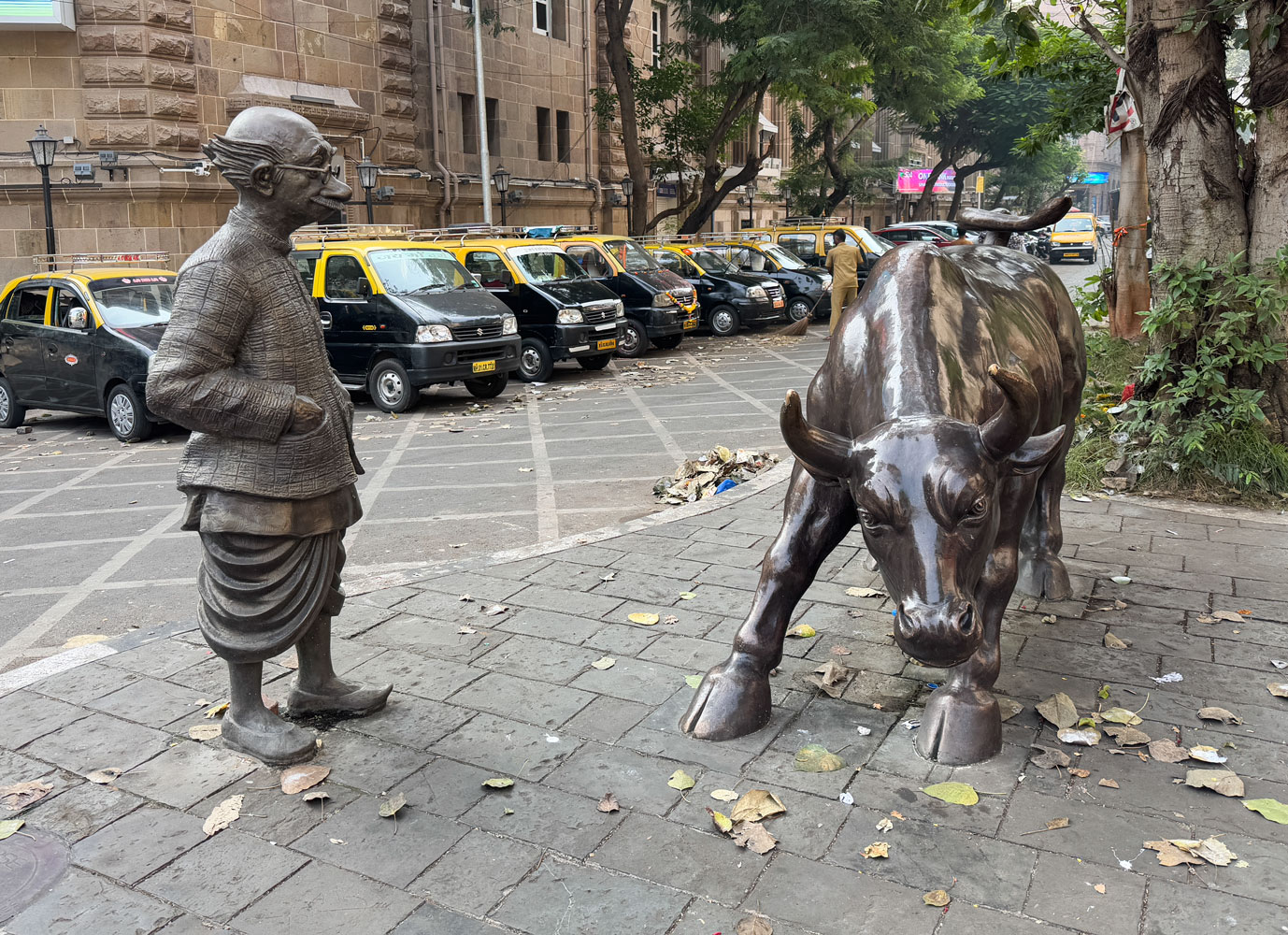
The other figure in the picture is supposed to represent the common man in India, as was drawn by a revered cartoonist. Not a very flattering image.
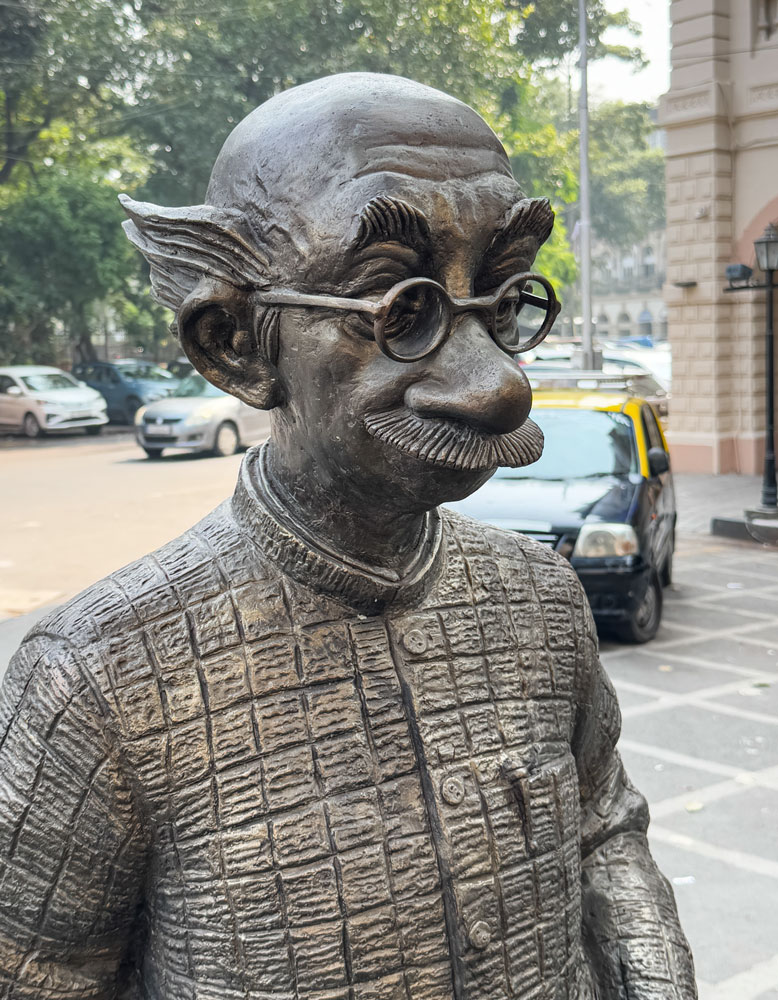
Nearby were some cows. People feed the cows when they have something good in their life. Here's Lauri feeding one of the cows.
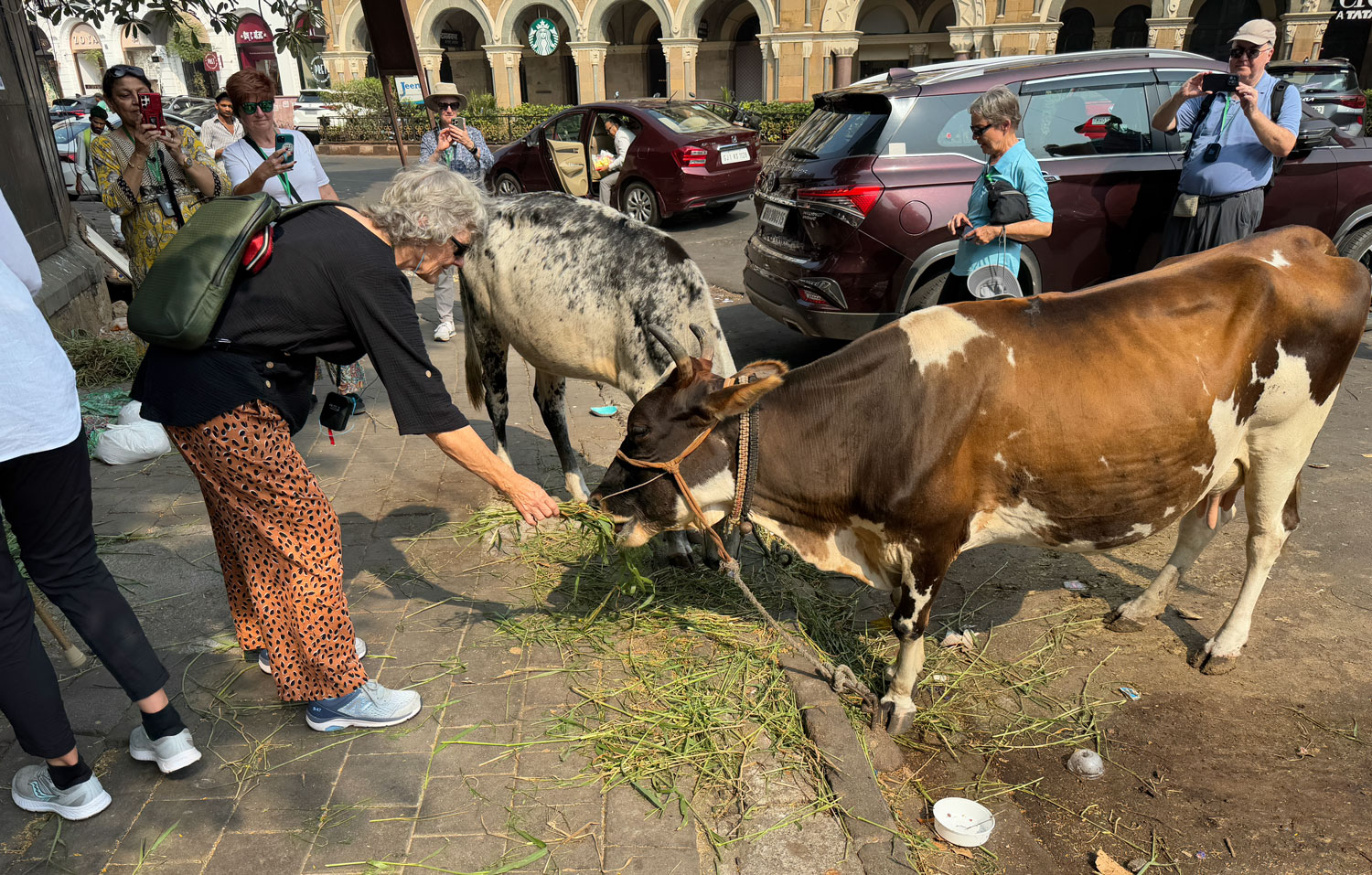
Next we walked to St. Thomas' Cathedral. It's a 300 year old Anglican cathedral, built in 1718.
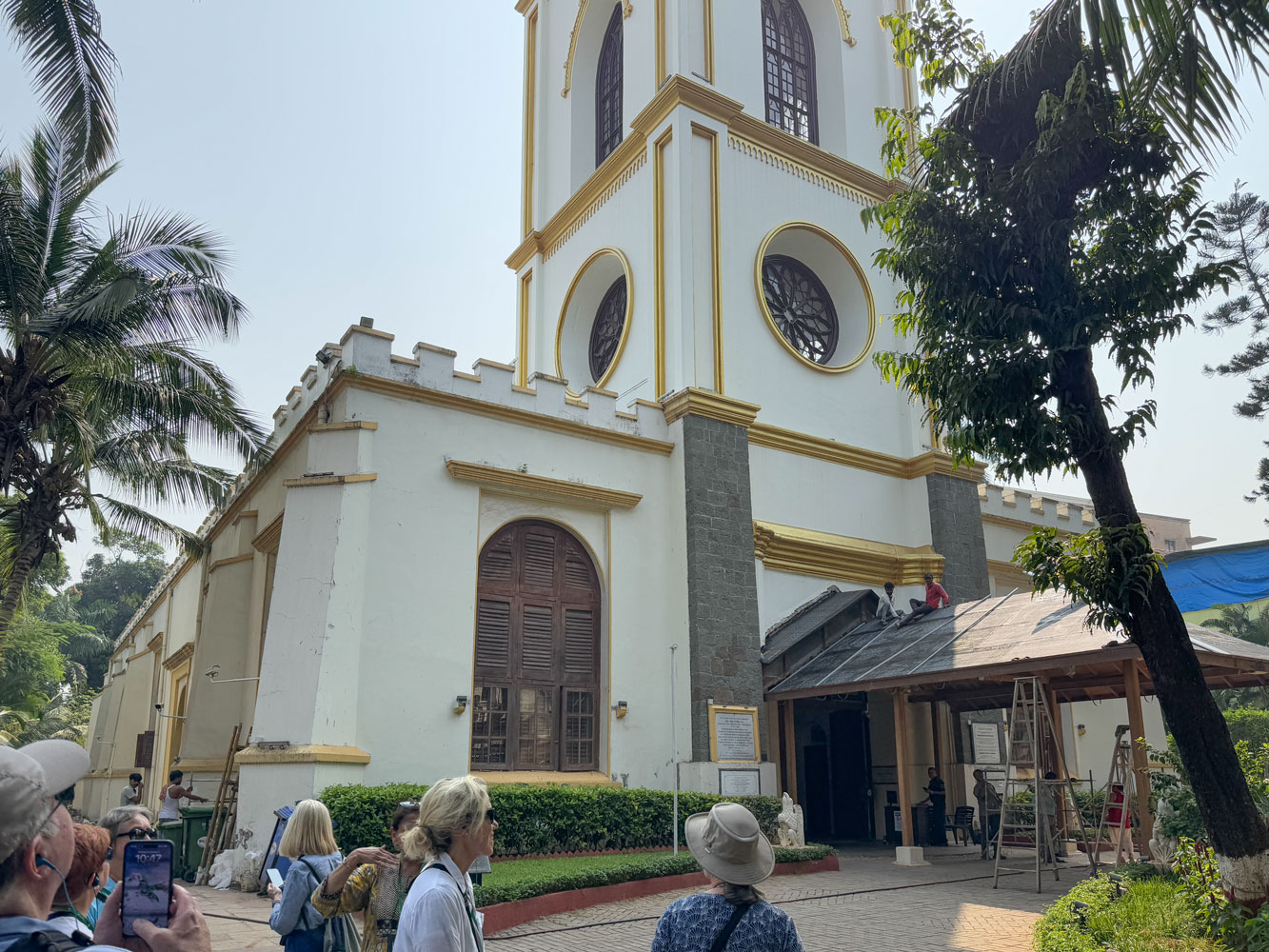
A view toward the altar.

A closer view of the altar.
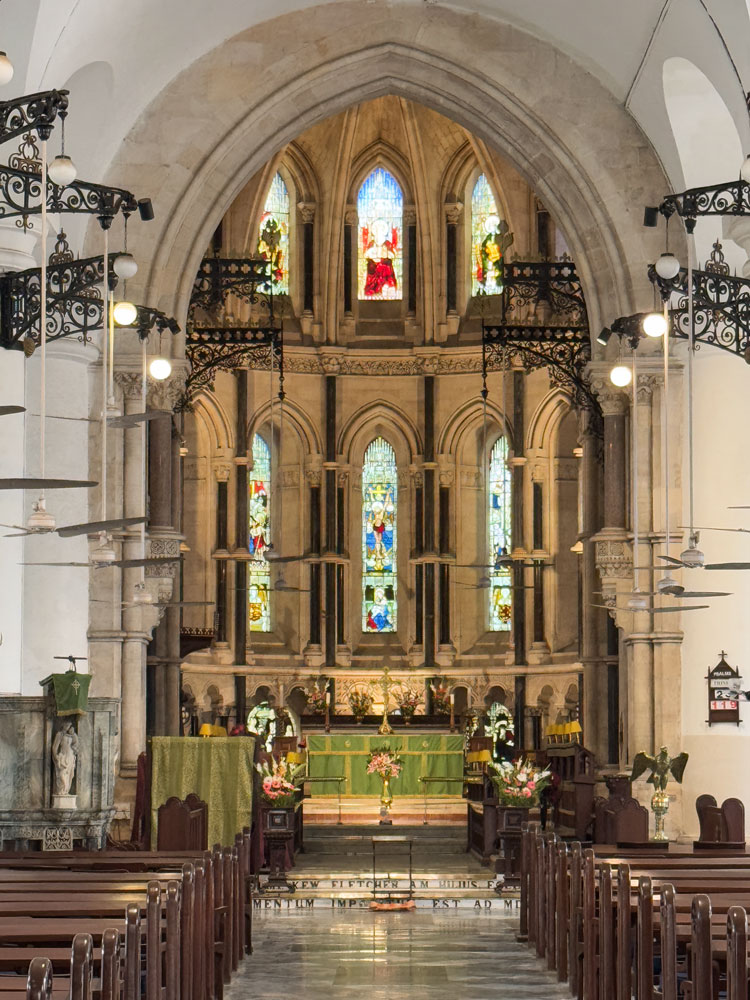
The British used the church for some burials and for monuments, mostly to British officers and their families.
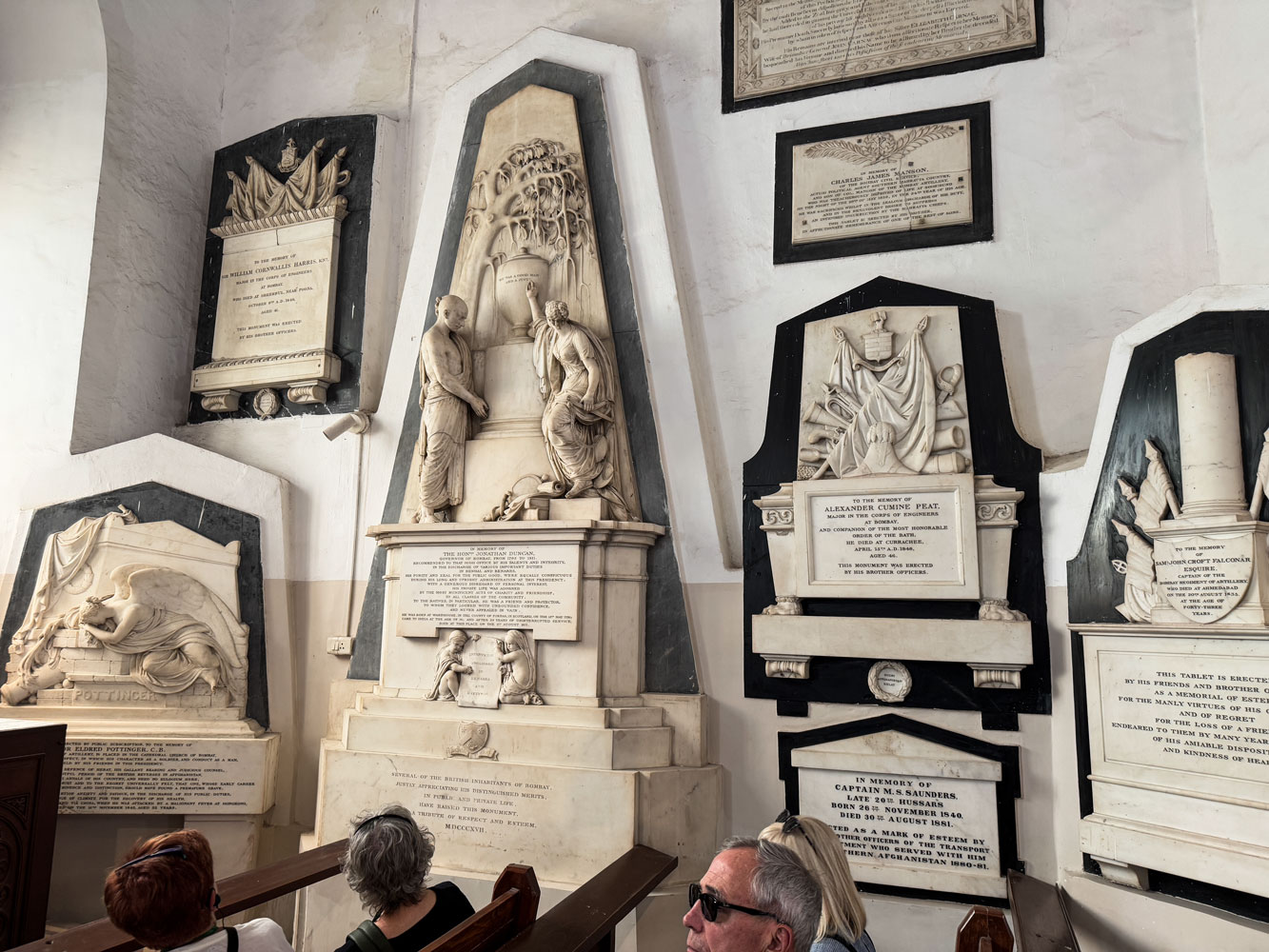
Here's the detail of one.
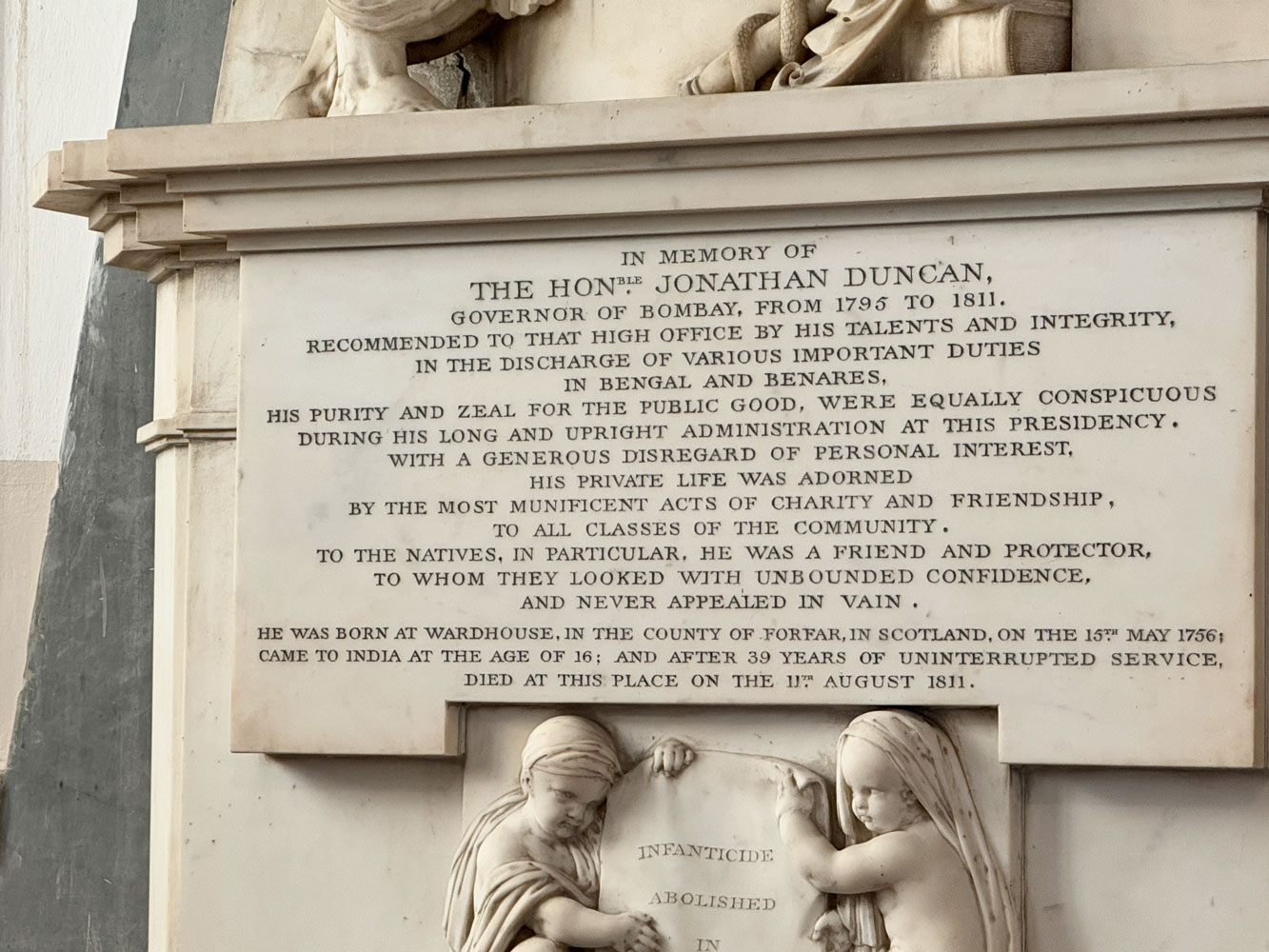
Here's another.
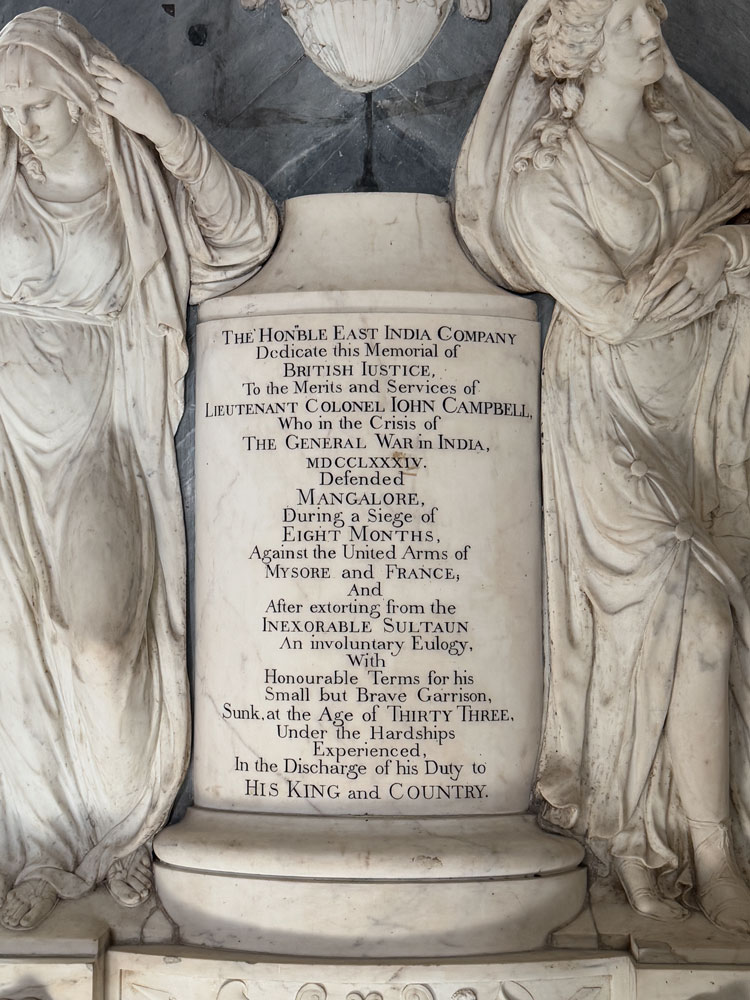
There was a Starbucks cafe nearby and we went there to use the restrooms. I thought about getting a cup of coffee to see if the coffee they serve here in India is as bad as their coffee in the US, but didn't have time.
Next we went to the train station - with the tongue twisting name of Chhatrapati Shivaji Terminus. We were on the opposite side of the road, so we took an underground connector to the terminal. Trains are used quite a bit by people, and they run on time. Our guide explained that if the trains were to shut down, Mumbai would stop functioning, since so many people depend on them.

A few pictures of this beautiful Victorian building, from inside the terminal.
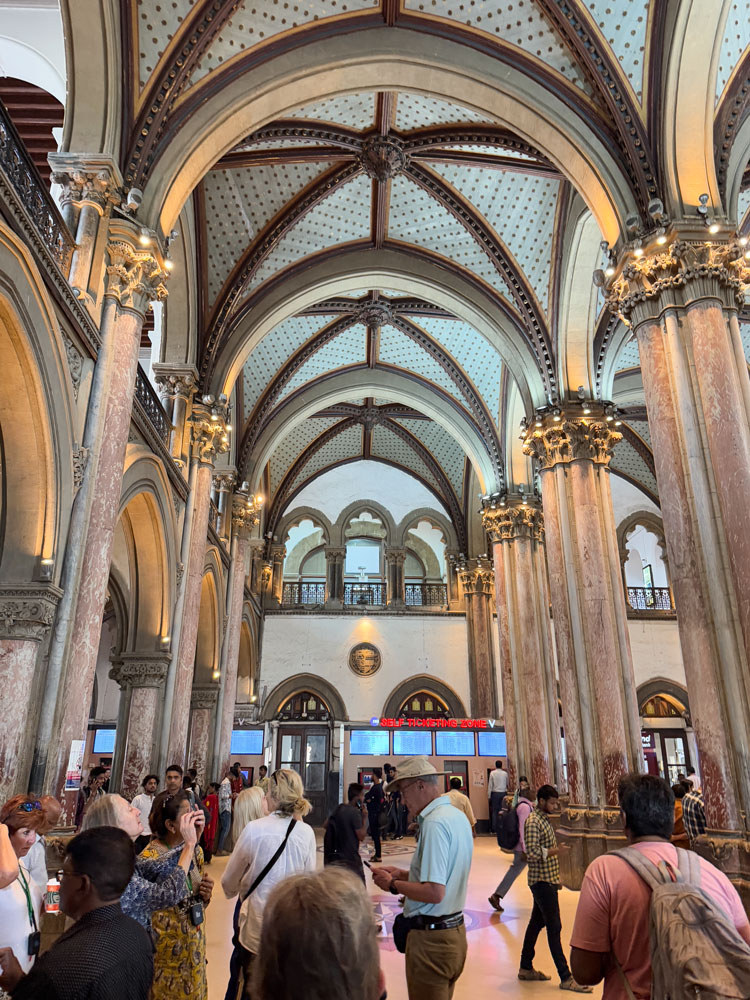
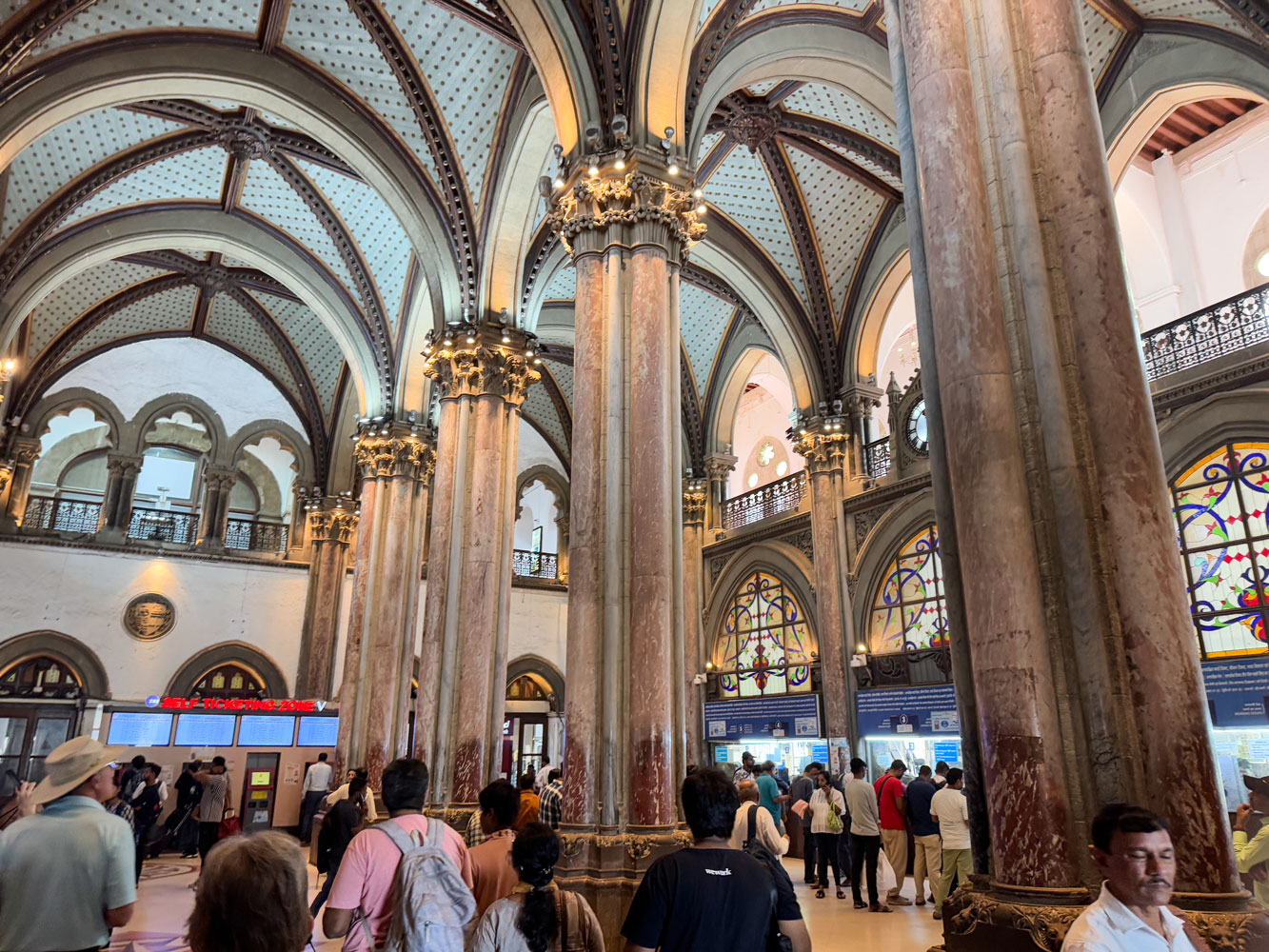
Walking toward the train platform.
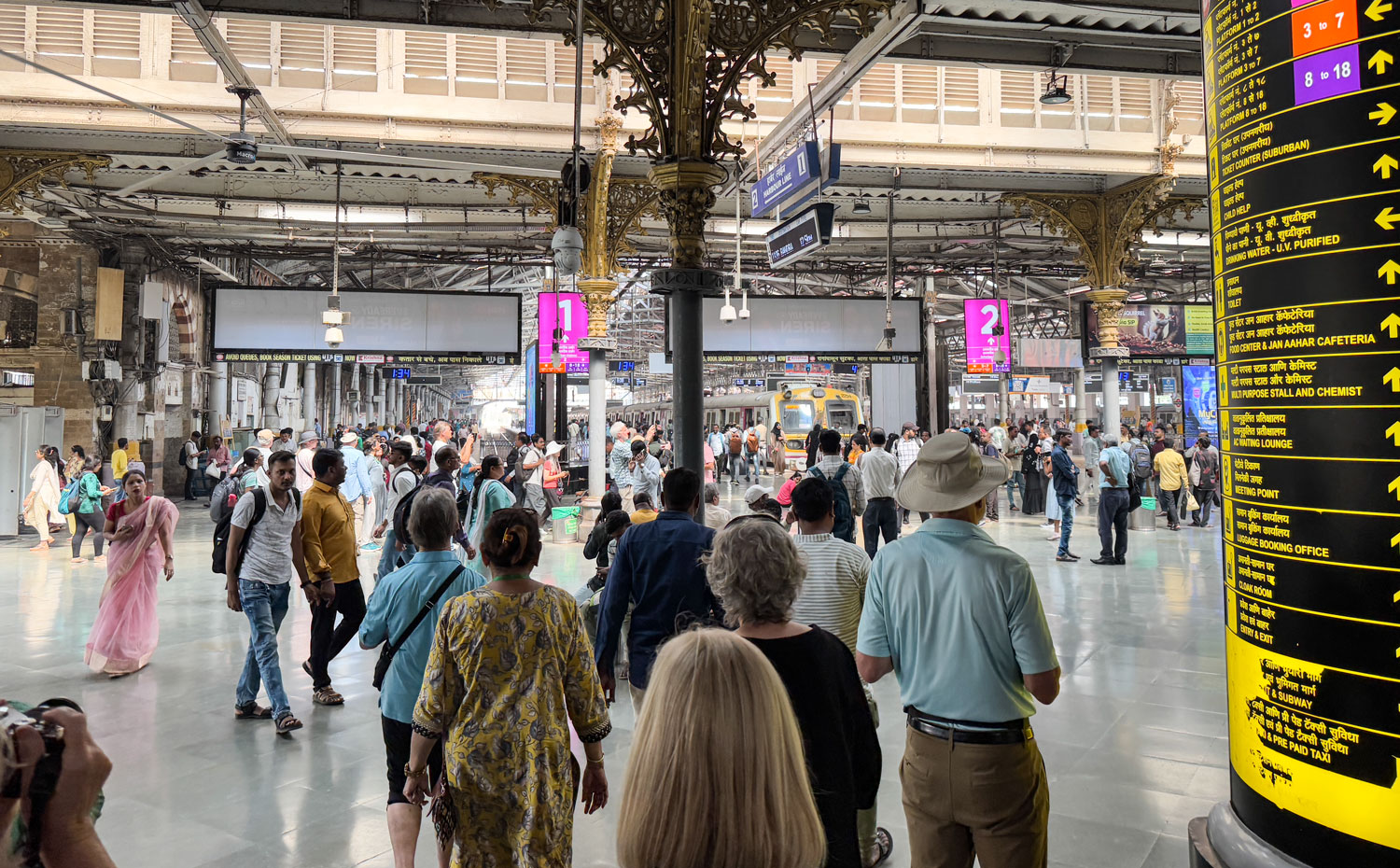
Some of our group in the terminal.
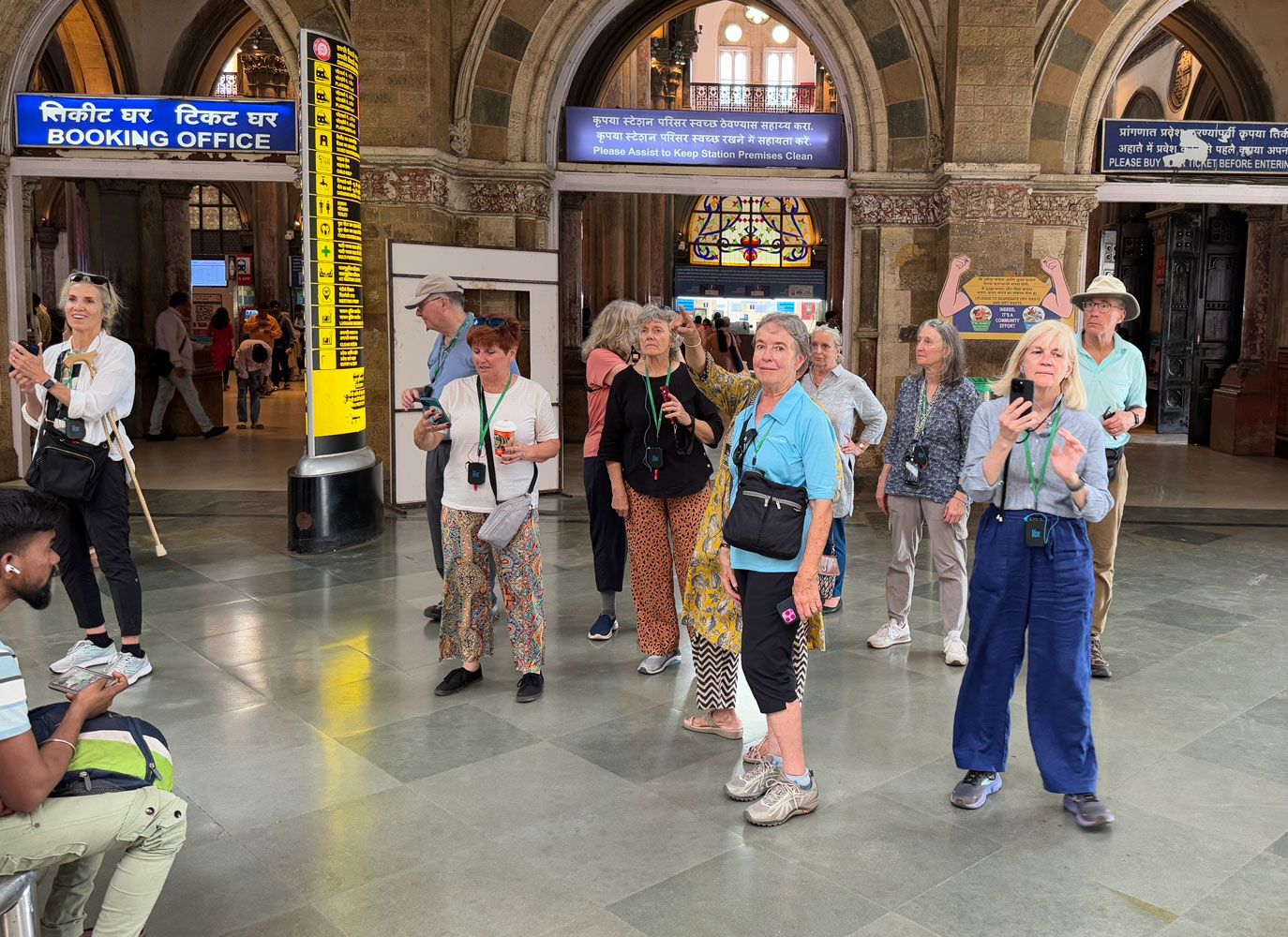
We walked down one of the platforms between two trains. People were flowing around us, going and coming.

There are a few cars on every train for women only.

Also marked by this image.
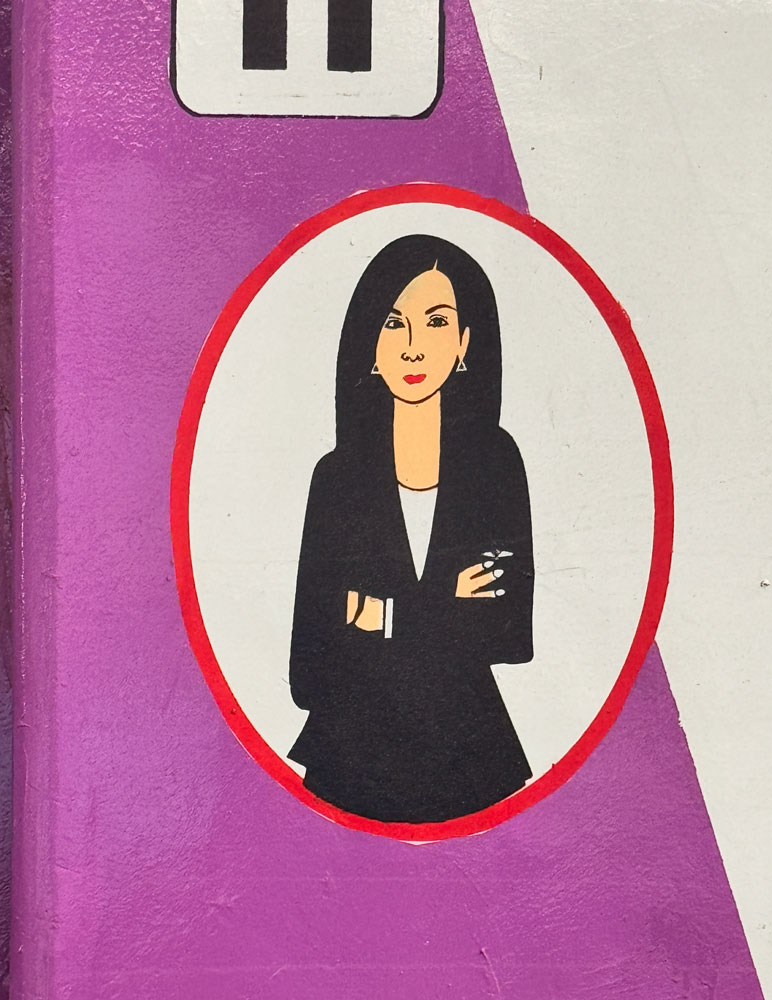
Leaving the train station, we went to the Taj Mahal Palace Hotel for lunch. The Taj is made up of two buildings, the older one was built in 1903, while the newer building was opened in 1972. Here's a picture of the lobby of the new building.
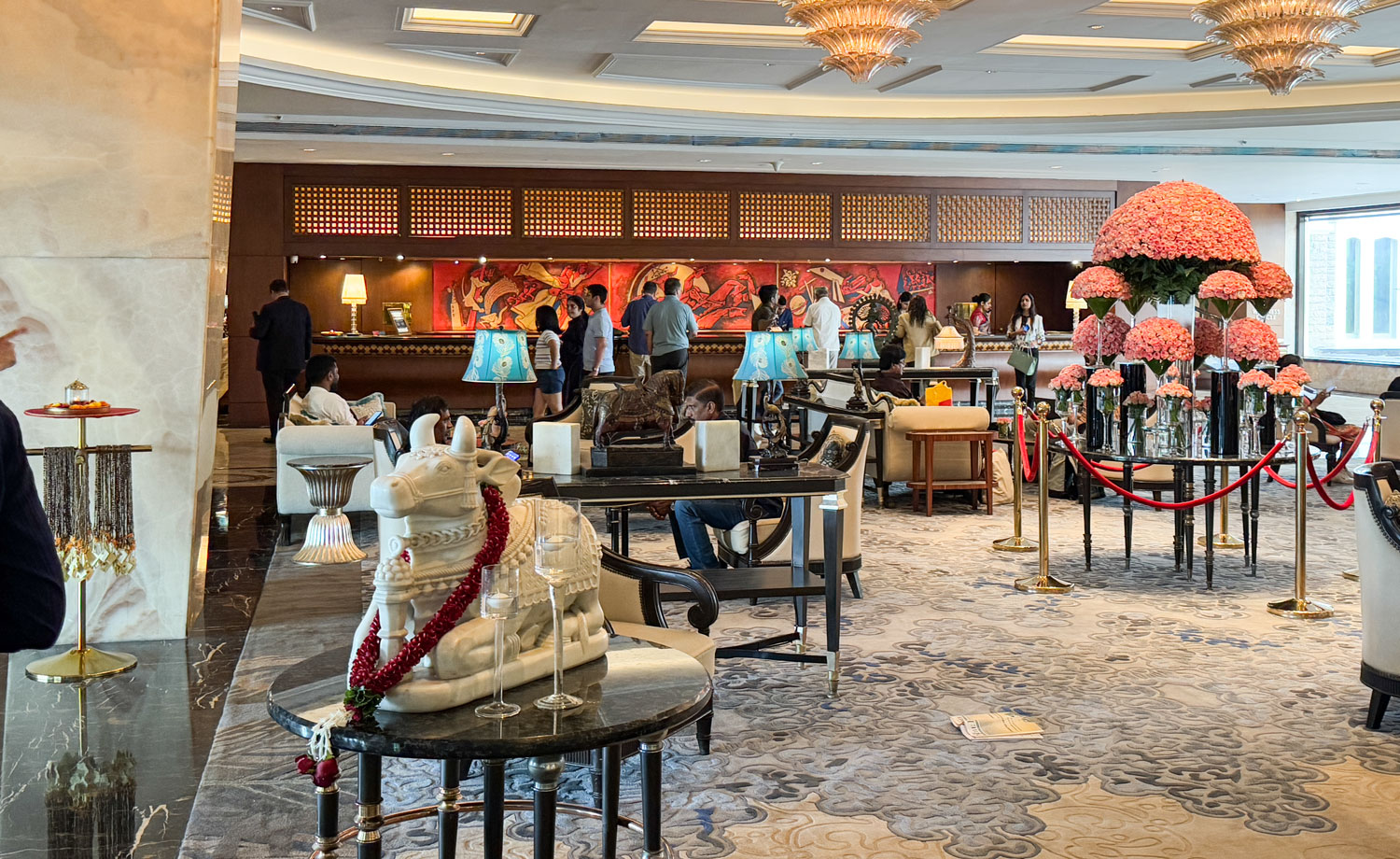
They have a water wall outside of the lobby.

A memorial to the people killed in the 2008 attack is on the left side of the above picture. Here's a closer look. There are 31 names on the memorial, plus Lucy, the sniffer dog who was working the entrance when the attack occurred (her name is the last on the list).
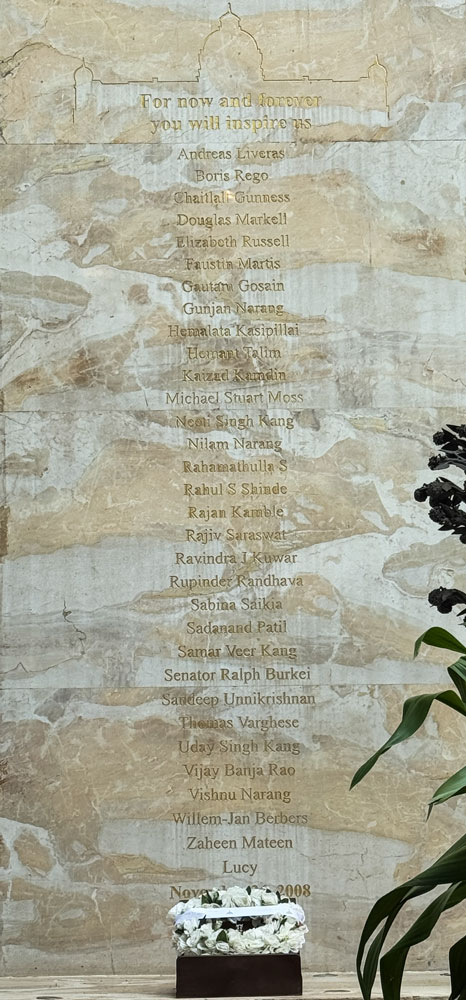
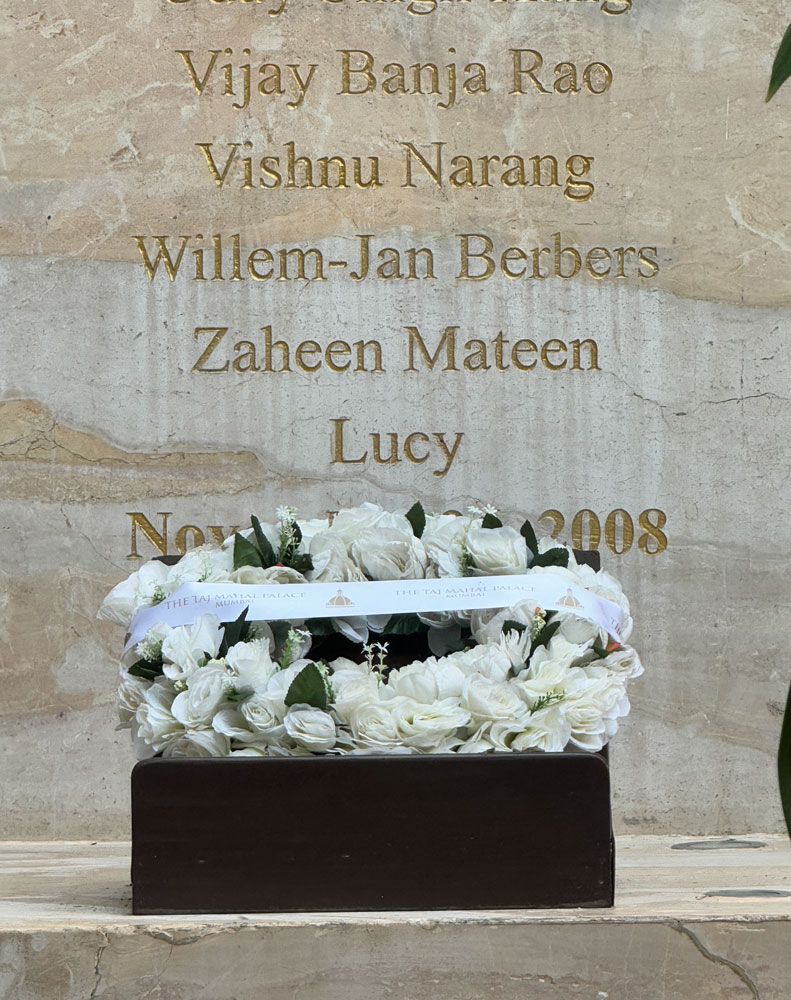
We went up to the Souk restaurant on the 21st floor for lunch.
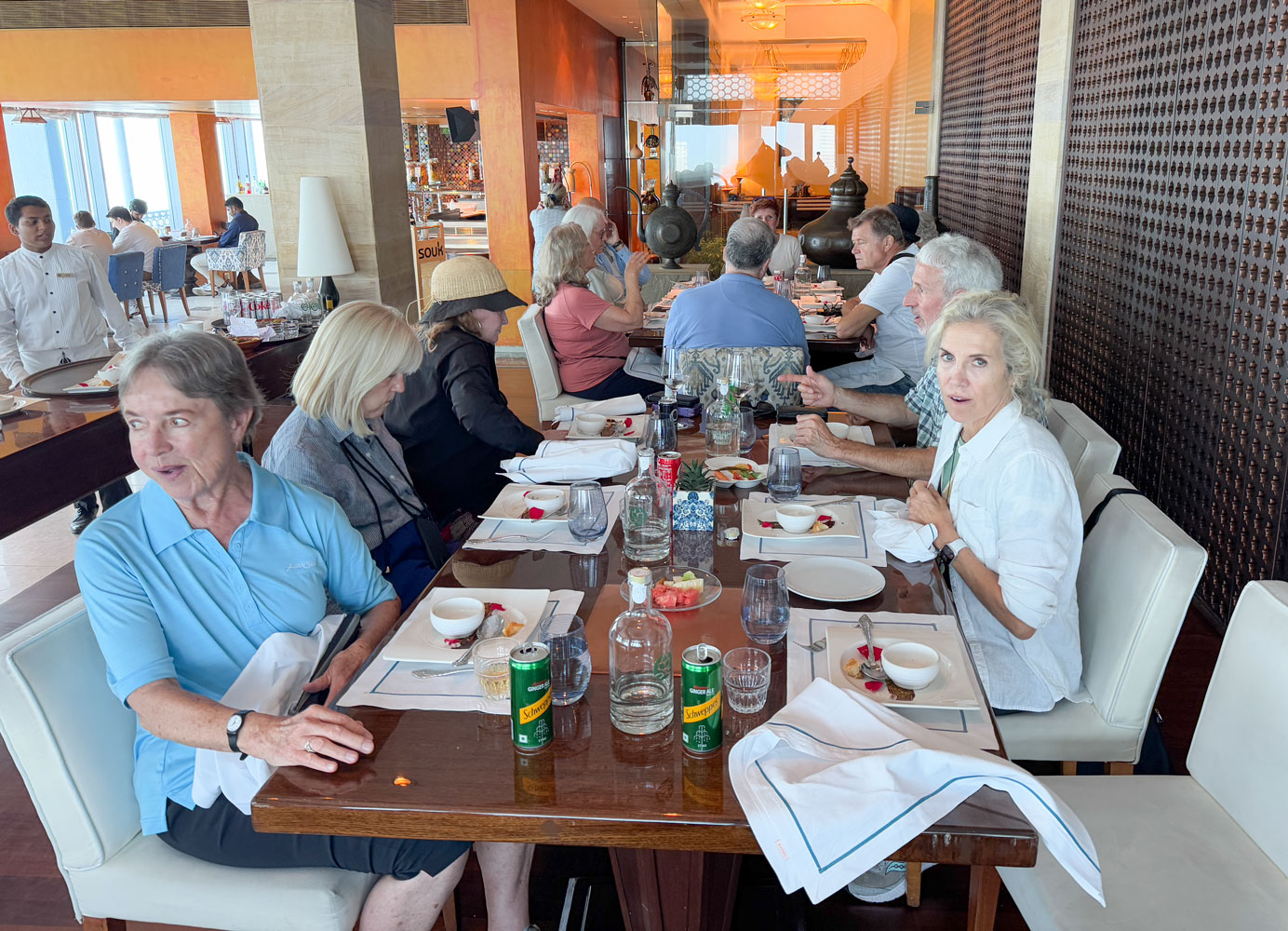
We had a good view of the area from the restaurant. Below us is the Gateway of India.
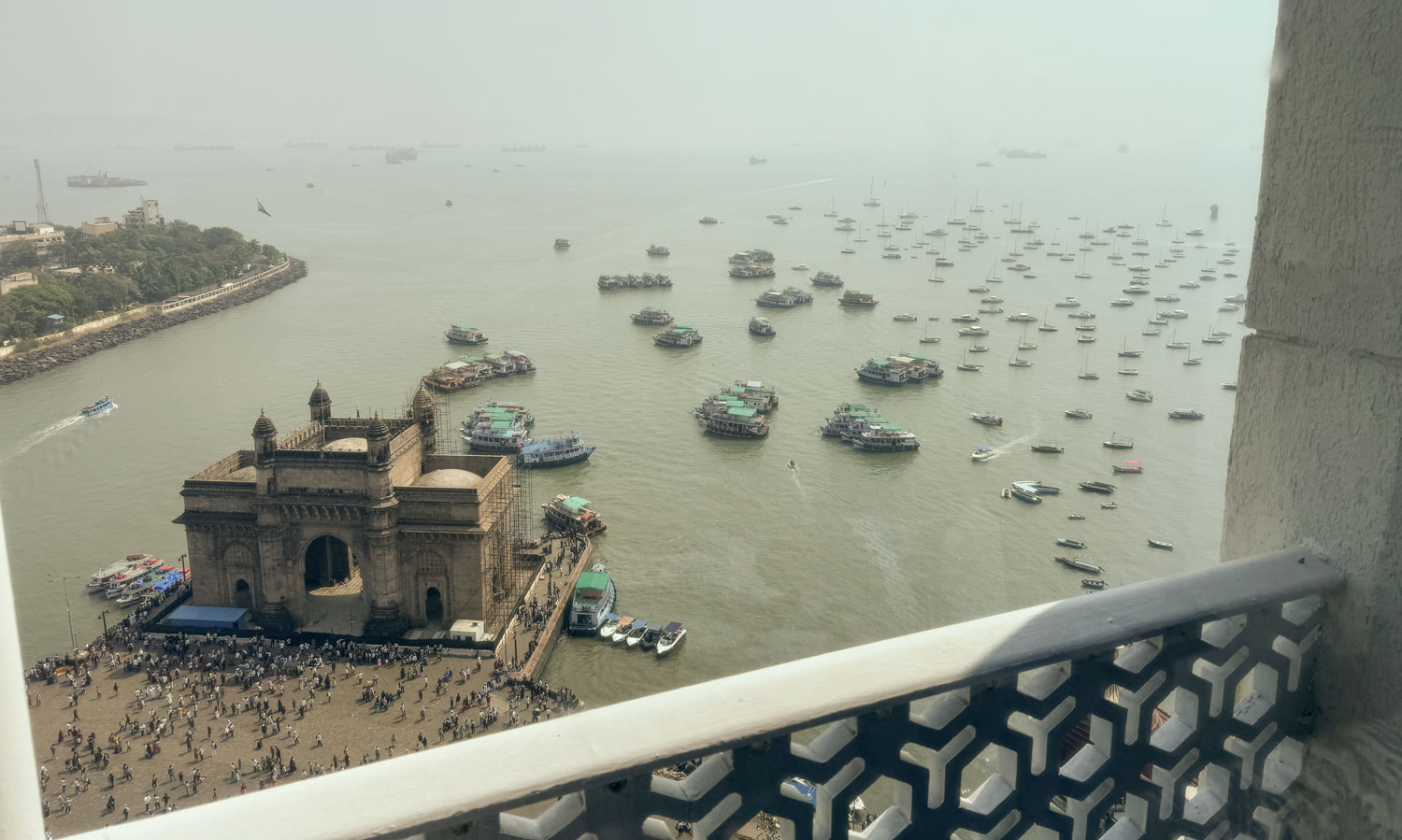

A view of the city.
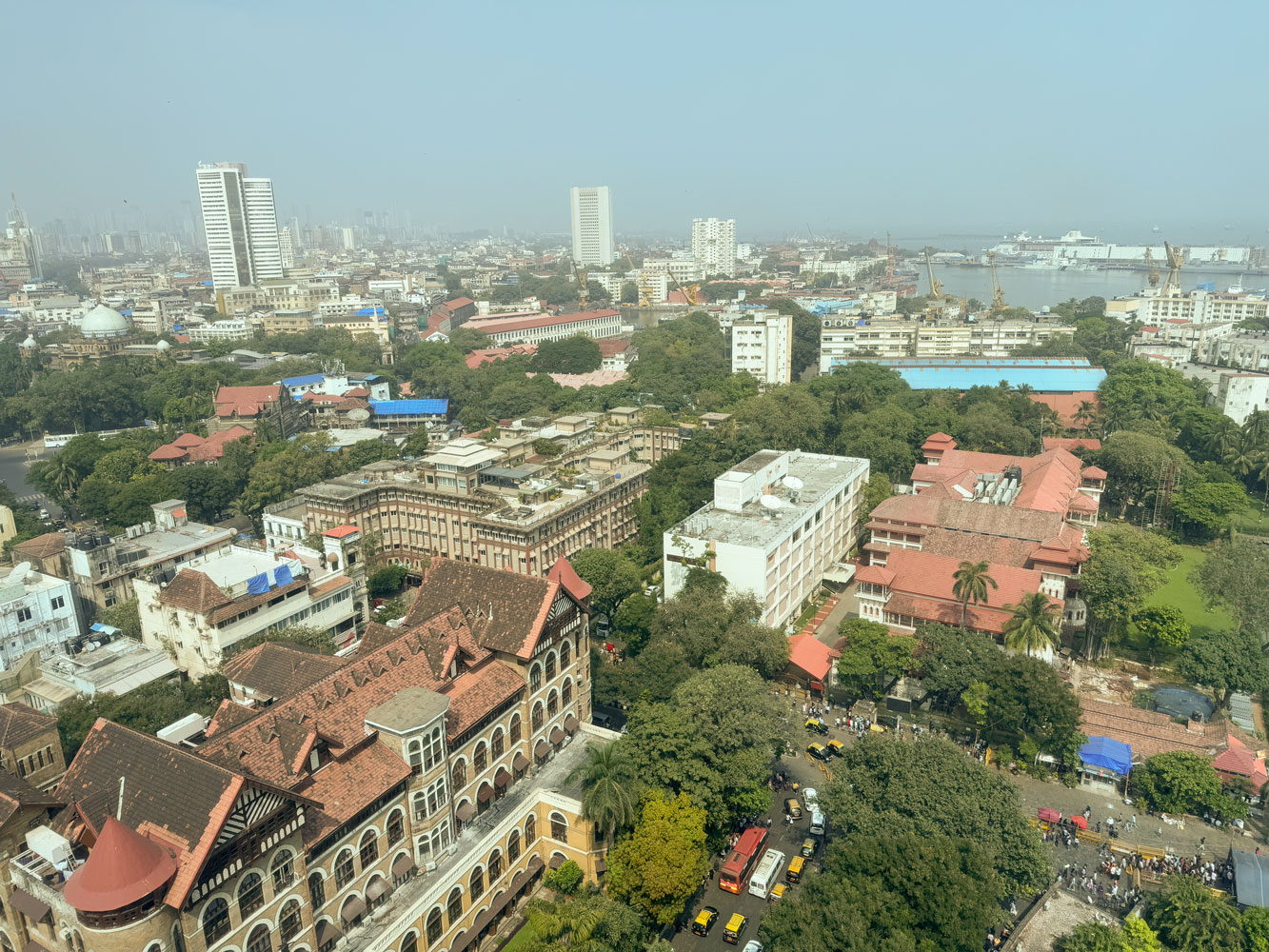
After lunch there was a planned visit to the Dharavi slum area, but the bus had an air conditioning problem so the excursion was postponed until the next day.
We took a nap and then went to the Italian restaurant for dinner, then to bed. That was the end of our day.
++++++++++++++++++++++++++++++++++++++++++++++
11/5/2024 (Tuesday, Mumbai) This is the last day of the tour. Judy and I will leave the hotel about midnight to go to the airport.
We were up about 6am, as usual. We went down to the lobby for breakfast about 6:45am and the lobby was nearly empty.

The statue in the lobby created a beautiful reflection in the morning light.
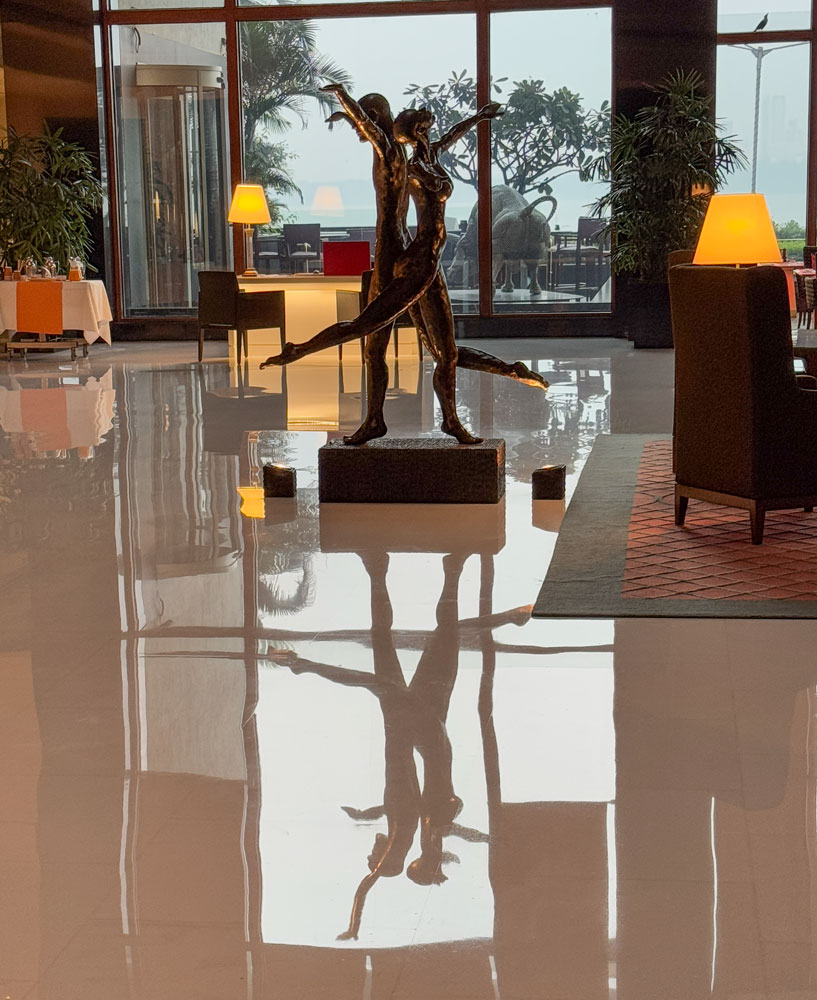
We met in the lobby at 8:15am and took the bus to the Gateway of India, where we'll board a boat to Elephanta Island to visit the caves there, the Elephanta Caves.
Here's some of our group at the Gateway. The boat dock is behind the Gateway.
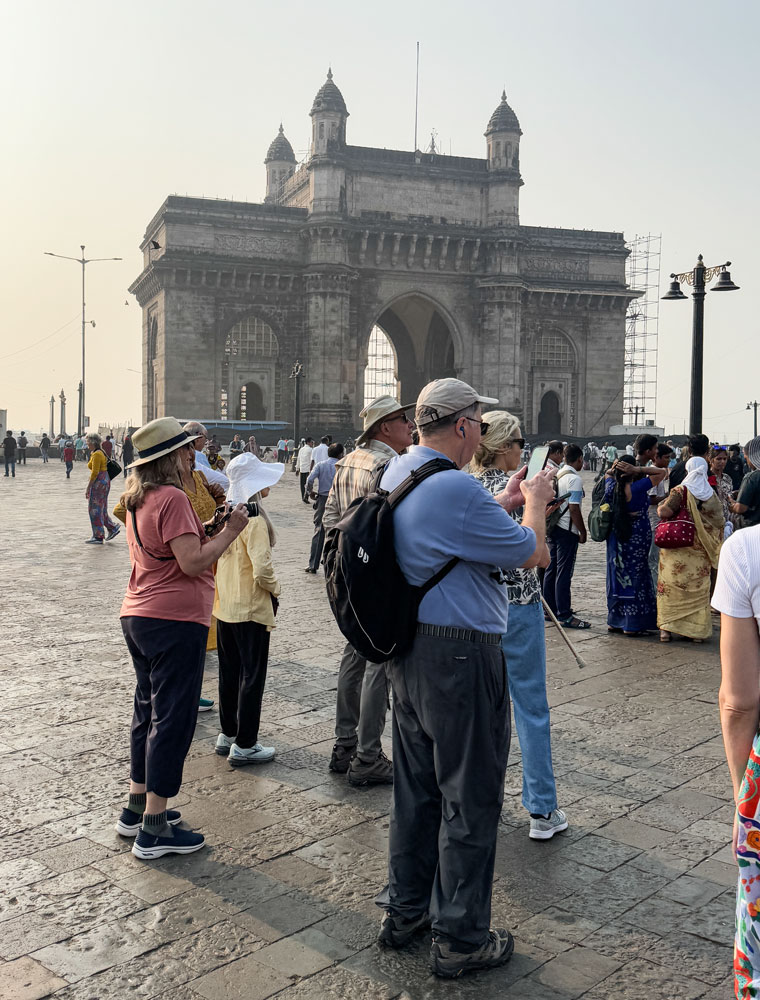
The boat we'll be on.
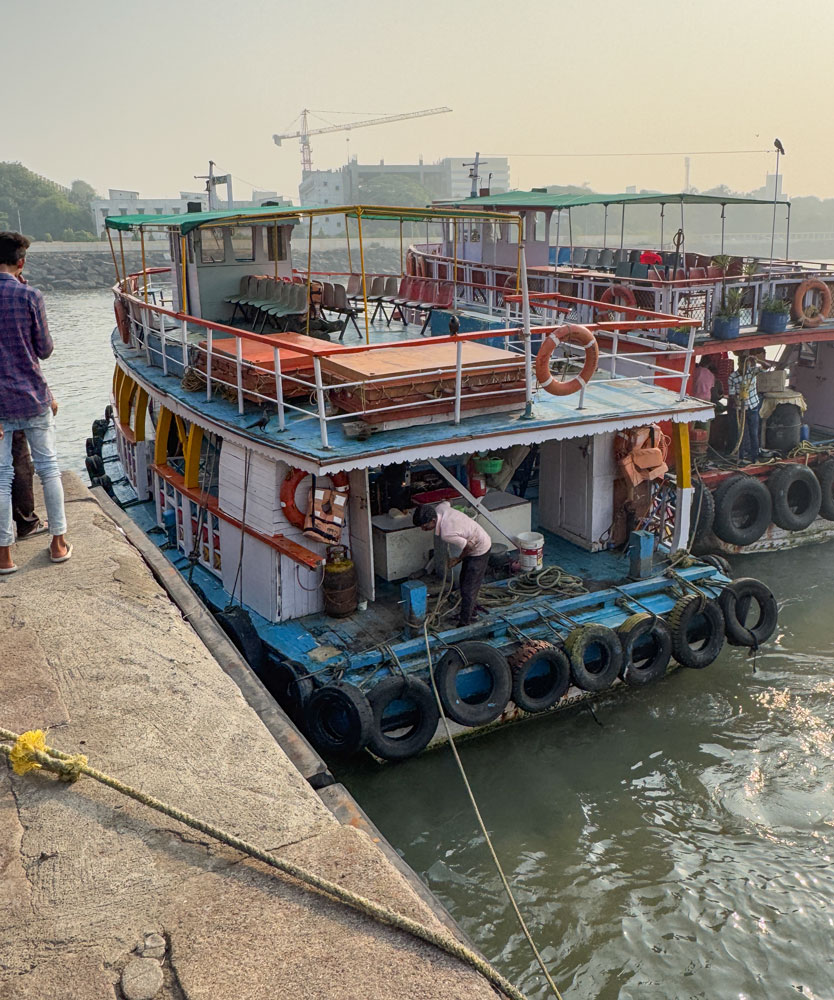
As we sailed from the dock, we were able to get a good view of the Taj Mahal Palace Hotel, both the old building (on the left), the new building (center), and the Gateway of India, which is one of the original points of entry to the city.
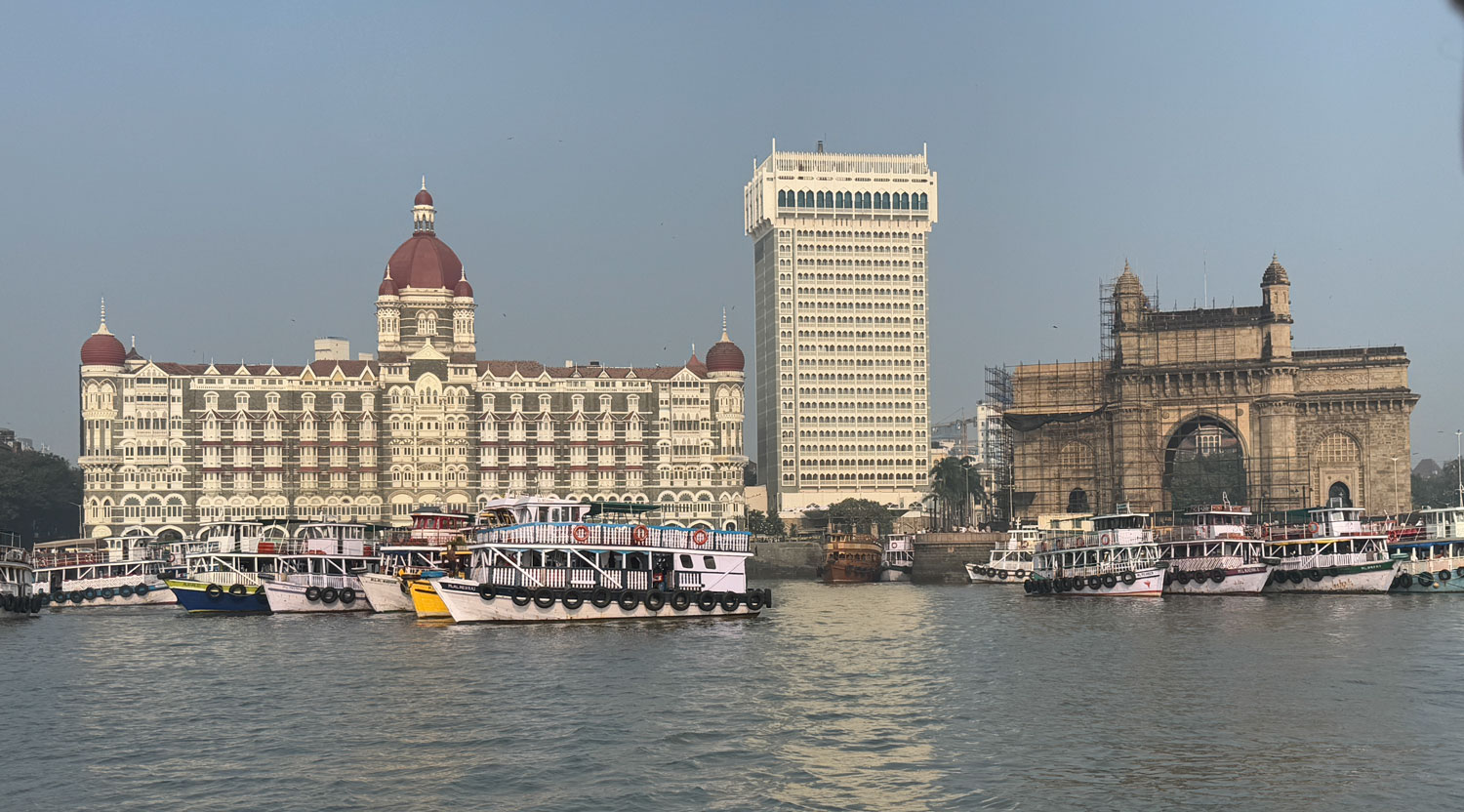
Elephanta Island is actually east of the Gateway, in Mumbai Bay. It took about an hour to reach the island.

When we arrived at the island, we found that there was a long jetty for boat docking. I suppose the water is very shallow close to the island so they had to build this jetty out to deeper water.
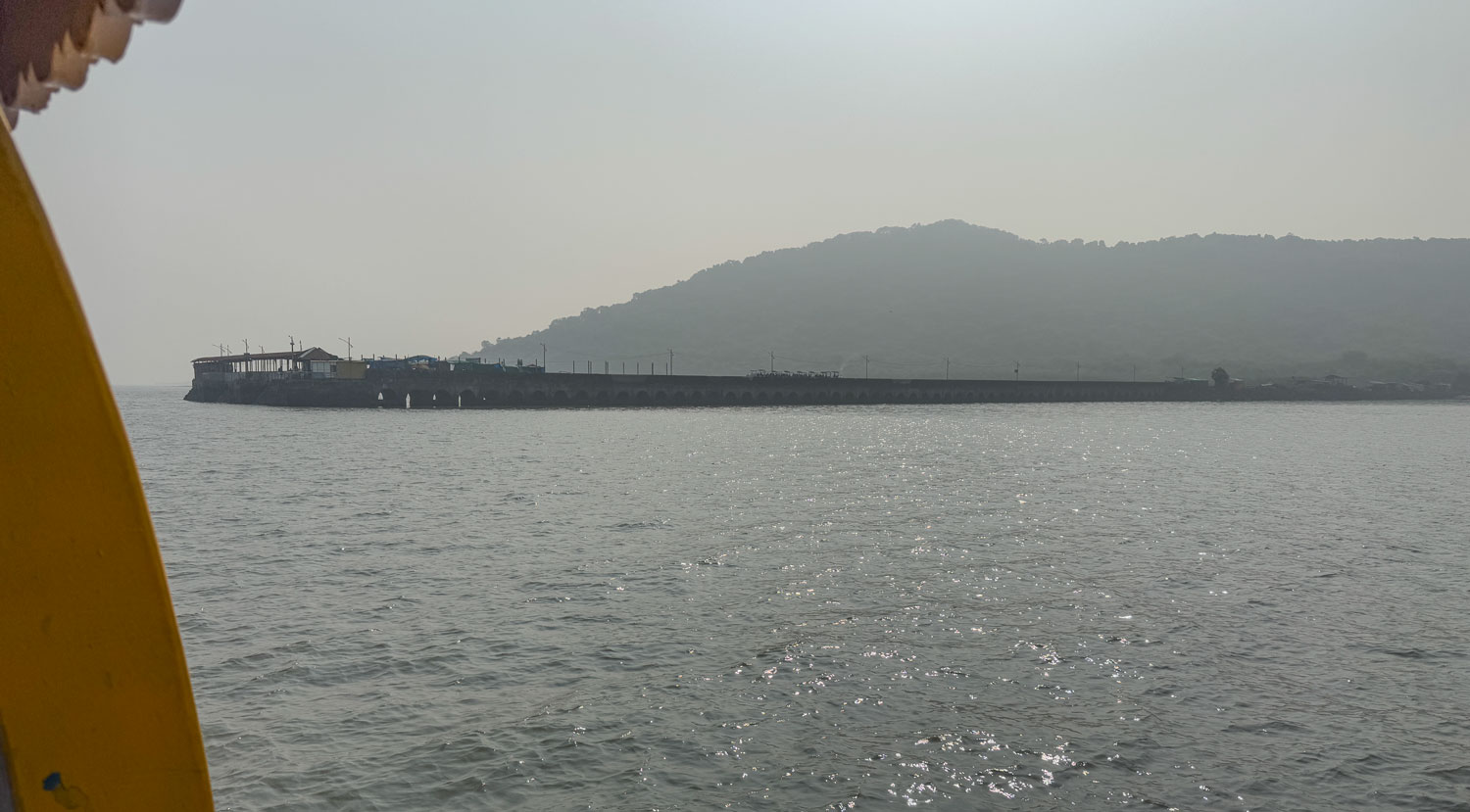
From here we could also see the Shri Atal Bihari Vajpayee Trans Harbor Link bridge. It's a very long bridge, the longest sea bridge in India.
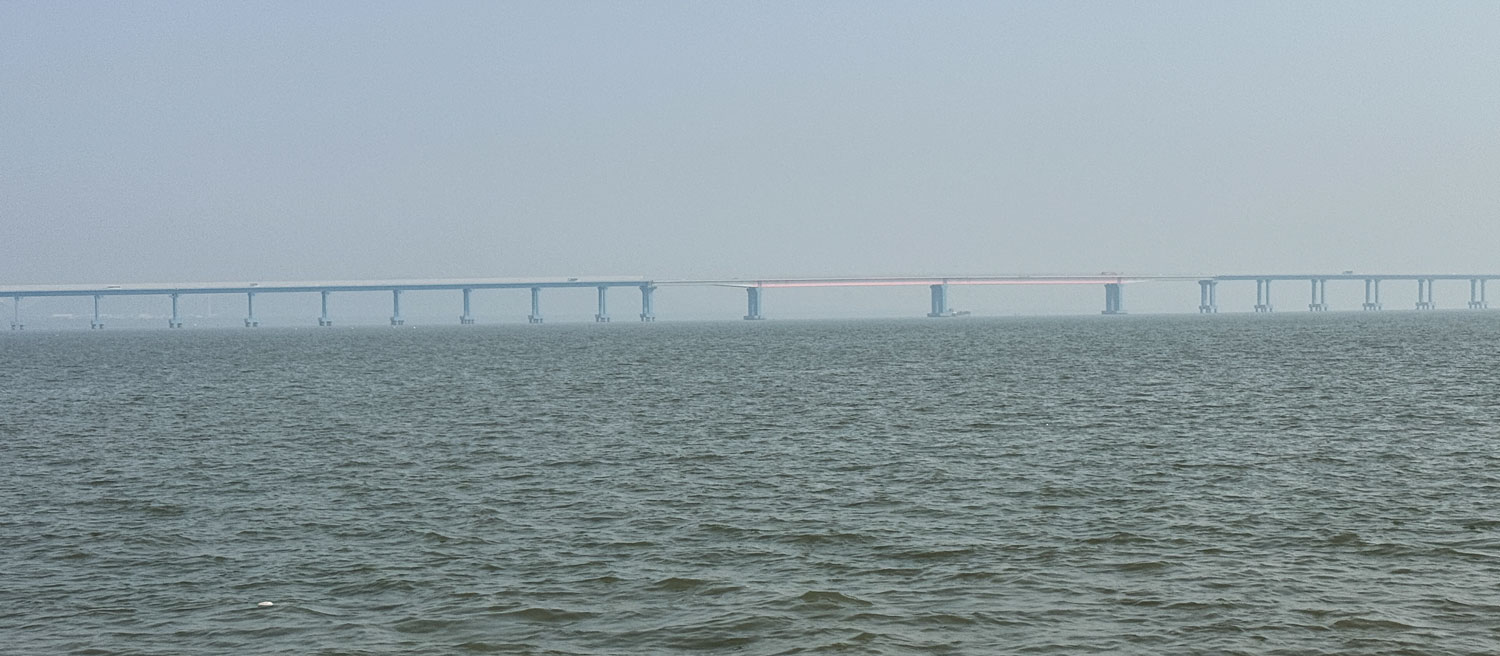
Incidentally, there's a lot of moisture in the air in Mumbai. It makes it difficult to get a good picture of anything distant.
This is the dock - just steps. Note the bottom steps are white - that's salt. I suspect high tide in the bay covers those steps, or at least splashes them.
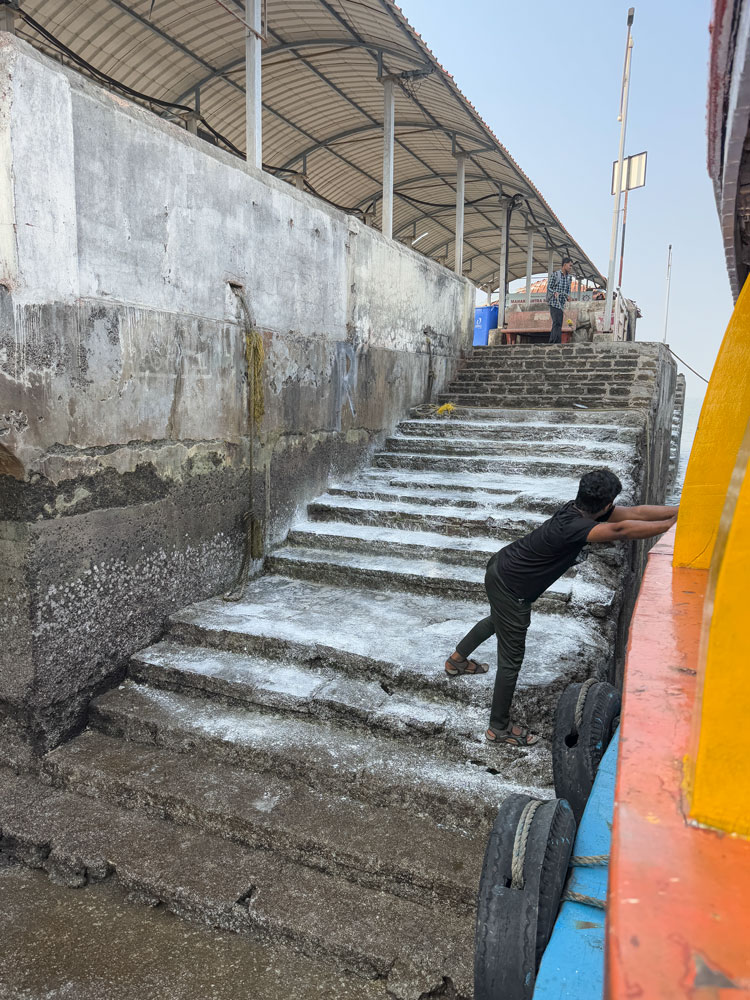
Here's a view down the jetty - it really is long.
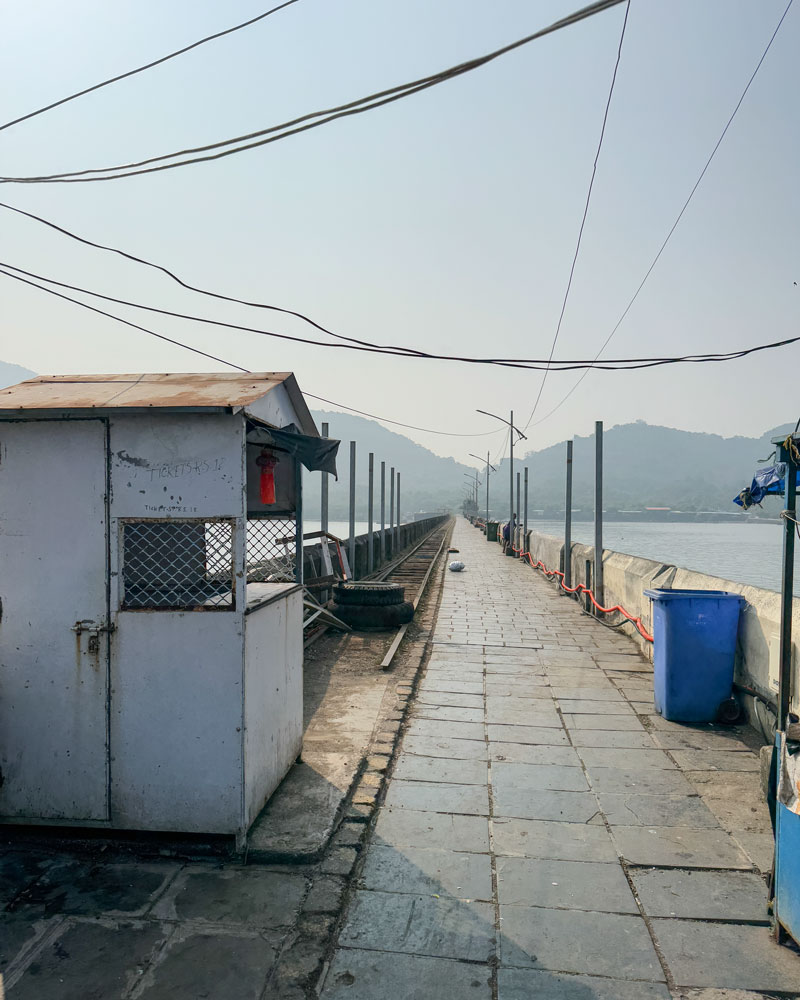
But here comes a "tourist train" that will take us to the island. You have to buy a ticket to ride on it, which Annie did for us, so I don't know how much it is. I doubt that it's very expensive, but some of the local people walked rather than board.
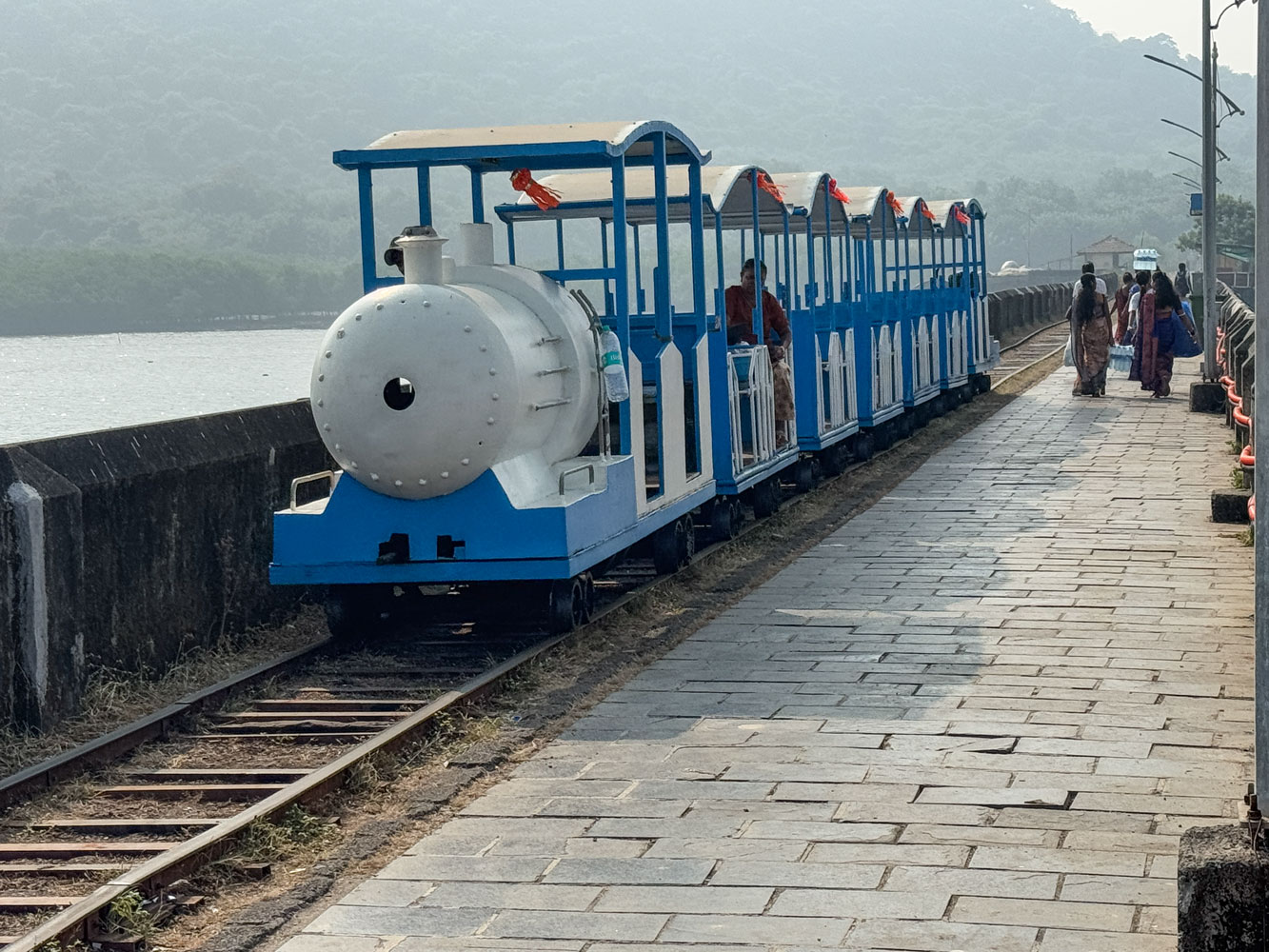
A view of the cars. Its a very simple train.
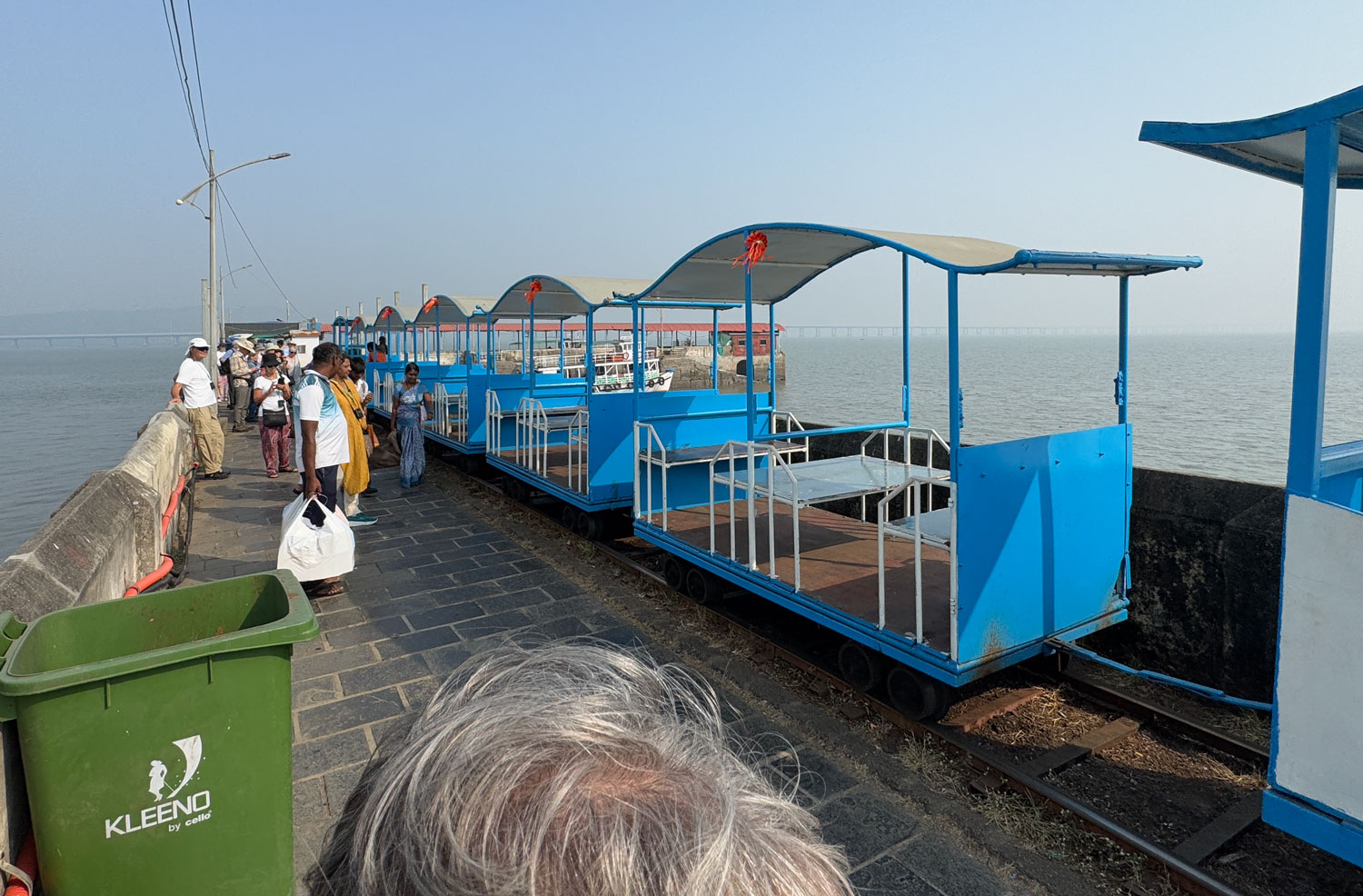
We gathered at this cafe at the foot of the stairs to the caves. There are 120 steps up to the caves. Note the guys with the blue chair. Four of them will carry you up to the caves and back down for ₹2,500. Judy and I decided not to walk the stairs, or to ride the sedan chair, so we waited in this cafe.
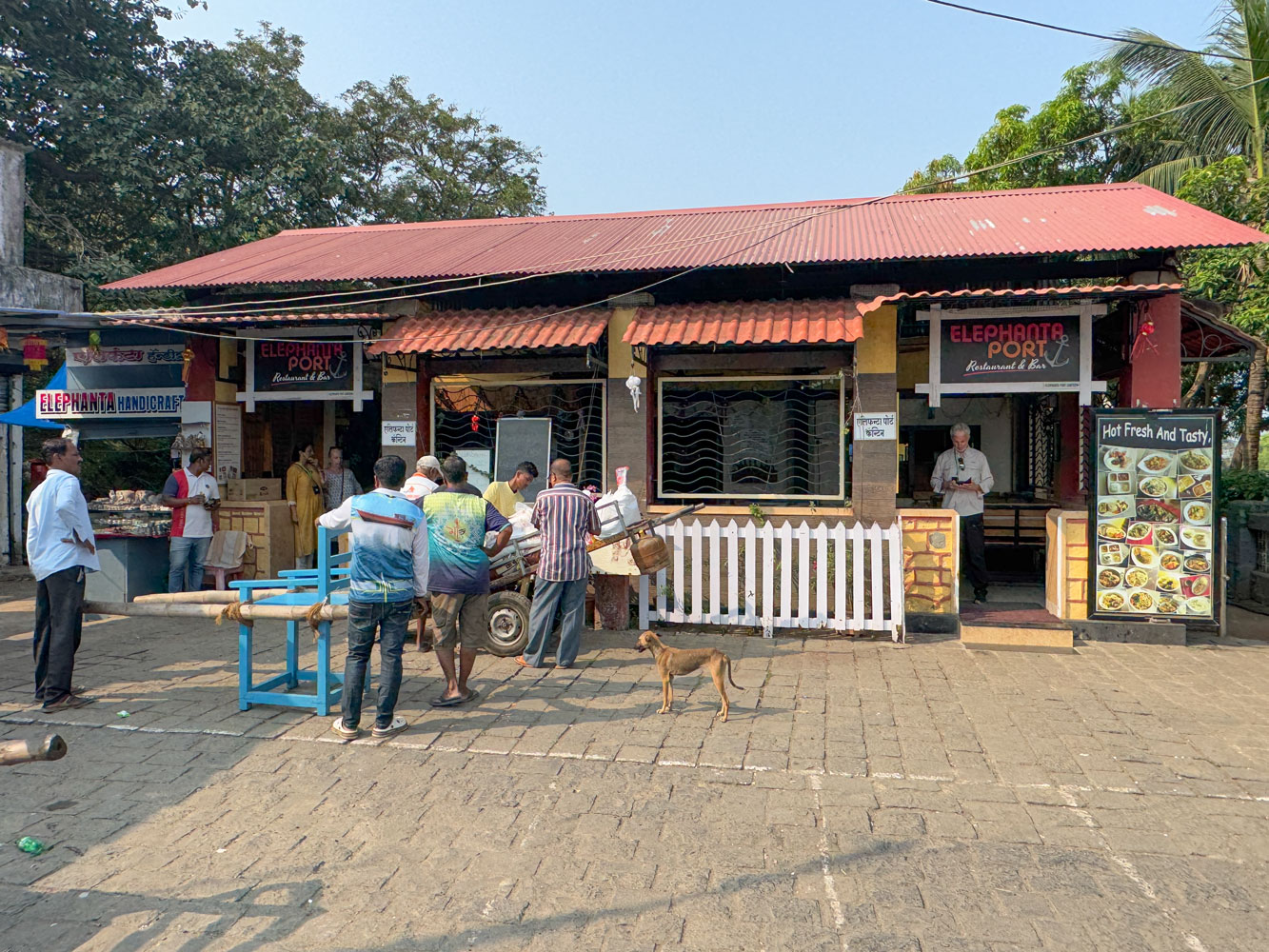
A couple of people in our group used the chairs. Here's one.
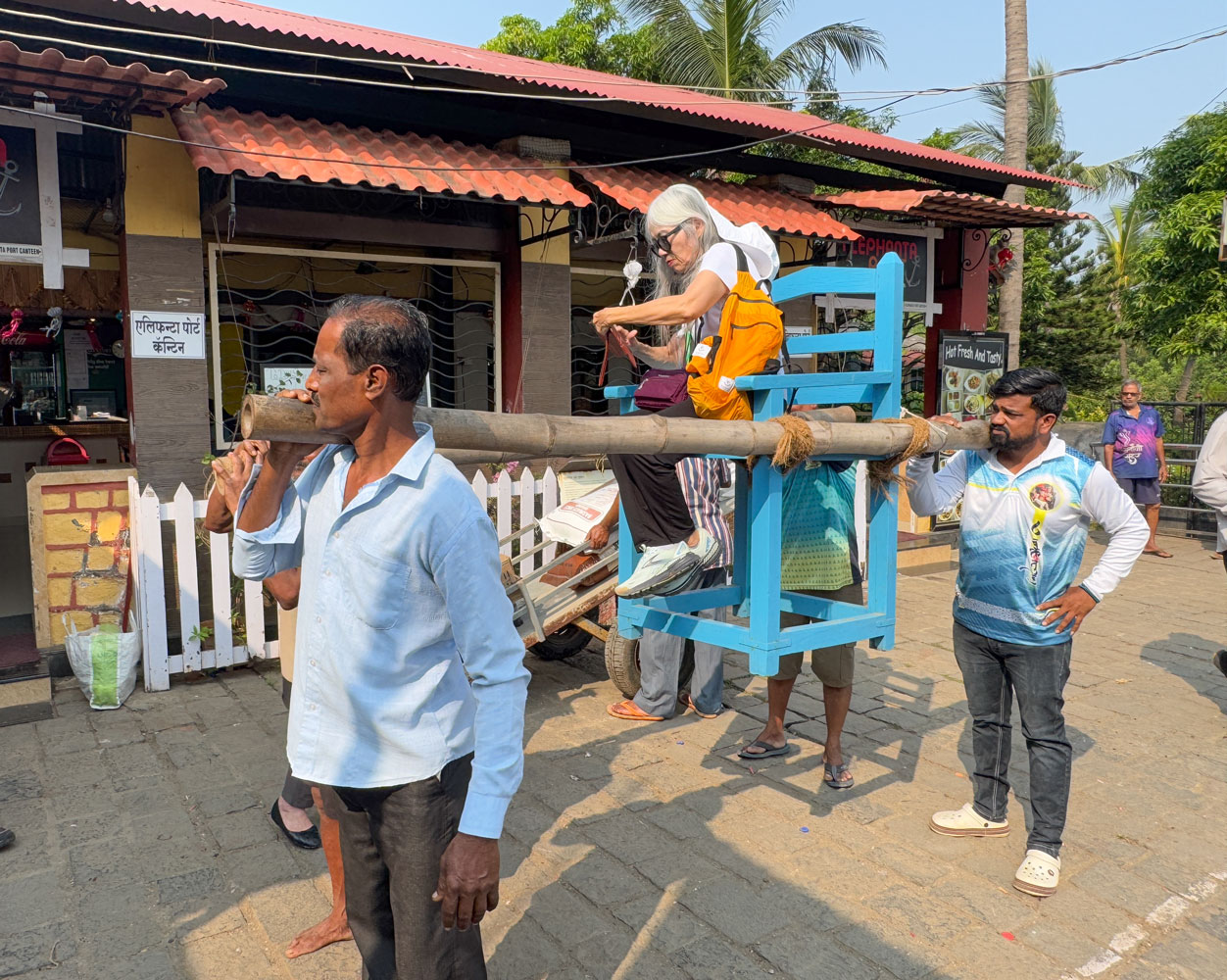
This map of the island shows the caves. You can see the jetty where we docked. The path to the caves starts almost at the end of the jetty.
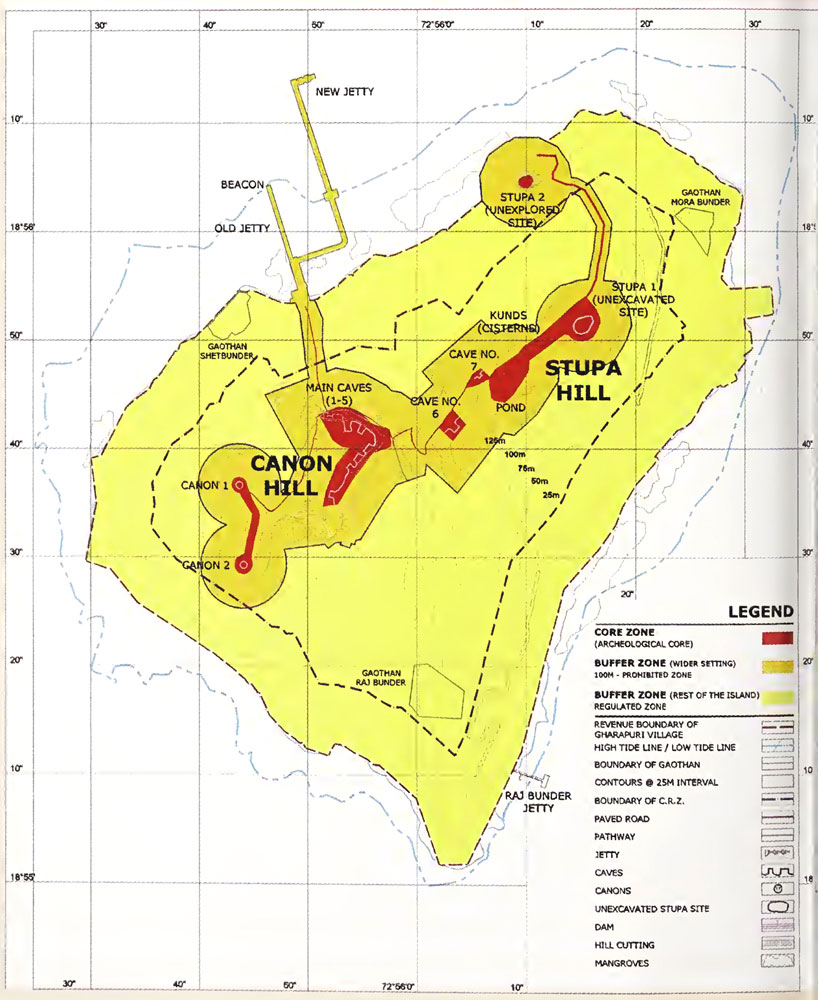
The main cave is cave 1, the entrance of which is shown in this picture.
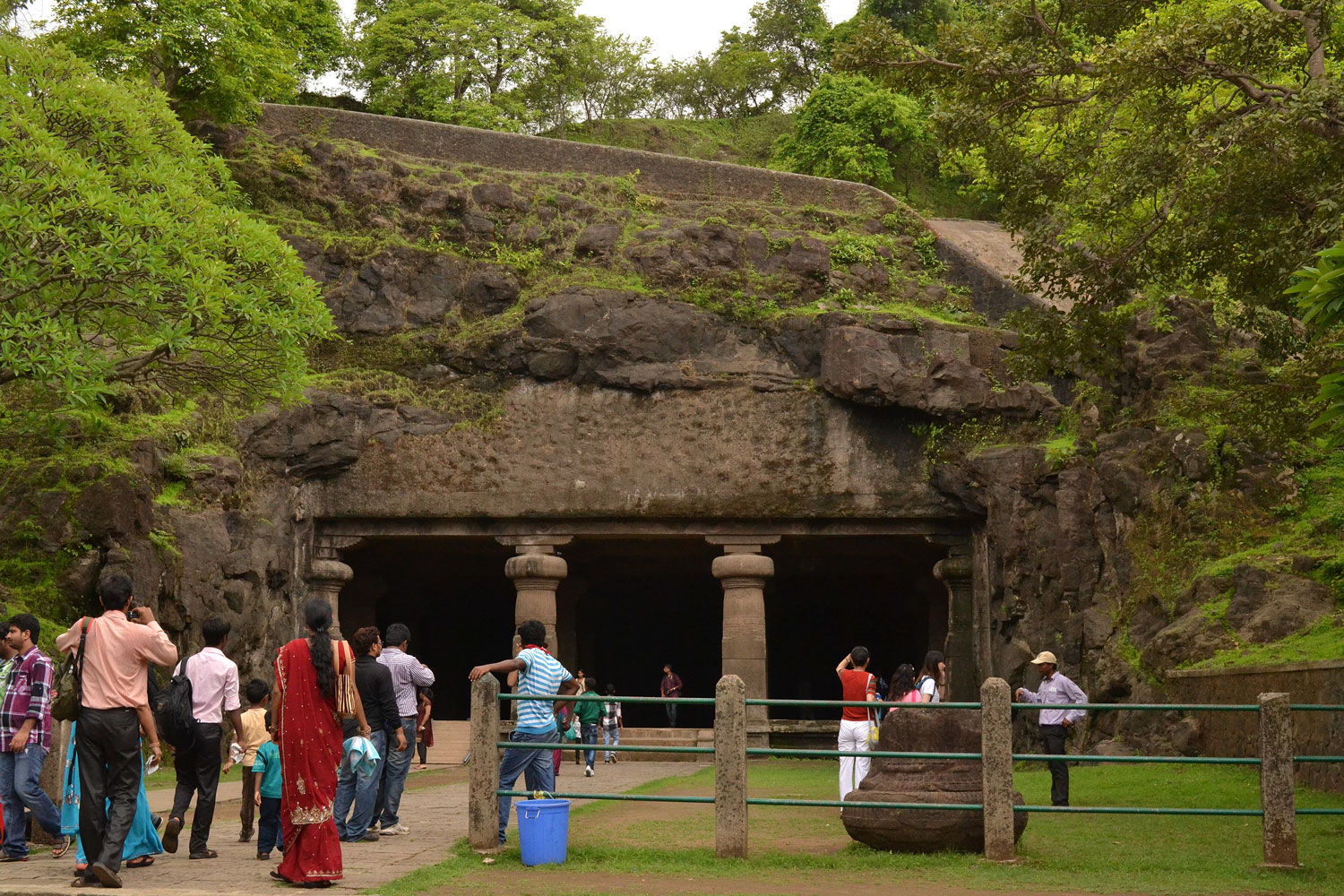
Just inside the entrance.
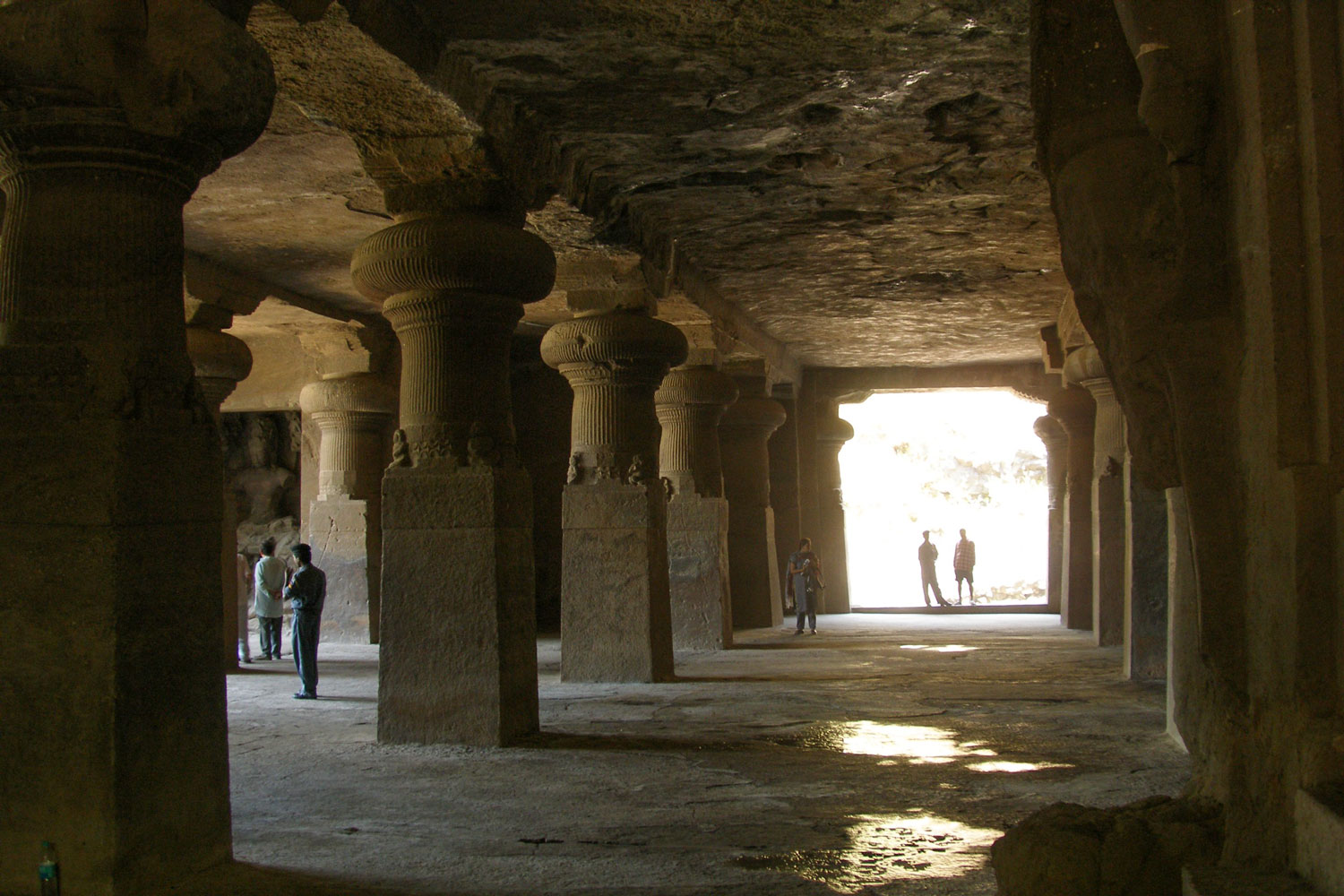
The caves contain much statuary, but a lot of it has been damaged.
Here's Timurti Shiva.
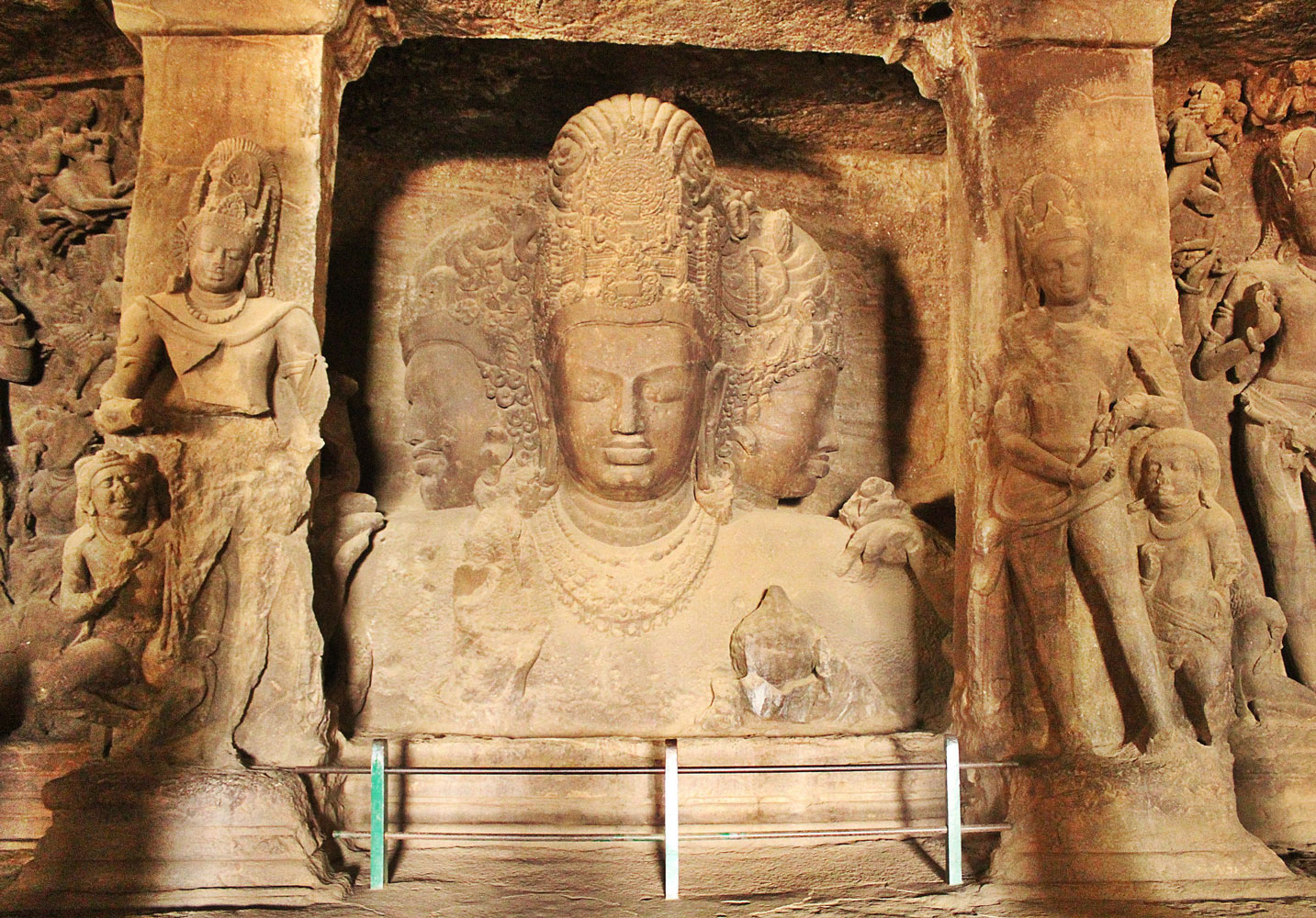
Nearby is Ardhanarishvara, which represents the interdependence of feminine and masculine attributes in the universe.
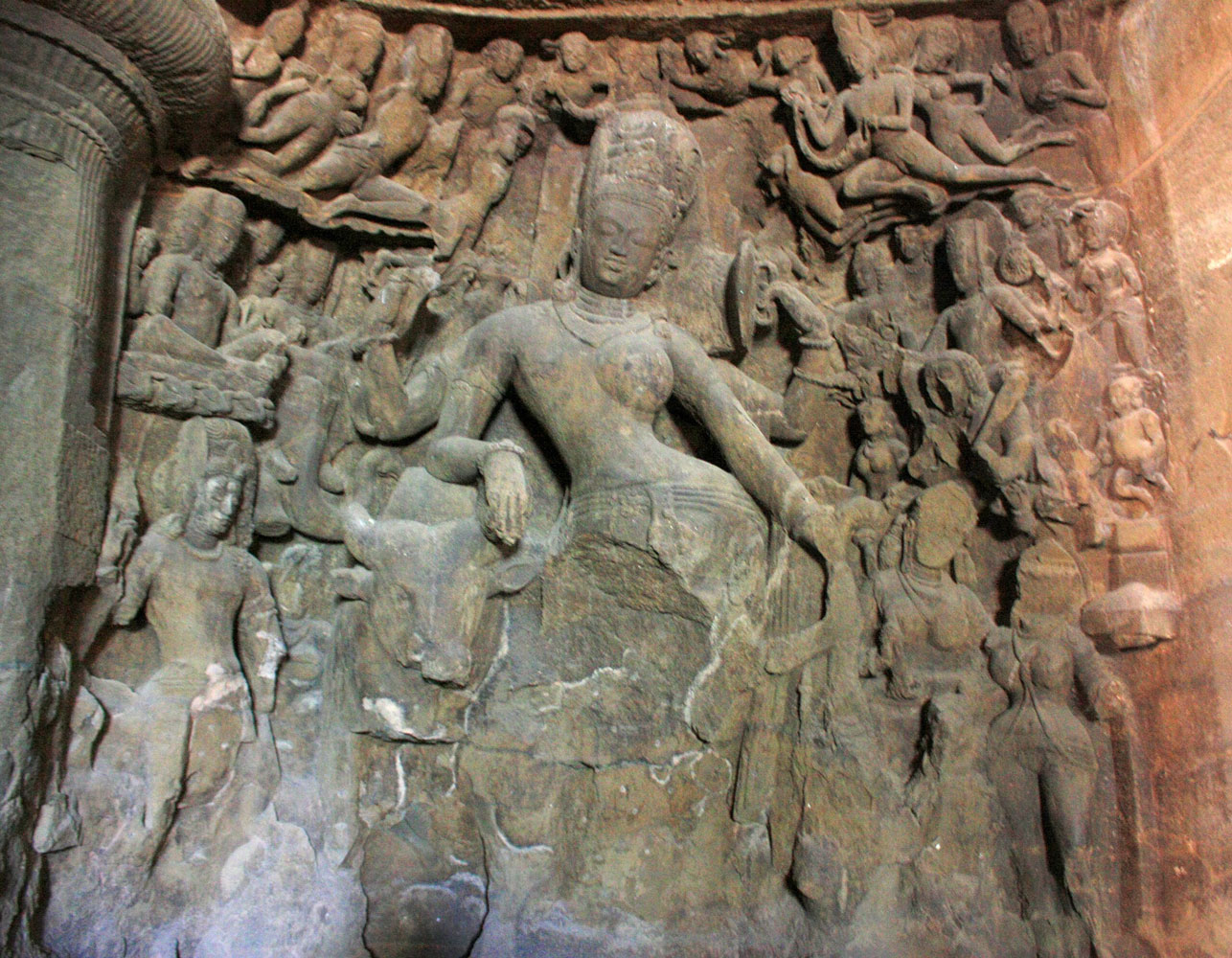
You can find more pictures and an extended description of the caves at the Wikipedia article I linked to. Also, do a Google image search on "Elephanta Caves" for more pictures.
Judy isn't fond of climbing long flights of stairs. I suffer from the heat and knew that climbing that many steps would likely cause me to overheat, so we both decided to wait at the base of the steps while the rest of the group visited the caves. I suppose we could have used the chairs, but our interest level wasn't very high. I think we had excursion fatigue - too many excursions in too short a time.
The pictures of the caves I posted are from the web and more are available there.
Here we are in the cafe.
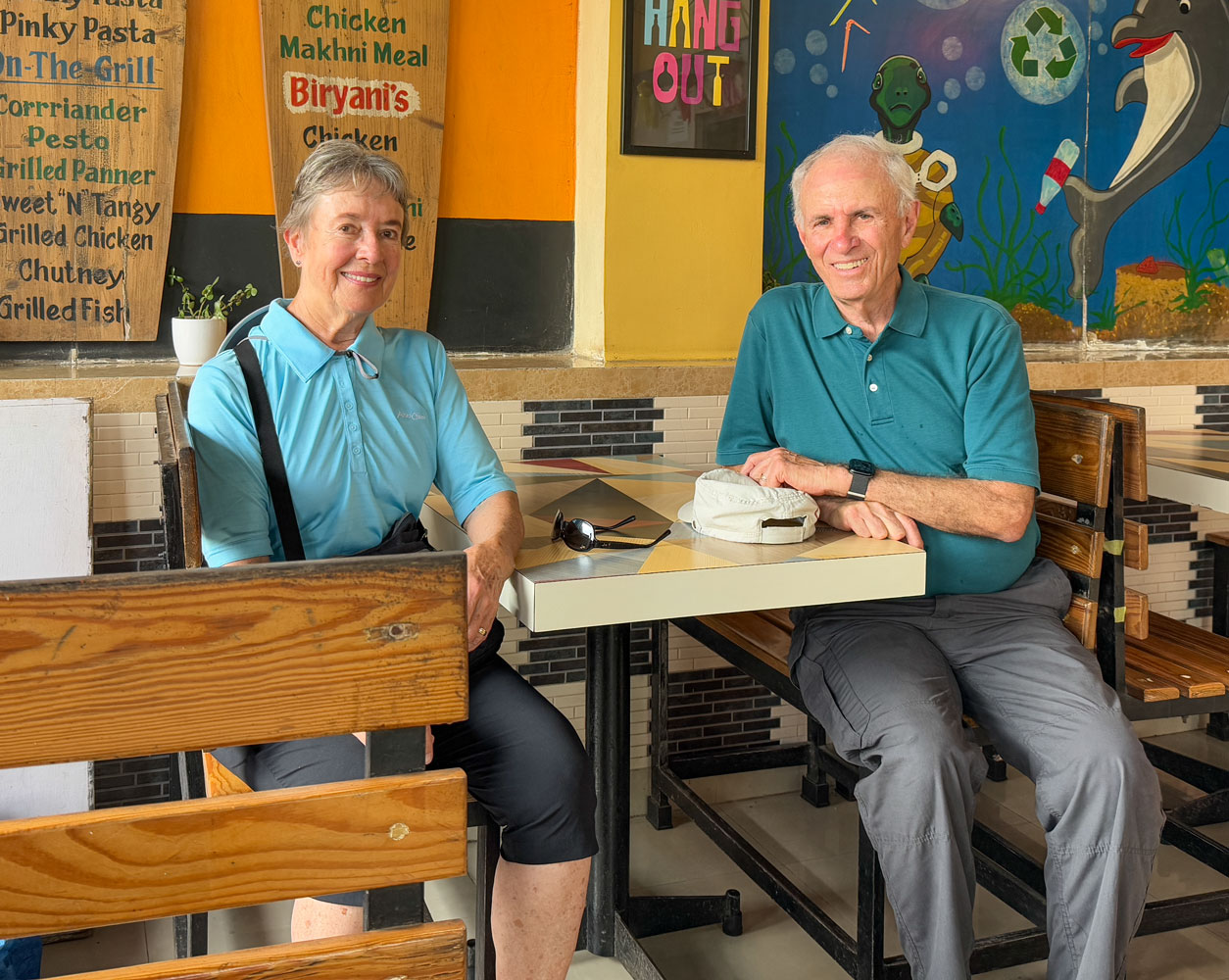
When everyone returned from visiting the caves, we took the little train back to the dock, boarded the boat and went back to where we started. I was able to get a better picture of the Taj Mahal Palace Hotel as we pulled into the dock.
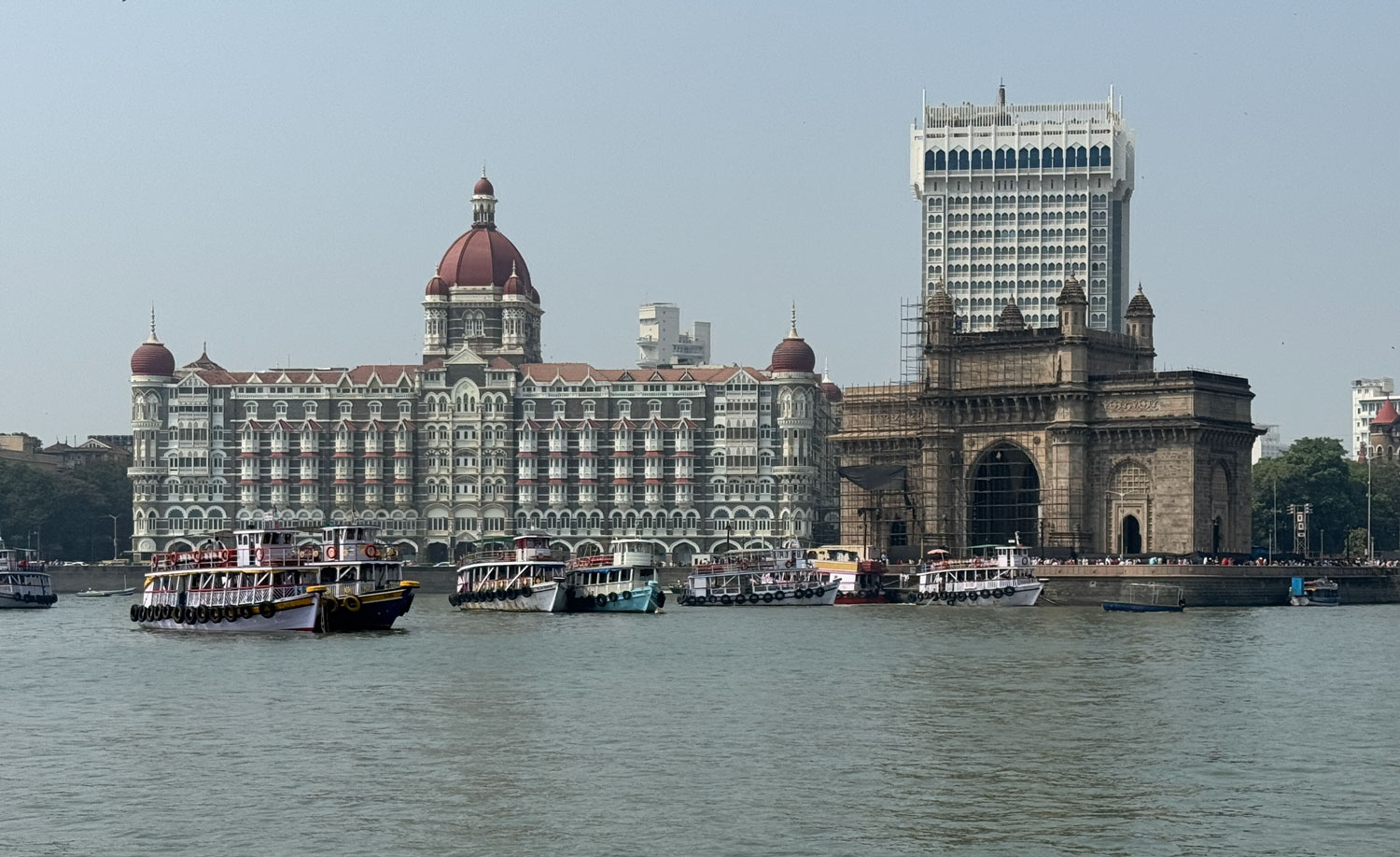
Annie had rescheduled the visit to the Dharavi slum area as soon as we returned, but most of us skipped that excursion and went back to the hotel. I think it was the heat, plus the fact that it was the afternoon of the last day. Additionally, we were told that photos would not be allowed during the excursion. For me, with this blog, that was a killer.
Dharavi is not very big - less than one square mile - but has a very high population density - as many as one million people may live there. Its origin goes back to 1881 during the British colonial period. It was initially established as a place for tanneries, which are polluting and smelly, but now there are a number of different small-scale industries there, including pottery and textiles. It grew as poor rural Indians migrated to the city for work.
As with most slums, it grew without any plan or provision for safe drinking water, sewerage, drains, roads, electricity or other normal city needs.
Here are some pictures from the web. Looking over the slum.
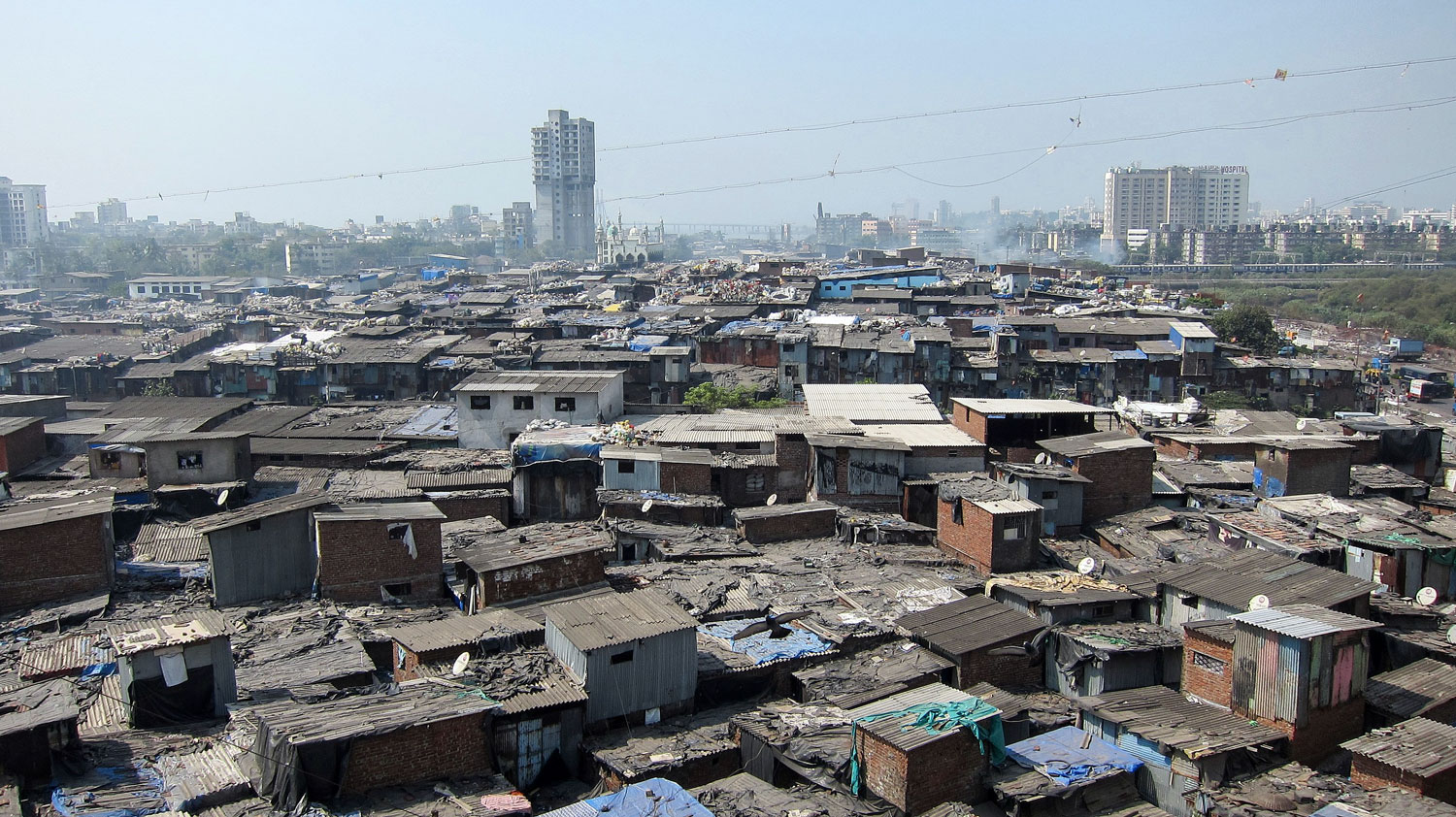
Some residences built along a canal. Those may be outhouses sticking out over the canal.
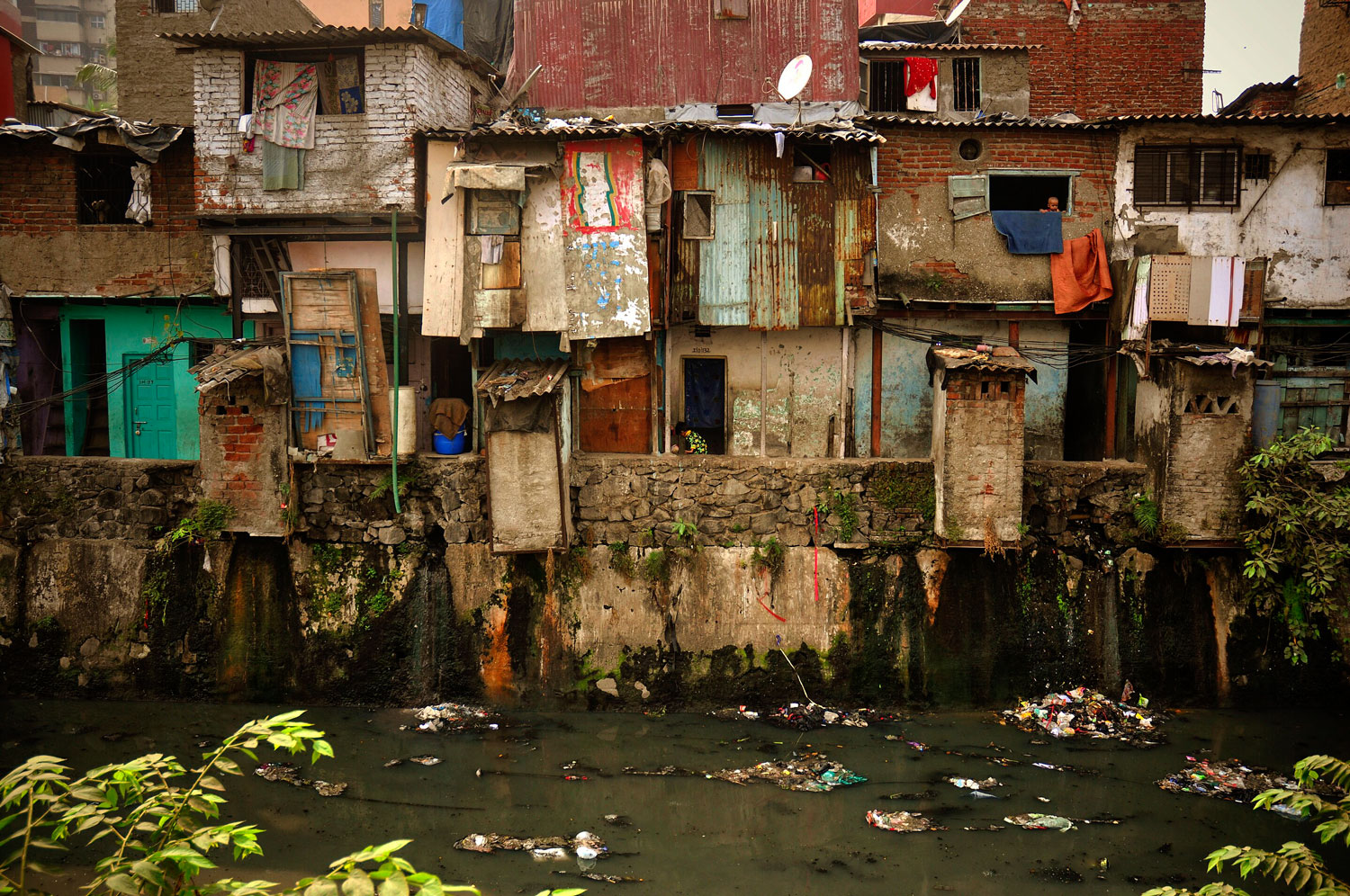
A pottery business.
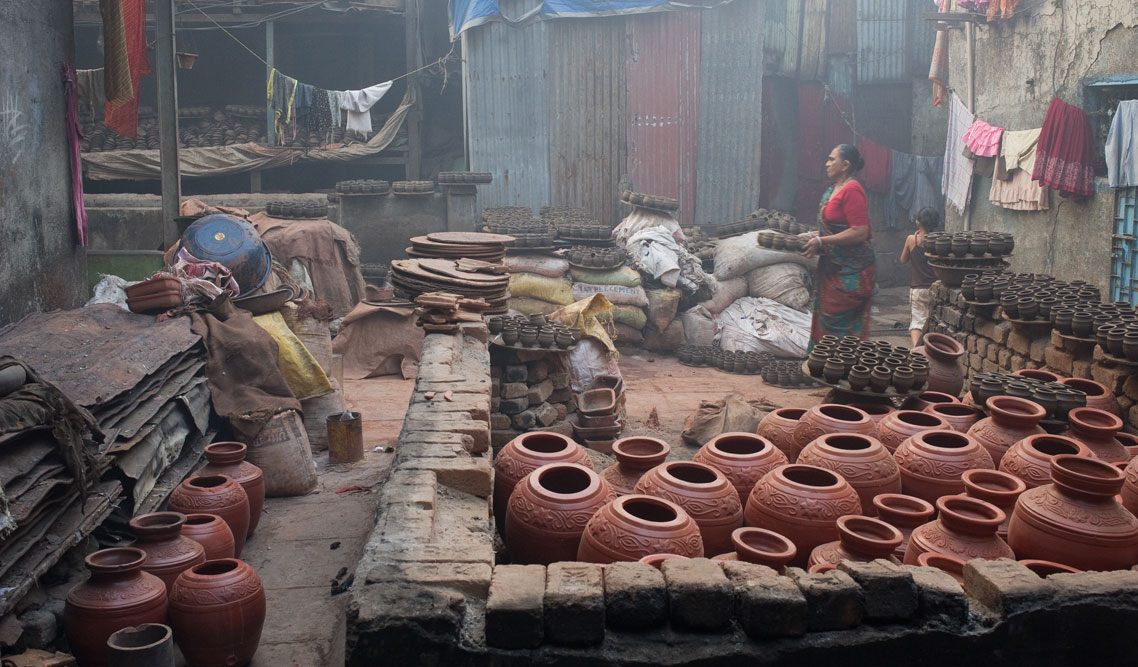
Several commuter trains run through the slum, providing a way for the residents to get to jobs outside the slum.

There is a plan to completely redevelop Dharavi, similar to what was done with the Kowloon Walled City.
That evening we had the farewell dinner. Here we are at the opening reception.
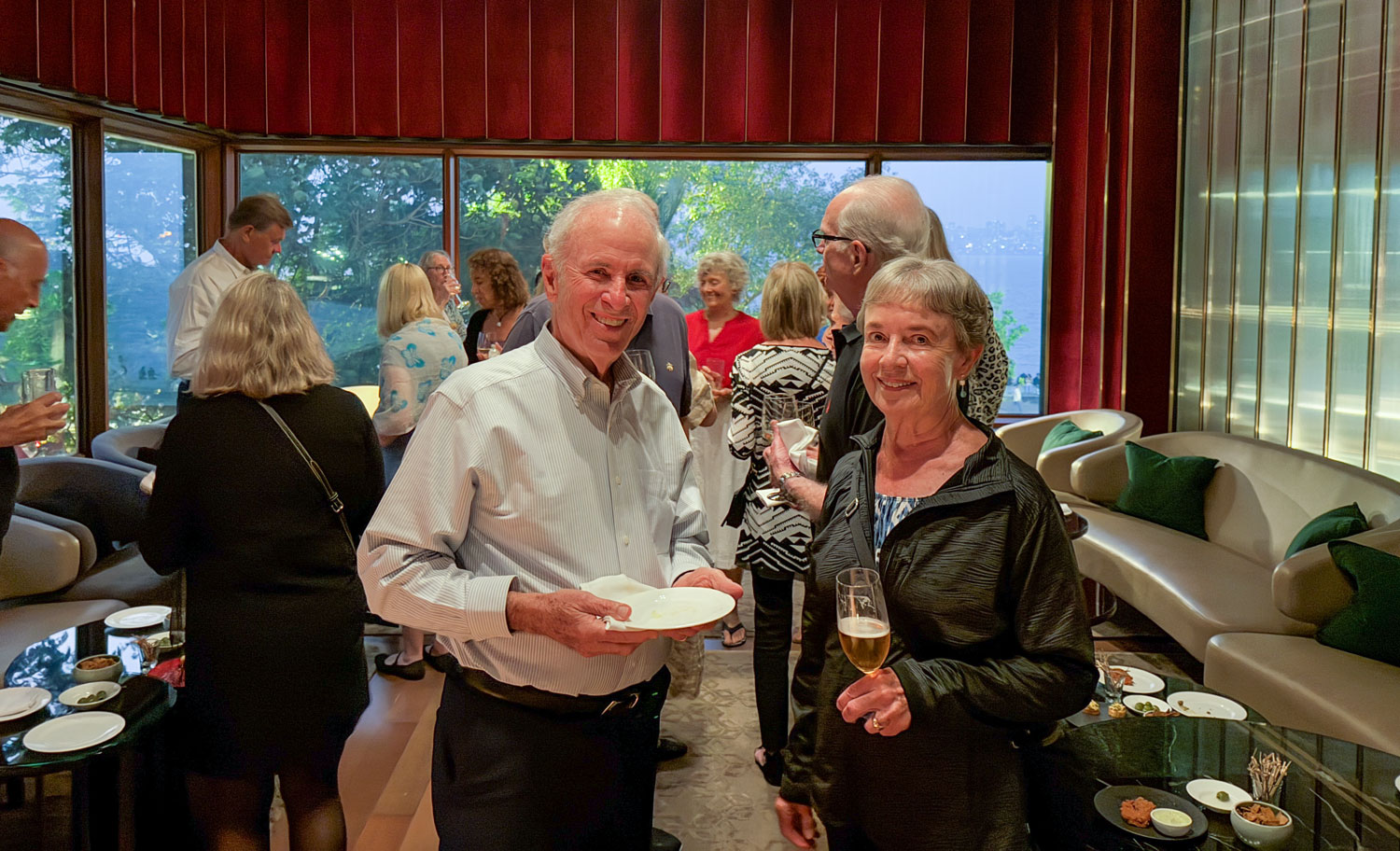
The hotel set a very nice dinner of Indian dishes.

When dinner was over, we all went to our rooms to prepare for departure. Some people have an early departure and some are staying for an additional day. We depart just after midnight - our flight is at 4am.
++++++++++++++++++++++++++++++++++++++++++++++
11/6/2024 (Wednesday, Mumbai to home) The tour is over but we now have to travel home. Bag pull was at 12:15am and the transfer staff was right on time. We went down with the bags and went out to the car.
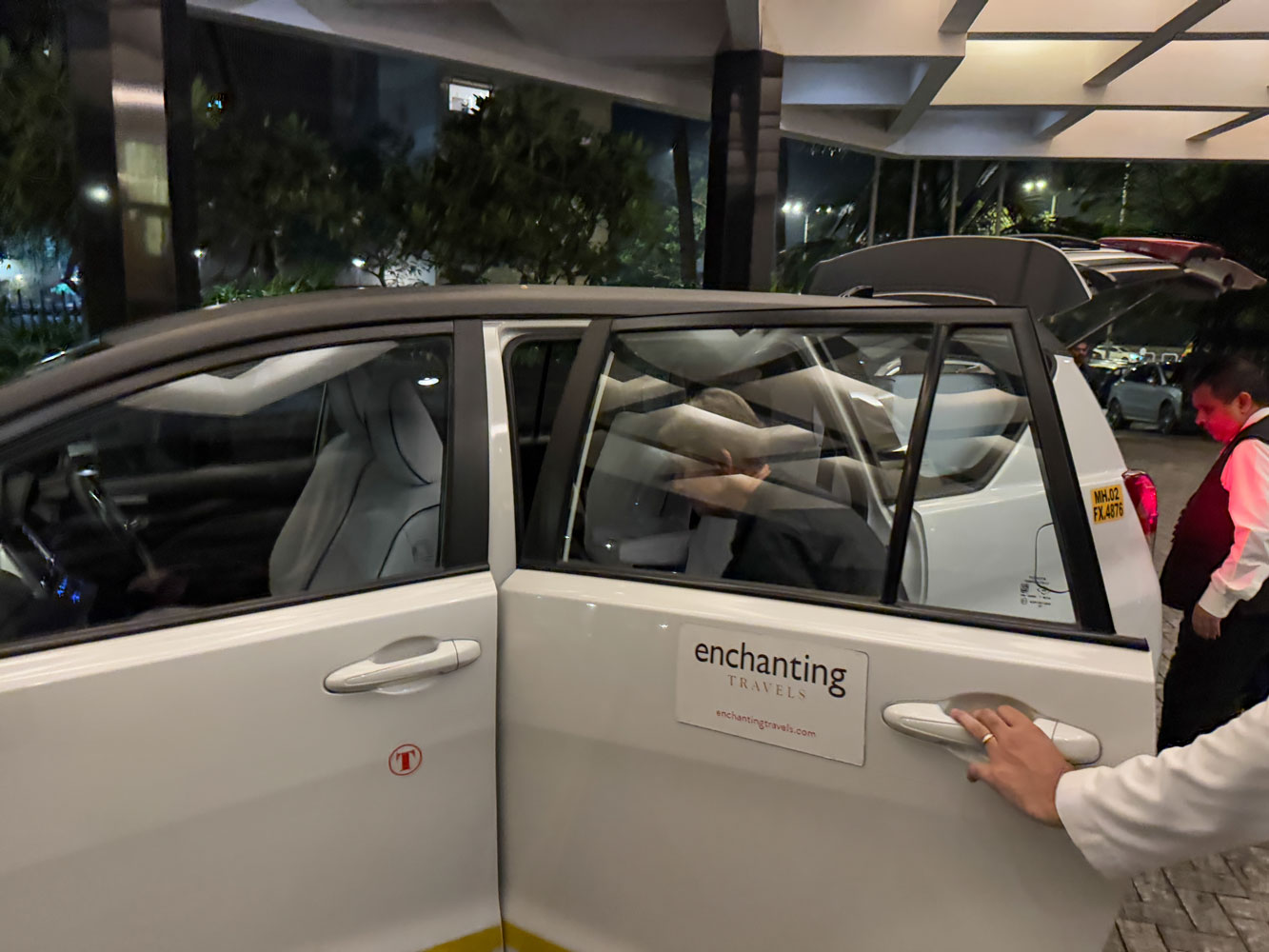
At this time of night traffic was lighter, but there were still a lot of people on the road and it took us about 40 minutes to get to the airport. The airport appears to be fairly new. We arrived at Terminal 2.
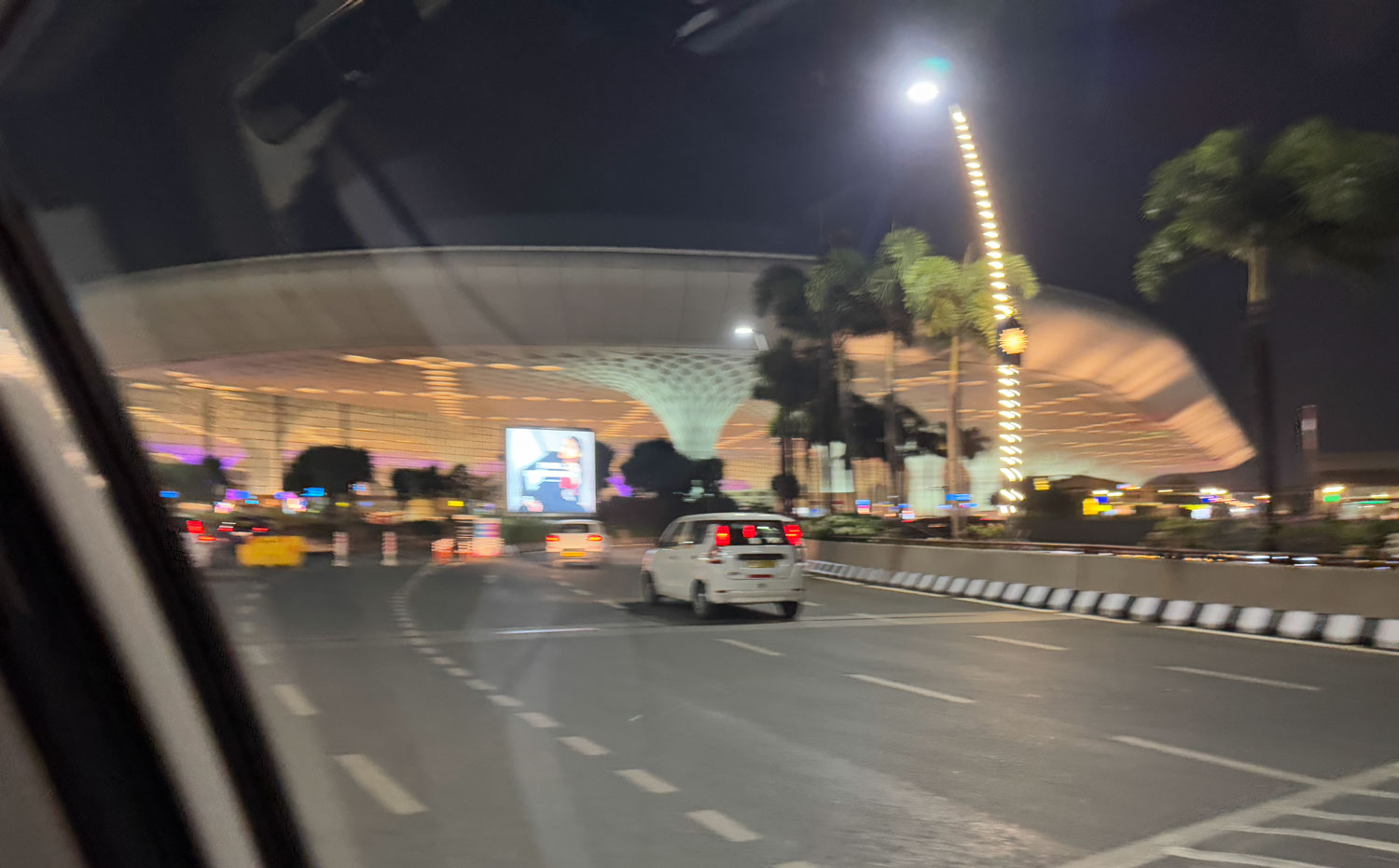
Terminal 2 is very modern. Here's a better picture of the terminal, taken from the web.
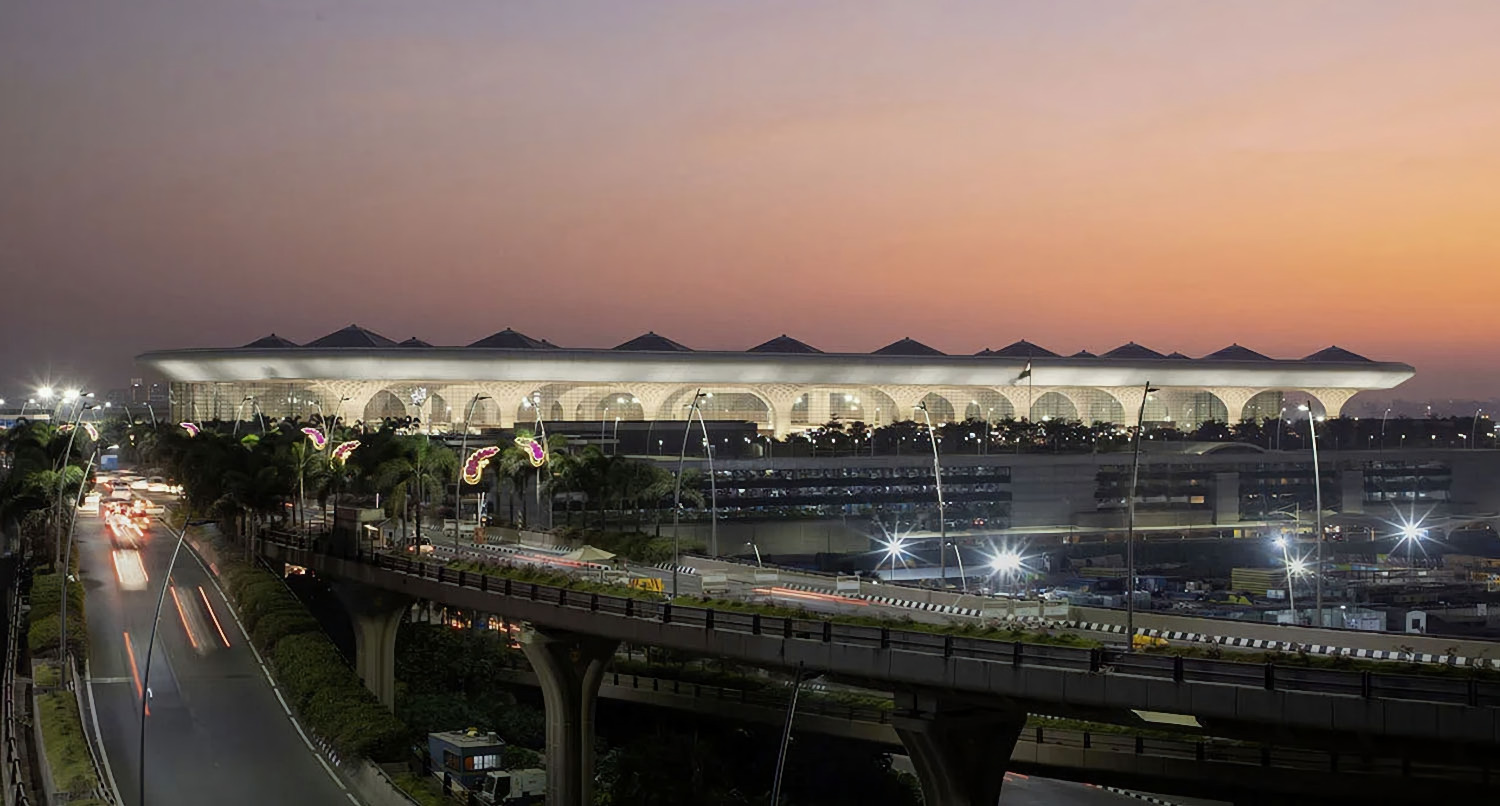
We cleared security fairly quickly but then had to go through passport control, and there was a long line to get through that. Our flight didn't depart until 4:10am so we had time. By the time we got through everything we only had about an hour in the lounge before we had to go to the gate.
The aircraft was an Airbus A-350, which is a nice plane. We departed about on time, and the flight was four hours to Doha.
The Doha airport is nice and modern. They have an unusual sculpture in it - "Lamp Bear". Don't ask me what it means.
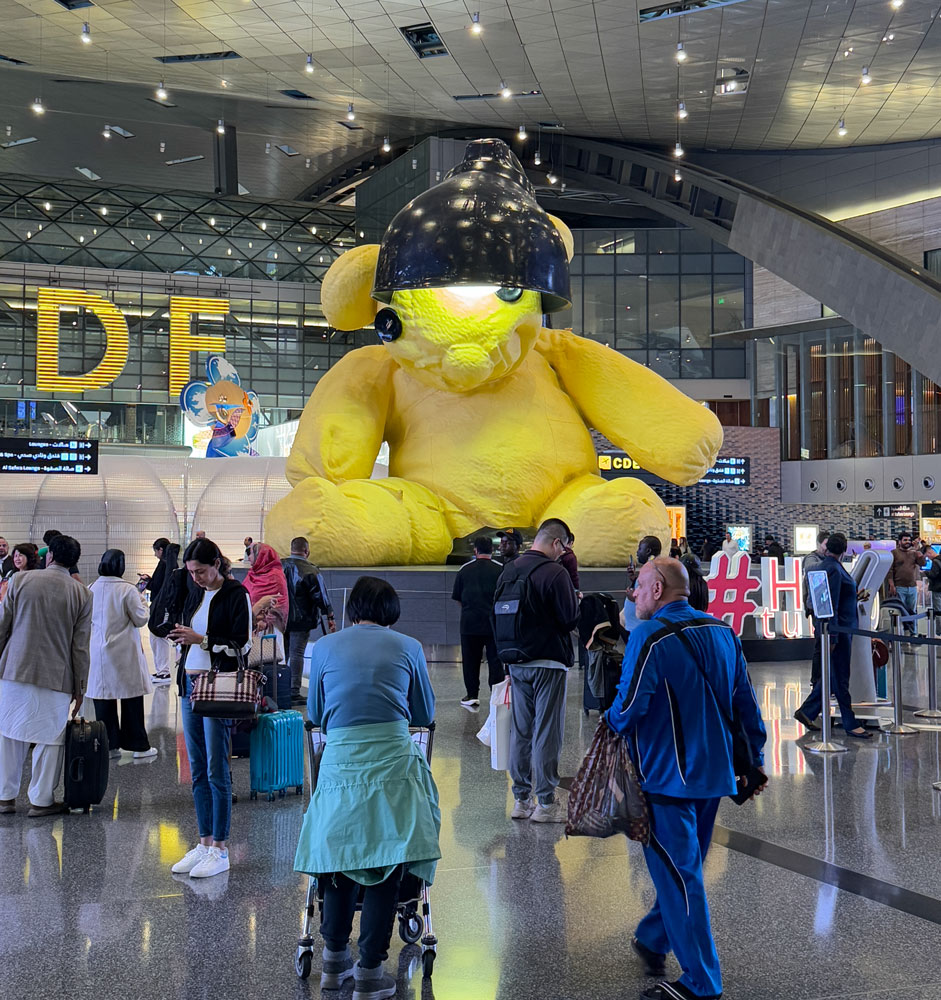
We went to the same lounge we used on the way to India. When it was getting time for our flight we went to the gate early - we had been warned that there would be secondary security screening at the gate (for flights to the US). Boarding was a bit slow but we eventually boarded and got settled on another A-350, and the flight took off on time. We managed to get a few hours sleep during the flight and I "speed watched" a few movies.
Qatar Airlines does a good job. About 16 hours later, we arrived at LAX around 12:30pm local time.
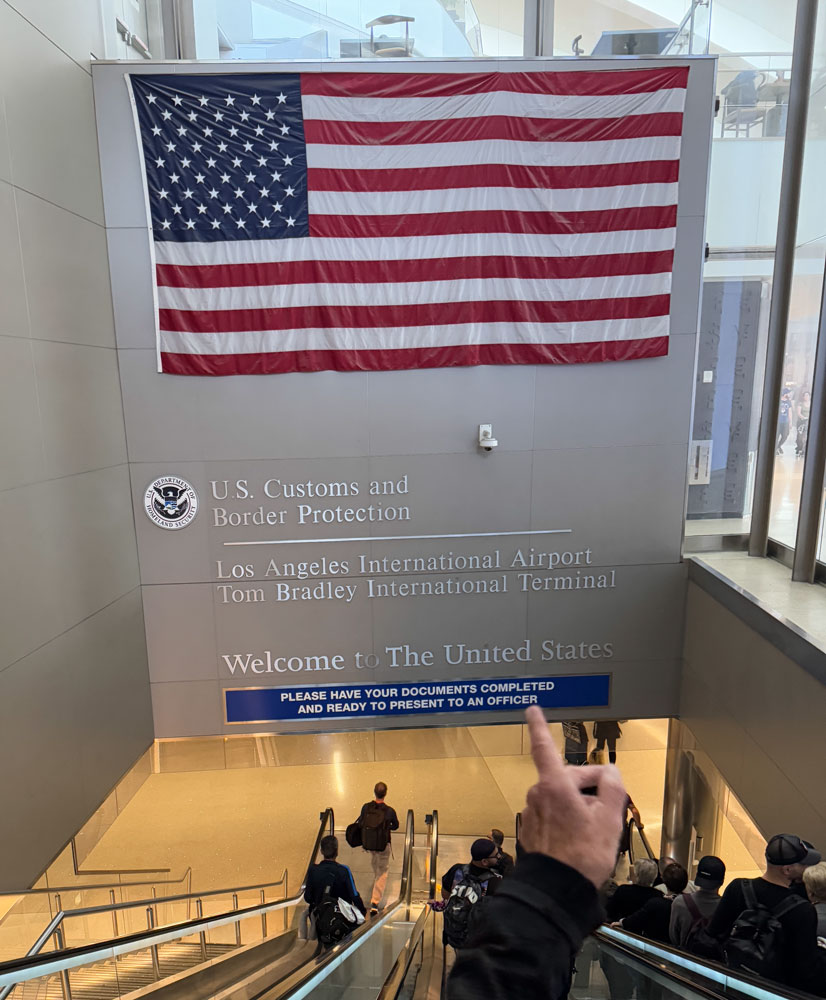
Global Entry made getting through passport control very quick and our bags made it fine. The bags had AirTags so we could see that they were in LAX.
We met our driver Juan (JJ), and the drive through LA traffic wasn't too bad. Bad traffic starts about 3pm.
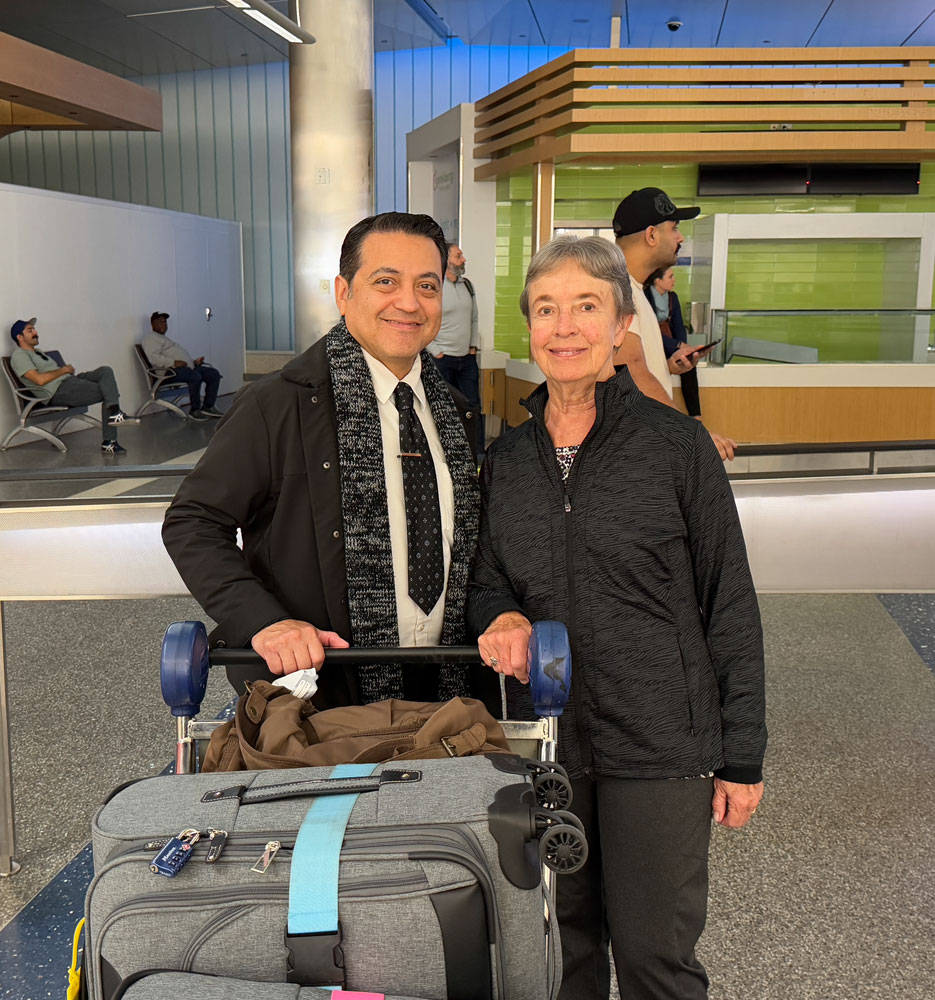
Greg and the girls (our two wonderful dogs) were waiting for us. We started unpacking and Judy started the laundry.
I realized that I had left my jacket in the limo. I had Juan's cell phone number and he found the jacket and brought it back to me. That was really above and beyond.
We went to bed somewhat late - about 11pm - and slept the whole night through.
That was the end of another trip. Our next trip will be a cruise in Asia early next year.
[Added note: After we returned from this trip, the publisher of a local community magazine asked Judy to write a story of our trip. It was published in the December issue. You can see it at Villa Park Magazine article.]
You can go back to our main page here.